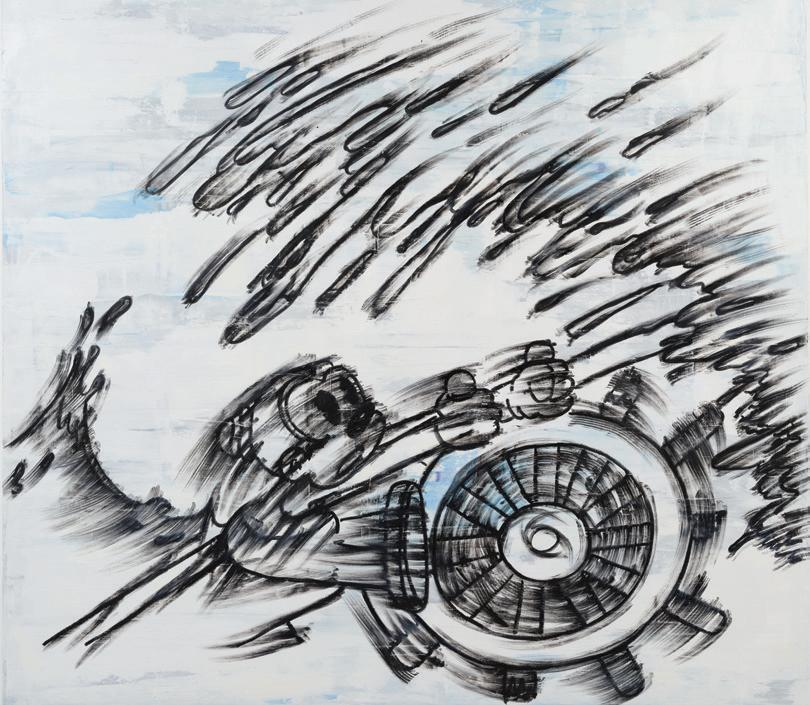Worth the risk?
By MICCO CAPORALE p. 14


















03 The To-Do Rock ’n’ roll photography and other events
06 Street View The SAIC yearly fashion show delights.
32 Reid | Rhino The city’s oldest fringe theater festival returns with over 40 shows in four venues.

34 Doug Adams The local author reflects on working with composer Howard Shore and writing The Music of the Lord of the Rings Films
48 Secret History of Chicago
Music Jazz bassist Cleveland Eaton
NAME) @CHICAGOREADER.COM
CEO AND PUBLISHER SOLOMON LIEBERMAN EDITOR IN CHIEF SALEM COLLO-JULIN
PRODUCTION MANAGER KIRK WILLIAMSON
SENIOR GRAPHIC DESIGNER AMBER HUFF
THEATER AND DANCE EDITOR KERRY REID MUSIC EDITOR PHILIP MONTORO
24 Cra Work Chelsea B fuses crochet and streetwear.

36 Movies of Note Fast X scales bigger and campier heights; The Little Mermaid is gorgeous but nothing new; and more.
08 Sula | Natural wine Logan Square’s Middle Brow Beer is now a winery, naturally.

10 Cover Story | Worth the risk?
A queer erotica screening and its fallout
18 Living There’s lead in the pipes and ways to help mitigate the risk while drinking Chicago water.
20 Filter guide A price guide to recommended water filters
22 Joravsky | On Politics Mayor Johnson gave himself an A.
23 Isaacs | On Culture The latest on the fate of the Thompson Center
26 Books Julia Fine’s latest is a dark literary fantasy.
28 Profile Oscar Arriola brings his sticker club to CAKE.
29 Exhibitions of Note Reviews of shows at the MCA, Ruschwoman, Haynes Court, and more
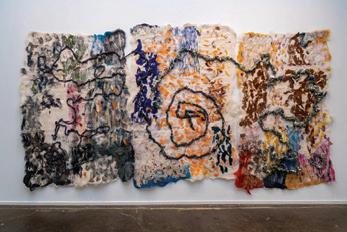
30 Inicios CLATA’s festival offers a new incubator for Latine playwrights.

38 Chicago Blues Festival A Q&A with Born in Chicago directors Bob Sarles and John Anderson, plus stories on artists Smiley Tillmon, Dave Herrero, and Sugar Pie DeSanto, and a profile of longtime blues busker Brian Doroba


46 Chicagoans of Note Ambient musician Gray Schiller, founder of StretchMetal
52 Shows and Records of Note
Previews of concerts by Stuck, the Texas Rubies, Sampa the Great, and others, plus reviews of new releases by Jayda G and Khanate
56 Early Warnings New concerts and other updated listings
56 Gossip Wolf Wild Prairie Vinyl & Vintage announces closure, DeBons-en-Pierre drop a creepy new dance EP, and more

58 Jobs
59 Marketplace OPINION
60 Comics
62 Savage Love
Red
Artists James Hosking and Maria Villaseñor-Marchal at Chicago Artists Coalition
James Porter pays tribute to singer Eric “Shoutin’” Sheridan
Street dance at Salt Shed
CULTURE EDITOR: FILM, MEDIA, FOOD & DRINK TARYN ALLEN CULTURE EDITOR: ART, ARCHITECTURE, BOOKS, LITERARY ARTS KERRY CARDOZA ASSOCIATE EDITOR AND BRANDED CONTENT SPECIALIST JAMIE LUDWIG SENIOR WRITERS LEOR GALIL, DEANNA ISAACS, BEN JORAVSKY, MIKE SULA STAFF WRITERS DEBBIE-MARIE BROWN, KATIE PROUT
LISTINGS COORDINATOR MICCO CAPORALE COPY EDITOR AND DATA
ASSOCIATE SKY PATTERSON
VICE PRESIDENT OF OPERATIONS ANN SCHOLHAMER CHIEF DEVELOPMENT OFFICER DIANE PASCAL DIRECTOR OF PEOPLE AND CULTURE ALIA GRAHAM
DIRECTOR OF MARKETING VIVIAN GONZALEZ MARKETING PROJECT STRATEGIST SHAWNEE DAY NEWSLETTER ASSOCIATE CHASITY COOPER
DEVELOPMENT ASSOCIATE MICHAEL THOMPSON TECHNOLOGY MANAGER ARTURO ALVAREZ OFFICE MANAGER AND CIRCULATION
DIRECTOR SANDRA KLEIN
DIRECTOR OF CHICAGO INDEPENDENT MEDIA ALLIANCE (CIMA) SAVANNAH HUGUELEY
SENIOR VICE PRESIDENT OF GROWTH AND STRATEGY AMBER NETTLES
VICE PRESIDENT OF SALES AMY MATHENY SALES TEAM VANESSA FLEMING, TIM OGDEN, WILL ROGERS
DIGITAL SALES ASSOCIATE AYANA ROLLING MEDIA SALES ASSOCIATE JILLIAN MUELLER
ADVERTISING
ADS@CHICAGOREADER.COM
CLASSIFIEDS: CLASSIFIEDS.CHICAGOREADER.COM
NATIONAL ADVERTISING VOICE MEDIA GROUP 1-888-278-9866 VMGADVERTISING.COM
JOE LARKIN AND SUE BELAIR
DISTRIBUTION CONCERNS distributionissues@chicagoreader.com
312-392-2970
READER INSTITUTE FOR COMMUNITY JOURNALISM, INC.
CHAIRPERSON EILEEN RHODES
TREASURER REESE MARCUSSON
SECRETARY KIM L. HUNT
DIRECTORS ALISON CUDDY, DANIEL DEVER, MATT DOUBLEDAY, VANESSA FERNANDEZ, TORRENCE GARDNER, ROBERT REITER, CHRISTINA CRAWFORD STEED
READER (ISSN 1096-6919) IS PUBLISHED BIWEEKLY BY THE READER INSTITUTE FOR COMMUNITY JOURNALISM 2930 S. MICHIGAN, SUITE 102 CHICAGO, IL 60616
312-392-2934, CHICAGOREADER.COM
COPYRIGHT © 2023 CHICAGO READER
PERIODICAL POSTAGE PAID AT CHICAGO, IL ALL RIGHTS RESERVED. CHICAGO READER, READER, AND REVERSED R: REGISTERED TRADEMARKS ®
Rest in power to the King of Blackabilly
Bull Dance Your Style brings the national spotlight to Chicago
facebook.com/thaifoodfestivalchicago
Lubchansky maintains a popular Twitter presence at @Lubchansky.
Warming temperatures mean it’s time to get out there and strut. From book signings to variety shows, there’s something coming up for everyone’s walking speed.

The Humboldt Park-based production company and microcinema Sweet Void Cinema (3036 W. Chicago, Suite 1W) collects shorts from local filmmakers and screens them monthly as a recurring festival. In June, screenings will happen on several Saturdays (6/3, 6/10, and 6/17) as well as Wednesdays (6/7, 6/14, and 6/21). Each screening day, 24 films are divided between three blocks that start at 5 PM, 7:30 PM, and 10 PM. This month’s batch includes titles like Hell INC , Balloons Overhead (instrumental) by [ ], and “(ಥ ಥ) ✧_My parents are cia PSY0PS_!!!* ಠ ಠ.” These events are free and open to the public, but masks are required. Don’t sweat if you forget, though; the venue will happily provide one. sweetvoidcinema.com
An exhibition of renowned French rock ’n’ roll photographer Richard Bellia’s work is opening in June at the Rangefi nder Gallery at Tamarkin Camera (213 W. Institute Pl., #403). Bellia began taking pictures in 1980 and has made a career of working mostly in silver gelatin, an analogue process that produces black-and-white photos. Early subjects included Don Letts, Henry Rollins, and Siouxsie. To get a first look, mix and mingle at the opening reception from 5-8 PM on Fri 6/2. From 5-8 PM on the following Friday (6/9), Bellia will be giving an artist’s talk—but if you’re serious about going, get there early to guarantee a seat. Space is limited to 30 people, and there is a $25 suggested donation for the event. To see the show outside these hours, appointments are available Monday through Friday and can be made through Tamarkin’s website. tamarkin.com/leicagallery
On Sun 6/4 at 7:30 PM, Chicago’s interga-
lactic funk DJ Zeetus Lapetus debuts Art Haus , their new variety show at Schubas (3159 N. Southport). Each installment features members of local creative communities performing pieces as, or inspired by, characters from iconic movies. For Art Haus’s fi rst installment, the cast will pay homage to the archetypal characters of The Breakfast Club Lapetus will play Vice Principal Vernon, “the dick.” Rock ’n’ roll noisemakers Heet Deth will perform as Bender, the “criminal.” Postpunk soul soldiers Orisun will play Allison, the “basket case.” Genre-bending sister duo Lilla Sol will play Claire, the “princess.” Drag artist Flaming Homosexual plays Brian, the “brain.” And club DJ Julian Forever plays Andrew, the “athlete.” Tickets are $13 ($10 in advance) and available to those 18+. lh-st.com
Are you a budding Lenny Bruce, Mrs. Maisel, or Gallagher? Then you probably know Cole’s (2338 N. Milwaukee) is a great—and free!—place to cut your comedy teeth. Do you also know that Cole’s legendary Wednesday night open mikes now start earlier? You used to have to arrive as early as 5 PM to crack the 8:15 PM start of sign-up just for a chance to perform before midnight. Woof! Sign-up time now starts an hour earlier at 7:15 PM,
with performances kicking o at 8 PM. And if that still doesn’t get you in before midnight? See if bringing brisket helps . . . The next weekly Comedy Open Mic happens Wed 6/7. And sorry, you must be 21+ to hang at Cole’s. colesbarchicago.com
However, you can be any age to hang at Corbett vs. Dempsey (2156 W. Fulton). At 2 PM on June 10, the gallery hosts a conversation between Brent Hayes Edwards and Henry Threadgill, one of the most important living voices in Black avant-garde music. The pair will be joined by jazz critic Howard Reich to discuss Threadgill’s new memoir, Easily Slip into Another World: A Life in Music, which the pair worked on together. This event is free. corbettvsdempsey.com
You can also be any age to enjoy Thai Festival Chicago , which is presented by the Thai American Association of Illinois. It’s happening Sat 6/10 and Sun 6/11 at the Thorek Hospital Parking Lot (851 W. Irving Park). While this event is technically free, there’s a $5 suggested donation—but is that really a lot to pay to bask in the tastes and traditions of Thailand? Over 30 vendors from Chicago’s Thai community will be present, including food and drink vendors sure to become your next go-to for takeout.
Also happening Sun 6/11 is Soil Stories , a volunteer-based gardening event in North Lawndale. This will be the fi rst of two such events led by Advocates for Urban Agriculture (AUA), a nonprofit that focuses on sustainable agriculture and environmental justice. Join AUA at African Heritage Garden (1245 S. Central Park), where Dr. Shemuel Israel will guide participants through an “embodied garden tour,” inviting visitors to use all their senses to appreciate herbs and produce grown throughout the garden. Then Dr. Akilah Martin will lead a reflection ceremony and teach participants about soil health and reciprocity. To close out the day, everyone will work together to give back to the garden as service work to the earth. Soil Stories happens from 1-3 PM. Reservations requested at Eventbrite. rb.gy/3ihdw
Beloved cartoonist, political satirist, and Twitter personality Mattie Lubchansky will be in the Windy City this month to promote their new graphic novel, Boys Weekend. Publisher Penguin Random House says that the book is “a hilarious trans ‘fi nal girl’ horror graphic novel about a bachelor party gone very, very wrong.” At 6 PM on Mon 6/12, Harold Washington Library Center (400 S. State) hosts a conversation between Lubchansky and local cartoonist and CHIRP Radio cofounder Tony Breed. This event is free and open to the public. If you can’t make it, there’s still hope: At 6 PM on Tue 6/13, Lubchansky will also be in conversation with local cartoonist Sage Coffey at Challengers Comics (1845 N. Western). This event is also free and open to everyone, so bring someone cool! bitly.ws/FRUw
Bridgeport’s Digital Art Demo Space, known more a ectionately as D.A.D.S. (2515 S. Archer, Suite 2), is one of the premier spots to catch boundary-pushing new media in the city. They’ve hosted some bananas music performances recently, so my hopes are high for DataNET, two nights of adventures in deeply digital music happening Fri 6/16 and Sat 6/17. Night one includes xtkakeru, Runk, Ikra, Zimbolt, Narwall, and im_naku, while night two features Fyzika, Mayor of Texas, Sayori, Schwank, Avas, and SushiFerret. Each night kicks off at 7:30 PM and costs $20 ($15 in advance). Tickets can be purchased at the door or online. dadschicago.com/tickets v @JuggaloReporter

In 2019 the Illinois Lottery launched a new Instant Ticket to raise money for agencies and organizations that support people experiencing homelessness and housing insecurity throughout the State. The Illinois Lottery gives 100 percent of profits from the ticket to the Illinois Department of Human Services (IDHS), which then utilizes funding for a grant program that distributes grants to nonprofit organizations throughout Illinois through their Homeless Prevention Program, Supportive Housing Program, and Emergency & Transitional Housing Program. To date, the ticket has raised $4.7 million dollars to help some of Illinois’s most vulnerable residents. This year’s tickets combating homelessness and housing insecurity is called Blackjack and will be released on June 6th. The ticket costs $2 and is available at more than 7,000 Illinois Lottery retailers statewide. With its fun casino-themed design, the Blackjack Instant Ticket makes a great gi for those 18 and up. Visit the Illinois Lottery website for more information about Blackjack and other specialty tickets.
In January 2020, the Department of Housing and Urban Development (HUD) published their 2019 Annual Homeless Assessment Report to Congress. Among their findings, they revealed that approximately eight out of 10,000 people living in Illinois were experiencing homelessness, of which 18.5% were currently unsheltered.
Just weeks a er the report was released, the COVID-19 pandemic hit the United States. The mounting health-care emergency, dramatic loss of jobs (one in seven, according to Illinois Policy), and reduced access to social support services threatened the housing security of thousands of Illinoians while worsening conditions for many who were already experiencing homelessness. That spurred organizers, activists, and community members across the state into action.
The City of Chicago is one of Illinois’s 19 Continuum of Care jurisdictions as designated by the Department of Housing and Urban Development (HUD). Within that continuum of care, member organizations can receive funding from the Illinois Department of Human Services (IDHS)—including money raised by the Illinois Lottery’s specialty tickets—for community-wide efforts to reduce homelessness, support those fleeing sexual and domestic
violence, minimize trauma, and empower those experiencing homelessness to be more self-sufficient.
In Chicago, the center of that crucial work is All Chicago Making Homelessness History, a nonprofit organization that seeks to eradicate homelessness by uniting community members with resources through four areas of focus: managing funds for emergency financial assistance, forging partnerships with fellow organizations, providing training and research, and collecting and analyzing data about people experiencing or at risk of homelessness and the impact of the services they receive. “We’re like the lead backbone agency for bringing all stakeholders together that are working on this issue to make sure we’re all taking steps forward in the same direction and at the same time,” says All Chicago’s vice president of community services Nicole Bahena.
All Chicago works with more than 100 partner organizations to support individuals and families experiencing or at risk of homelessness. “People call 311 to ask for shortterm help, and then they’re routed to the Homeless Prevention Call Center, which does a screening to make sure they’re eligible,” Bahena says. “Then they’re connected with a partner of All Chicago that does the paperwork and the case management. Then we vet everything and then cut the checks to the third-party vendor.”
Bahena says that coupling financial support with case management is among the best practices for homeless prevention funding. “[We’re] not just saying, ‘OK, here’s your one-time check—hopefully you don’t ever become homeless,’’’ she says. “We have partner agencies that serve as that sort of ongoing care [team] for them. If the check helps, but they stumble again, or they need other types of wraparound services, those case managers provide that extra level of support.”
In the early stages of the pandemic, All Chicago received $35 million in federal funding to support their efforts. Working with their network of partners, the organization was able to help rehouse 1,888 households within an 18-month span. Building off that success, they launched
an initiative where they work with a group of 600 landlords to help find affordable housing units. “That was like a huge win that is sticking around even now that some of the COVID funding is drying up,” Bahena says.
Additionally, All Chicago created a series of moving events across the city, where landlords showcase their units virtually, and prospective tenants can apply for housing, get approved for a unit, and select furniture on site. “All these steps used to take about 90 days because trying to find an apartment is difficult,” Bahena says.
While the emergency phase of the pandemic has somewhat subsided, homelessness remains an ever-present emergency. “There’s still this incredible need for housing,” Bahena says. “We have new resources coming in all the time, but they just make small dents in the need. What we don’t have control over is how to turn off the faucet of new people becoming homeless. That’s because homelessness is the end result of around 15 failed systems.” Citing societal issues such as racial inequity and the nationwide affordable housing crisis that no one agency can solve on their own, she says the organization remains focused on how to provide crisis support and prevent people from experiencing homelessness whenever possible.
That makes the funds raised by the Illinois Lottery’s Homelessness specialty ticket as vital as ever. Beyond purchasing a ticket, Bahena recommends considering making a donation to All Chicago or one of their many partners; many of their partner organizations also have volunteer opportunities where people can get involved with direct support. To stay updated on the issue, you can sign up for All Chicago’s newsletter at allchicago.org. And if you or someone you know is in need of shelter or other immediate crisis support, please call 311, or contact one of All Chicago’s partners, some of whom are listed below.
AIDS Foundation of Chicago
312-690-8860
aidschicago.org/page/i-need/housing
Provides case management services, including support for permanent supportive housing, senior housing, and utility assistance.
Help support individuals experiencing homelessness or housing instability with your purchase of a “BLACKJACK”This sponsored content is paid for by Illinois Lottery
Catholic Charities of the Archdiocese of Chicago
312-655-7700
catholiccharities.net/homelessness-prevention/housing-access
Homelessness Prevention services include a housing access program, veteran services, and wraparound support.
Center on Halsted
773-472-6469
centeronhalsted.org
With a focus on the LGBTQIA+ community, the Center on Halsted helps connect young people with housing through their Youth Housing Initiative and provides housing support resources, among other services.
Chicago House
773-248-5200
chicagohouse.org
Provides housing and resources for low-income individuals and families who have experienced chronic homelessness or unstable housing and are living with or vulnerable to HIV.
Cornerstone Community Development
773-271-8163 ext. 0
ccolife.org
CCD provides shelter for single women, single men, and families, as well as casework, meals, a food pantry, and a “free” store with donated clothes, baby supplies, and household items.
Deborah’s Place
773-722-5080
deborahsplace.org
Provides permanent and interim housing for women, community-based housing programs, and Dolores’ Safe Haven, which supports women with severe mental illness who are experiencing homelessness.
Facing Forward to End Homelessness
773-265-1207
ffchicago.org
Supports families and individuals experiencing homelessness, as well as providing education, advocacy, and social services.
Inspiration Corporation
773-878-0981
inspirationcorp.org/housing
Provides rental support and wraparound supportive services to individuals and families experiencing homelessness.
North Side Housing and Supportive Services
773-244-6401
northsidehousing.org
Provides shelter, housing, and healing to Chicago’s most vulnerable individuals.
Primo Center for Women And Children
773-722-0544
primocenter.org/about-us
Provides shelter and supportive services, including health care and early childhood development for families experiencing homelessness.
Sarah’s Circle
773-728-1991
sarahs-circle.org
Provides housing and supportive services for women experiencing homelessness.
The Night Ministry
773-784-9000

thenightministry.org
Provides connection, housing support, and health care to unhoused Chicagoans and community members experiencing poverty.
The Thresholds
773-572-5500
thresholds.org/programs-services/housing-and-homelessness/homeless-outreach
Provides outreach services and support for those living with mental illness and experiencing homelessness to help them find support and regain control of their lives.
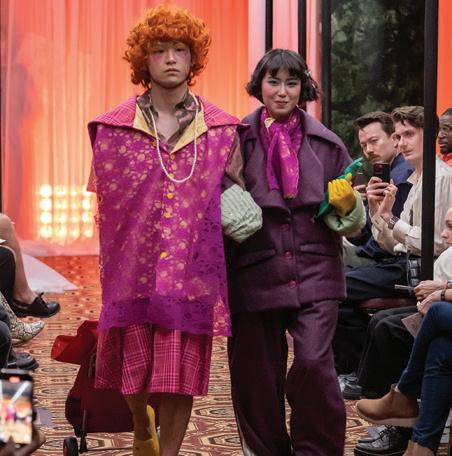
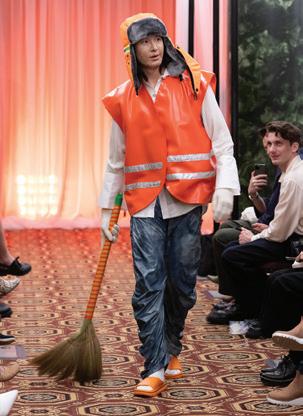

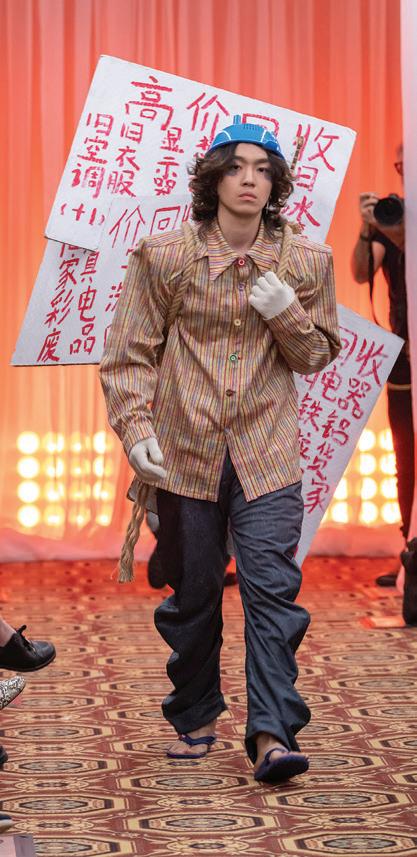 By ISA GIALLORENZO
By ISA GIALLORENZO
Attending a School of the Art Institute of Chicago fashion show is never boring.
The raw talent of the senior undergraduates is a jolt to the senses. Sometimes they use way too much fabric, other times not enough. But what they all have in common is an invigorating amount of creativity—a touching eagerness to think outside the box.
This year, there was also a lot of vulnerability coming down the runway since the overarching theme was “Intrinsic Being.”
“I felt the designers’ desire to shift towards visualizing an inward perception, a personal inward focus outward through fashion,” said Katrin Schnabl, the Sage Foundation chair in fashion design and professor in the department of fashion design at SAIC.
“There was delicacy, tenderness, openness, and utilizing fashion as an opportunity for ‘showing up’ from a vulnerable perspective or lens, more porous, more light, fragile, delicate. There was an adjacent conversation about disability and mental health and presenting directions of how we can show up in partnership, care, and recognition. Furthermore, I enjoyed the connections that students made to their family heritage,” Schnabl added.
As has been the case over the past few years, there was a welcome diversity of models on the catwalk. Student Ali Kushner included models of various ages, sizes, and also in wheelchairs. Kushner’s collection, cleverly titled “Excessibility,” addressed the paradox of excessive amounts of clothing coexisting with a lack of accessibility in fashion. Kushner utilized spare fabrics given by friends and classmates and created designs filled with vibrant colorful patchwork, which is currently very on-trend.
Also on-trend and bright was Tianyuan (Sky) Shi’s collection, featuring an “urban village” composed of stylish blue-collar characters. Shi utilized nonmodels who interacted as if they were going about their usual business, bringing a lively and unexpected dimension to the show. Another highlight was the ethereal collection by Ruoqi (Rever) Li, which was inspired by jellyfish and their transient existence.
The show culminated with fantastic sculptural flower gowns by Eric Garcia, who employed inordinate amounts of boning to support the petals he fashioned out of plastic mesh and silk organza. Garcia went through an intense process while creating his designs, which were inspired by the flowers he brought to his mother when she was in the hospital. “[Making this collection] felt terrifying, empowering, hopeful, and therapeutic—most of all, it felt grueling! I got to a point where these dresses couldn’t fit under the sewing machine, and so everything had to be handsewn,” Garcia said.
Garcia sprinkled the gowns with liquid rubber “to give the garments a slightly battle-worn look, as if the models were emerging out of this dark swamp of fear and into the light,” as he explained in the show catalog. In the future, Garcia hopes to keep making showstopping garments: “Bigger gowns, as big as 18-wheeler semitrucks. I want to be in the Guinness Book of Records for the world’s biggest gown,” he said. Next stop: the Met Gala.
Read interviews with Eric Garcia and SAIC associate professor Anke Loh at chicagoreader.com. v
@chicagolooks
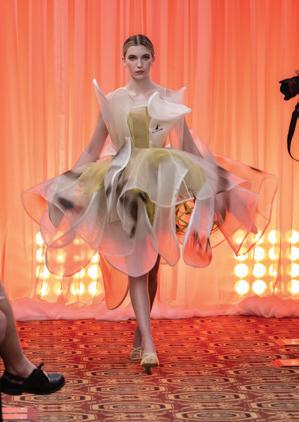

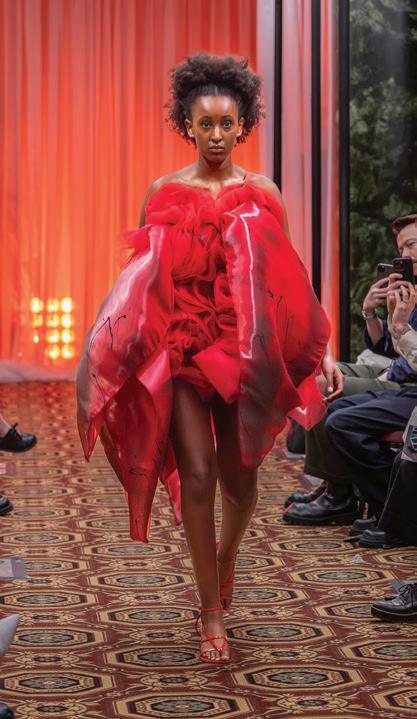

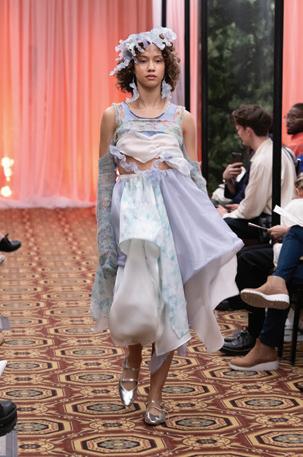



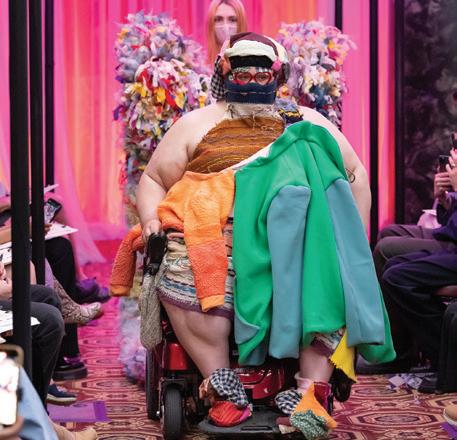
Chicago food and drink content at chicagoreader.com/food.
Pete Ternes and Bryan Grohnke’s quiet, low-intervention experiments have borne extraordinary fruit.
By MIKE SULAMiddle Brow’s Pizza Wine has the dark ruby-red color of a Napa Valley cabernet sauvignon, like something you’d want to drink with a thick porterhouse: jammy, tannic, boozy.
With that on your mind, your first sip might come as a surprise. Sure enough, it has a rounded, full body, but it’s simultaneously ethereal, with a bit of fizz. At around 11.5 percent alcohol it’s not particularly boozy, and there’s not a hint of tannic astringency because, despite its color, the juice had practically no skin contact when the grapes were
pressed.
It tastes like something you could drink all day. It’s fruity and light, and you might need to resist the temptation to gulp it all down before one of those toasty, sourdough Middle Brow pizzas even hits the table.
What it really tastes like is a Lambrusco—a quintessential pizza pairing—but it’s made with none of the old-world grapes that make up that northern Italian wine. In fact, it’s a fermented blend of juice pressed from three hybrid grape varietals grown right here in the midwest—on farms near Traverse City and Saugatuck, Michigan.
Pizza Wine is one of some nine new wines Middle Brow partners Pete Ternes, Bryan Grohnke, and Polly Nevins will release this year, now that they’re officially licensed to make, sell, and distribute it from Bungalow by Middle Brow Beers. Last September, Ternes and Grohnke appended the word “Wines” to the brewery’s name, when they’d hit the point of no return in the midst of a three-year application process that required them to switch their brewpub license to a brewery manufacturing license, and acquire three separate permits from the state Liquor Control Commission to make and sell wine.
Along with brewer Ed Brady, they started experimenting with what the wine world amorphously labels “natural wine” in early 2019, not long after they abandoned their original goal of setting up permanent residence on a self-sustaining farm, instead opening Bungalow in a former camera shop in Logan Square.

Before that they’d spent more than seven years as nomadic contract brewers, making uncommon, experimental, and iconoclastic beers in reaction to the bitter, hoppy hegemony of the IPA-dominated craft beer world.
“We loved wild beer,” says Ternes. “We wanted to let yeast do its thing and accidentally make cool beers because we were bored of IPAs and red ales. We were trying to accidentally make a cool tasting beer, and then backtrack and figure out what we did to make it again.”
By the time they finally settled down and began building out Bungalow in 2018, their beer didn’t seem so weird anymore, particularly after they’d got a taste of the natural wines that were then peaking as an insurgent trend within U.S. viniculture.
“Natural wine” in the modern sense is a poorly defined concept, but it’s nothing new. People have been making wine with nothing but indigenous yeast and grape juice for thousands of years. A more illustrative term is low-intervention wine, ideally using grapes farmed with no pesticides and herbicides. Within the cellar it’s simply about allowing yeast and juice to ferment into wine, eschewing the myriad manipulative techniques and additives that humans have employed over the centuries to produce consistent, predictable wines.
It’s also often a roll of the dice. It can yield spectacularly unpalatable results or extraordinarily delicious, unexpected, and often funky ones—not unlike some of the wild and weirdly fermented beers that Middle Brow brewed.
“When we tasted our first natural wines, we were just blown away,” says Ternes. “We were putting our noses into a glass of wine and smelling some of the lacto funk and barny fruit you’d get in a beer. You’d have a really full-bodied wine that was light as hell. You could drink three glasses of it and it didn’t feel like anything. These were wines that were super fruit-forward and acidic and alive and fun.
“It made us think, ‘Can we make an accidentally cool wine?’ Can we get chardonnay, and make something that didn’t taste like other chardonnays? Something that highlighted some other elements of the chardonnay grape?”
A handful of low-intervention wines from other winemakers have always been on the menu at Bungalow, but Ternes and Grohnke’s first foray into making their own resulted in not a wine, but a beer. In 2019, just ahead of the third annual Third Coast Soif, the local festival celebrating low-intervention wine, beer, and cider, the partners got ahold of some rosé from Sonoma County winemaker Evan Lewandowski, which they blended with their own Belgian-farmhouse-style grisette Miner. They sold most of it at the festival but didn’t think it was a successful experiment at the time, since they noticed that some of the leftover began to lose its luster over time.
But still, the contacts they forged with other natural winemakers were encouraging. “We said, ‘Let’s get involved in a harvest and pick the grapes and try to make some blends,’” says Ternes. “That’s when we started learning, and decided to start experimenting with the view to learn how to make wine at some point.”
They spent three days picking and pressing grapes with Sebastopol, California, winemaker Martha Stoumen during the 2019 harvest. They brought back about 300 gallons of unfermented Negroamaro grape juice and attempted another beer blend. This time they used a freshly brewed, unfermented pilsen-style wort, and instead of pitching brewer’s yeast, allowed the indigenous yeast from the grape juice to kick-start fermentation. It was a fruit
R
BUNGALOW BY MIDDLE BROW BEERS AND WINES 2840 W. Armitage, 773 -687-9076 middlebrowbeer.com
@middle_brow_beers_and_wines
The Lambrusco-tasting Pizza Wine, a honeyed Gewürztraminer called Pollen, and other new Middle Brow wines JEFF MARINI FOR CHICAGO READER

bomb at first, but it gradually separated “like oil and water,” and eventually developed a dry champagne-like character.
They had more success positioning buckets of the raw juice in di erent levels of the brewery, allowing them to ferment at di erent temperatures, just to see what would happen. “We let it get way too hot on purpose,” says Grohnke. “We just wanted to let it free rise, not touch it, and see what would happen.” Some of the resulting wines were undrinkable, but a few were good enough to bottle and drink on their own.
The next year they’d ordered 300 gallons of cabernet rosé from Richmond, California, winemaker Les Lunes and learned a hard lesson. Because they were using some of their brewing tanks to ferment, they didn’t have a tight control over oxygen permeating into the juice, and it developed the mysterious and dreaded mousiness, a flaw common in natural wines that results in a repellent o taste that can’t be detected on the nose. Still they held onto some of it, and after time the problem mitigated itself in the bottle, and it eventually became drinkable. “We’ll likely sell it this year, in a shocking twist to us,” says Ternes. “You look at all the variables on either side of fermentation. Like what happened with the mousiness? Well, it could have been these five or seven things. So now the next year, let’s try and change those five to seven things.”
The partners engaged in these experiments quietly, increasing the amount of juice they’d shipped from California with each harvest, scaling up from buckets to tanks, and playing with time and temperature. “The first two years were bad,” says Grohnke. “A lot of wine was going down the drain. But it was still valuable to us. It was a learning lesson. We were just having fun while figuring out how to do this. We went into it almost expecting to throw some wine down the drain, or maybe let it turn into vinegar for the kitchen.”
“They were just small quantities we’d mess around with,” says Ternes. “We tinkered with it and tasted it as it became wine, and the next year we tried a di erent varietal, and we kept doing that. Lessons in wine are yearlong lessons. You can’t just do it again the next week or the next month. You gotta wait a year. So we thought, ‘Let’s start tinkering and learn the lessons now. We know this is going to take us
half or more of a decade before we’re doing it well. We’ll try it now and learn those hard lessons early.’”
As the pandemic eased they spent a few days of the 2021 harvest in Mendocino, California, with winemakers Shaunt Oungoulian and Diego Roig of Populis and Les Lunes and brought back 600 gallons of juice from zinfandel rosé and chardonnay grapes.
But ever since they made a wine-forward beer with a hybrid white varietal called Frontenac gris, sourced from Illinois Sparkling Company in downstate North Utica, they’d been thinking about what they might do with grapes grown closer to home. “That kind of inspired us to start digging into Michigan a lot more,” says Ternes. “Learning about what generally grows well in Michigan, in those soils at that latitude and with that climate. If we were going to become a winery, we wanted to do it with fruit that surrounded us.”
It’s only in the last half decade or so that midwestern wine has begun to shed its rep as overly sweet swill pressed in service to a captive Lake Michigan tourist economy. “Everything tastes good on vacation,” says Andy Pates, cofounder of Chicago distributor Cream Wines & Spirits. “But when you come back home, the wine also has to taste good.”
Cream has championed what Pates calls the “Michigan Wine Movement,” collecting five wineries in its portfolio making high-quality “wines of place,” on the Mitten. “Smaller producers from Michigan are making wines that you can put into a blind tasting or travel to other parts of the country with and say,
‘This is a wine from my region,’ and it certainly stands up,” he says. These range from the “grandfather of the movement,” James Lester of Pullman’s Wyncroft Wine, who makes classical wines from old-world varietals like chardonnay, pinot noir, and Blaufränkisch, to Andrew Backlin of Fennville’s Modales, a low-intervention producer who makes a red blend that includes a hybrid red varietal called Marquette, introduced by the University of Minnesota in 2006.
Hybrid varietals like this are distinct from the old-world vitis vinifera grapes that produce the majority of wine drunk around the world. In some ways they’re more suited for farming in the midwest than familiar varietals like Riesling and chardonnay. They’re cold-hardy, and pest and disease resistant, and they thrive in the midwest with fewer inputs. Plus they o er winemakers a whole new palette to explore. “A lot of people are shocked by how di erent they are,” says Ternes. “If you aren’t so hung up on your tongue’s definition of wine, these are really good wines.”
Since the 2019 harvest Middle Brow has made wine with chardonnay, pinot noir, and Gewürztraminer from Michigan, but also with lesser-known hybrids like Vignoles and Chambourcin. Pizza Wine is a blend of Marechal Foch, Frontenac, and Noiret grapes.
When they started hitting their stride, Ternes and Grohnke would occasionally break out an experimental bottle for friends and regulars at Bungalow. “We’d just pour a little into a glass, let them drink it, and watch,” says Ternes. “Their eyes would light up, and they
would ask for more.” Without proper licensing, they couldn’t legally sell it or advertise it, but word got around, and people started asking for it.
“That’s when we confirmed that we weren’t crazy,” he says. “‘This is good. Let’s get this thing permitted and do it.’”
Last week Middle Brow’s licensing was finalized, and on Friday they hooked up a keg of a lightly oaked chardonnay to their draft system and started pouring. This week they’ll introduce Pizza Wine and a honeyed Gewürztraminer called Pollen by the glass, can, and bottle. They’ll follow those up with Cook Out, a sparkling California zinfandel rosé, and a sparkling chardonnay called Float in cans.
All told they’re sitting on about 600 cases and some 50 kegs of wine, enough to last the rest of the year. By then they’ll be fermenting juice from the 2023 harvest, for which they’ve contracted with farmers for about 5,000-6,000 gallons, up from 2,000 last year.
Greater volume will allow more control over the juice they’re buying. Ternes says that while most of the farmers they’re buying grapes from are skeptical of organic or biodynamic farming practices, he hopes that as Middle Brow negotiates larger contracts for juice, they can be convinced to stop spraying portions of their vineyards.
Ternes and Grohnke are also looking forward to playing with extended maceration, which increases skin and seed contact with the juice, allowing for greater color, flavor, and tannin structure.
Working with wine has also reawakened an early dream for the partners. They’ve been aggressively seeking out property in Michigan to open another pizzeria and winery, along with a custom crush facility that would allow fledgling producers to juice their own grapes and make their own wine.
Ultimately Ternes and Grohnke will become farmers, and Middle Brow a vineyard. “The learning process is only just beginning,” says Ternes. “There’s a self-su ciency in that that feels satisfying to whatever caveman is in my soul. The dream behind the brewery was beer but also a winery and orchard and all the dairy we wanted to utilize for our pizza.”
@MikeSula
 PORN AND COMMUNITY
PORN AND COMMUNITY

Fallout from a queer erotica screening at Sleeping Village exhibits how far cultural institutions still have to go to support the entire LGBTQ+ community.


 By MICCO CAPORALE
By MICCO CAPORALE
To understand queer cinema one needs some appreciation of its relationship to low-budget, underground filmmaking, especially one particularly maligned approach within that category: pornography and X-rated movies. Not only do these works o er some of the earliest examples of queer life and desire committed to film by and for the LGBTQ+ community, but they also represent historic debates about acceptable sexuality and social attitudes and how they should be regulated. More often than not, such debates and ensuing regulations have resulted in the systemic censorship of queer expression and communing. As a recent upset at Sleeping Village reveals, those conversations continue in cultural spaces today, even in a city that’s largely resisted b eing influenced by a growing national wave of homophobic legislation.
It was a drizzly Monday night in January when more than 200 people packed into the private viewing area of Sleeping Village for a
night of erotic queer movies. The event was organized by Seen, a three-person fi lm collective from Milwaukee making its Chicago debut. With just one more screening scheduled a month later, the trio had been given a throwaway night in winter to test Chicago’s appetite for gay indie fi lmmaking. Little did anyone expect that the screening would attract double its anticipated audience—and result in the cancellation of subsequent screenings.
“What does it mean to be Seen?” filmmaker and founding member M.O. Guzman asked the crowd before reading the group’s manifesto from the stage. “We reject the standardized system of images; the pacification of the marginalized through the notion of representation as a path to liberation; the exploitation of makers through paywalls, regulations, and conformity; and the censorship of queerness and sexuality. . . . We do not have to explain ourselves to fit within the lens of cishet white supremacist patriarchal structures, nor do we need validation
from them for the ways we choose to defi ne ourselves. . . . We are a coalition to build a foundation for the rise of the cinematic gayz.”
The lights dimmed across a cheering audience, and for the next hour and a half, people weathered su ocatingly tight quarters and multiple technical difficulties to enjoy five XXX shorts sourced from varying intersections of the queer underground. Called “Filth!,” the series had been two months in the making, and its fi rst date was so successful that Sleeping Village’s then-booker, Kyle LaValley, reached out to Seen the next morning to float the possibility of two more—on top of a second screening already scheduled for February 20.
Within a week, though, the series was canceled, and it quietly disappeared from Sleeping Village’s website. Mid-February, the club made its fi rst public acknowledgement of the cancellation: a single Instagram story that read, “Due to its x rated materials this event is being moved, location tba.”
But it also said: “Please follow our friends

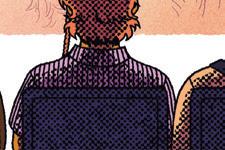
at @seenmke for updated information on the Feb 20 Filth! event and support their upcoming screenings!” The last line matches LaValley’s tone throughout her correspondences with Seen. She was magnanimous in welcoming the collective, and when ownership decided to cancel the screening (a move she called “DUMB!” in emails Seen provided to the Reader), she connected Seen with several other Chicago venues, hoping the series could fi nd a new home. It did. At the eleventh hour, the collective was embraced by Epiphany Center for the Arts—and only saw half the turnout of its initial screening.
The saga of “Filth!” at Sleeping Village is a microcosm of festering disconnects—between venues and patrons, between owners and artists, between beloved institutions and queer Chicagoans—that begs the questions: How well do operators of cultural institutions understand LGBTQ+ patrons, and how does that influence their safety priorities? What will we do to protect freedom of expression and foster community for those who need it most?
Filmmaking is about community in a similar way to music. The art is most often made by a group, and it requires an audience willing to surrender to a durational audio-visual experience. Whole subcultures form around creators, approaches, and genres, and it’s popularly accessible. These were all loose elements that attracted Guzman to the medium, whose interest in queer fi lmmaking’s relationship to erotic cinema came much later. In 2019, all they wanted was to connect with queer filmmakers, period. That’s why they started Seen.
At the time, Guzman was a sophomore studying film at the University of Wisconsin-Milwaukee, and they were struggling to fi nd peers who understood queer issues and appreciated queer fi lm history. After making an experimental, diaristic work about gender expression through fashion, they were applauded by teachers and students. Unfortunately, the audiences demonstrably didn’t get it.
“It’s interesting,” Guzman explains, “because in film school, you don’t have too much say in who your audience is, right? It’s just whoever is also taking those classes, yet you’re supposed to value their feedback. To a degree, it’s a good system, but it was super weird presenting my piece to a room full of cis folks. Later on, people—like professors I hadn’t even met—would come up to me like, ‘Oh, you’re the one who made that fi lm!’ and be really excited about it, but then they would interact with me in ways that made it very clear they didn’t understand it. And they’d misgender me in the same conversation. I knew I needed a queer space to talk about fi lm.”
Guzman put feelers out in their department to fi nd their fi rst cohort. Over the span of four years, Seen’s membership has expanded and contracted, but currently it consists of three people: Guzman; cofounder Raina Garcia, who dropped out of fi lm school shortly after joining; and Samantha Peetz, who’s attending U of W now with a double major in fi lmmaking and gender studies. Each person’s unique relationship to fi lmmaking and academia influences the collective’s pursuits.
Because it started at a university, Seen’s fi rst event happened in a white-wall gallery space, but as its membership, ambition, and name recognition grew, the collective started programming in a wider variety of settings, including independent theaters,
art museums, DIY venues, and underground art spaces. Slowly, they started venturing beyond Milwaukee, too. In summer 2022, they transformed Blue Room, an alternative art space in Sheboygan, Wisconsin, into two queer teens’ bedrooms, complete with magazines, phones, and computers where visitors could comb through the teens’ lives via their social media. The program was called “Inside Again.”
“I think we were trying to understand our own relationships to forming queer connections through the Internet and what role subculture plays in that,” Guzman explains.
To underscore themes in the installation, Seen screened a handful of related shorts. Among them were Samuel Shanahoy’s So Long Suburbia (terminally online gay millennials may recall Shanahoy’s Tumblr sensation Skate Bitches) and Henry Hanson’s debut fi lm Bros Before. Hanson is a Los Angeles-born, Chicago-based fi lmmaker who’s programmed sold-out screenings of queer fi lms for both Facets and the Music Box. With a storytelling knack like a bratty trans Gregg Araki, Bros Before has become something of a cult hit in the queer fi lm community. As soon as the members of Seen met him, they felt like they’d found a kindred spirit.
While the films of “Inside Again” made the rounds in Milwaukee—including a stint at Cactus Club’s independent fi lm festival— Guzman and Hanson began entertaining a Chicago collaboration of some kind. Since 2020, Seen has been programming regularly at Cactus Club, a legendary independent venue in Milwaukee that often teams up with Sleeping Village to book shows. One thing Guzman likes about programming at Cactus Club (where they now work) is that it can be less rigid and more community-oriented than traditional film spaces. They describe attracting audiences who are queer, less invested in preconceived ideas of filmmaking, and more open to creative expression. Discussions often go to more surprising and fertile places.
With Cactus Club’s connection to Sleeping Village and Hanson’s connection to Chicago fi lmgoers, Seen felt ready to share their efforts with a bigger audience and more robust fi lm community. But how to make the most of the opportunity?
“Henry and I started talking about things we wanted to show and what we’d been researching,” Guzman says. “We just kept coming back to erotica and processing trauma through erotica. . . . I’m a big nerd, so I’d
spent the summer of 2021 reading a ton of film theory. I kept coming back to this one particular essay that emphasized how the queer fi lmmaking community played a huge role in educating people on safer sex during the AIDS epidemic. I was like, ‘How could I go through four-plus years of film school and this was never mentioned?’ Queer fi lmmakers were really important to protecting their communities, and I wanted to continue that tradition and help bring that history to light.”
Guzman was also interested in expanding screening opportunities for fi lmmakers exploring questions related to sex, as so much queer work does. In 2020, they’d made a short called Is This Liberation? that humorously grapples with their own questions about healthy sexual expression as a self-aware queer adult recovering from a strict religious upbringing and other childhood trauma. There’s even a Mothman cameo. Explicit footage is only a small part of the movie, yet every LGBTQ+ screening and festival Guzman submitted it to rejected it as “pornography.”
“There’s this push happening,” they say, “especially in queer spaces right now, to recognize queerness as not explicitly related to sex. I think that’s removed sex from the conversation. You go to LGBT screenings or festivals, and it feels very sanitized at times. I love that queerness can be seen as so multifaceted now. But I think it completely detracts from what the real issue is. Generally, the nonacceptance of queerness is a fear of—or disgust for, or whatever—queer sex. And so it seems to me that at present, there’s a lot of LGBT spaces that are afraid to still include sex in their programming.”
Guzman had been in loose contact with LaValley for about a year, but with Hanson on board and “Inside Again” wrapping, it seemed like it was finally time to do something at Sleeping Village.
The two camps began discussions in November. In its initial email, Seen mentioned, “We are considering programming The People’s Joker if Vera Drew would be open to it, with respect for your restrictions or guidelines for promoting it carefully, as discussed briefly in person.” Written by an emerging TV writer, The People’s Joker is a trans coming-out story disguised as a superhero satire that takes shots at the comedy industry, especially Saturday Night Live. Cutting-edge per-
formers across the industry make cameos. In fact, SNL cast member Sarah Sherman—better known locally as Sarah Squirm—plays Lorne Michaels.
After its initial festival debut, Drew pulled The People’s Joker, claiming she’d received numerous angry letters including an implicit legal threat from Warner Brothers. The fi lm occupies a massive legal gray area concerning intellectual property rights and fair-use, so it’s been struggling to find distribution. At the moment, it is only accessible through back channels—and highly sought after by the kinds of people who enjoy discussing movies, trans art, fandom, and/or intellectual property rights. (That’s a lot of Internet-pilled gay people and their arty little friends.)
In a follow-up, Seen also asked how aggressively they should try to secure permissions via proper channels to screen obscure or archival work. When it comes to screening niche stu , the risk of prosecution for rights violations is extremely low, and trying to fi nd the o cial rights holder for some things is like shouting into the void until you’re hoarse. Plus, a lot of queer classics (say, Todd Haynes’s Superstar) enjoy a certain cult reputation in no small part because of their tortured histories over intellectual property rights. But Seen understood themselves as a guest at Sleeping Village and were willing to play by house rules. LaValley was receptive but open to more brainstorming.
Very quickly, both parties agreed to two Mondays, one in January and the other in February. The idea was to see how things went during a slow season and reassess from there. Screenings would happen in the private venue area, not the bar, so only patrons who’d come for the fi lm could see it. To maximize take-home for the donation-based collective (Seen pays filmmakers, but its screenings are free), Seen would be responsible for much of the work, including providing their own laptop for fi lm projection, collecting money, and helping set up chairs. Dave Mackinder, Sleeping Village’s house manager, would let them in and provide minor assistance, but Seen’s members would mostly be left to their own devices.
At every step, LaValley forwarded correspondence to ownership. By December, emails provided by Seen show it and LaValley had settled on “queer erotica” as a programming concept, and the collective began soliciting submissions through its social channels. On December 10, Seen sent its fi rst
continued from p. 11
promotional graphic for Sleeping Village to share on its social channels: a parody of a personal ad in a newspaper.
At the top, bold letters scream “FILTH!” Below, in typewriter font divided into newspaper columns on warped paper, it says, “Uncensored Underground Erotica,” and then: “Looking for a hot date for the fi rst installment of a new screening series. For freaks, perverts, criminals, deviants, and other unsavory characters. Featuring a selection of smutty cinema from the past and present queer underground. Depraved cinephile w/ absolutely massive VHS collection seeks same. Let’s compare tapes.”
On December 12, LaValley wrote, “Our ownership has requested we remove ‘criminals’ and ‘perverts’. Sorry, but they’re a little wary of that language.”
Hanson took this as a bad omen.
“When we submitted the flier,” Hanson explained, “we went back and forth with Kyle, saying, like, ‘Oh, it actually needs to include this information,’ multiple times, right? So Kyle approved the fl ier, and it went up on the Seen Instagram. And then Guzman told me that one of the owners of Sleeping Village had said that the fl ier actually couldn’t say ‘perverts’ or ‘criminals.’ I was like, ‘Hold up, let’s check why they want to change that. First of all, I’m not going to censor a fl ier that literally has the word ‘uncensored’ on it. Second, they already saw it. Like, why did they wait until after it’s gone up online to say this is an issue? This gives me serious pause about working with them.
“I had gotten a lot of weird feelings about the venue from the beginning. It just seemed like Kyle would tell Guzman one thing, and then it would change. At fi rst Sleeping Village said the screening was going to be in the main bar, and then they changed it to in the venue area. They said it was going to be free, then we had to pay a fee, then they weren’t going to charge us again. I was just really confused why all this stuff kept changing. When we floated the erotica idea, we thought maybe they won’t be down for that—‘Let’s make sure that they are, and we’ll have a plan B if they’re not.’ But they said that it was fi ne.”
Seen emailed LaValley:
Hi Kyle,
We just want to check in about a couple things before we move forward. We’re a little concerned about this flier issue and
don’t want to run into more. Can you shed some light on the reasoning behind this change and any other restrictions we might not be aware of?
Additionally, we want to know if there are any other aspects of the programming and promotion that might be subject? We’re excited about this collaboration but we want to make sure we’re all on the same page and dont have further hiccups.
LaValley replied:
Hey [Seen],
Thanks for checking in on this.
The call to edit the artwork came down from our ownership. There have been a number of violent and sex related crimes in our area lately and while we know the art is meant to be fun it just doesn’t seem appropriate in the scheme of things. We want to be sensitive to our community.
Can you please send over what you’re thinking of screening for both dates? We don’t believe we’ll have any issues as our venue is 21+ and we are allowed to show whatever we want essentially, but want to be sure we’re all on the same page about content.
At this point, Hanson declined to be involved in further planning, though he promised to support the collective and promote the screenings in his networks. In the next email, Seen volunteered screening links for every film in consideration, including one clearly titled The MultiVerse in a MouthFuck with the password “fuckme.” LaValley responded, “Thanks again for your patience . . . I really want this to be a special and positive experience for y’all but we do operate a bit di erently than most other venues as we have three owners with very distinct opinions that I have to navigate. To be clear, I wasn’t looking to pre-screen the fi lms, I trust you!” Like other correspondences, she forwarded them to Sleeping Village’s ownership.
By January 10, the lineup had been decided and announced on Sleeping Village’s Instagram. Using a graphic of a yellow bathroom-stall door, the image listed the films in scratchy hand lettering: Hole Theory, The MultiVerse in a MouthFuck, Crawl With Me, Is This Liberation?, and Fantasy. It also promised “XXX clips from the vault” and a trailer
for Acres of Sluts . On January 16, the night of the screening, around 230 people showed up. (Sleeping Village is zoned for a maximum of 300 total between the venue and the bar.) The two bartenders working couldn’t keep up with drink orders, and, according to Guzman and Hanson, the house manager approached them after the screening with excited suggestions on working together to make the next screening even smoother. On Lex, a textbased sapphic social-networking app with Craigslist-like qualities, someone posted the headline “FILTH Y” followed by: “that was so hot everyone is hot so excited to c acres of sluts in february missed connection for so many folks >>>”
Bolstered by the positive response, including the additional screening dates, Seen started pursuing guest curators and working harder on partnerships with queer cultural preservation projects such as Gerber Hart, Bijou Films, the Otherness Archive, and Ask Any Buddy. (Liz Purchell, the preservationist behind the archival queer porn project Ask Any Buddy, brought Sex Demon to the Music Box last October, where it attracted an audience of more than 300.)
Over the next week, LaValley and Seen exchanged emails and phone calls about logistics, including suggestions for improving accessibility for potential patrons with physical disabilities. LaValley had accessibility info added to Sleeping Village’s FAQ—but she also added an ambiguous “few hundred dollar” room fee to Seen’s next screening. Just before announcing the room fee, LaValley said, “Can you answer these questions for us (from our ownership) just to confi rm we’re all on the same page? . . . ‘Are the fi lms they [Seen] are showing submitted by the producers/content creators? If not, are they licensing these fi lms/is anyone getting paid for their work?’” It’d been ten days since the first screening—and almost three months since Seen had asked Sleeping Village what their expectations were around these issues. The next day, LaValley requested a call with Guzman. Ownership had decided to cancel the next event.
LaValley went above and beyond to help Seen by making several personal introductions to other local venues. By all accounts, her attitude was encouraging and flexible. The members of Seen describe feeling welcomed by everyone they interacted with at Sleeping Village. But even though the series’s new home at Epiphany Center for the Arts presented exciting improvements (Social
distancing! Better accessibility! The chance to screen gay porn above an ornate Catholic altar!), Seen was saddened not to repeat the intimacy and camaraderie members had experienced at their initial host venue.
Sources inside Sleeping Village describe a progressive sta beholden to what they perceive is less progressive ownership. Sleeping Village is run by three men: Billy Helmkamp, Rob Brenner, and Eric Henry. According to an interview with VoyageChicago, Helmkamp runs music programming, Brenner manages operations, and Henry handles the bar side of things. Helmkamp and Brenner come from arts backgrounds (Helmkamp has a fi lm degree from NYU), and together the pair owns the Logan Square bar the Whistler, which helped spawn Chicago’s artisanal cocktail trend. Henry was the Whistler’s original bartender and has helped earn Sleeping Village a reputation for drafts similar to the Whistler’s reputation for cocktails. With the trio’s combined interests, Sleeping Village has become a perfect spot for experiencing trendy music while talking about experimental hop varieties.
For a venue, Sleeping Village maintains a remarkably low profi le. In its fi ve years of operation, only one public grievance has been filed against it: a noise complaint from its immediate neighbors less than a year after opening. Granted, two of those years were lost to COVID-19, but during that time, Helmkamp helped establish the Chicago Independent Venue League and served as one of two Illinois precinct captains for the National Independent Venue Association. Both groups lobbied the government for pandemic relief funds so venues could survive the shutdown. And while everyone in live entertainment is still reeling from the pandemic, that lockdown sense of solidarity between venues, employees, and artists has largely dissolved. Sleeping Village’s ownership declined to be interviewed for this piece. I’d approached Helmkamp fi rst because he does much of the programming and most often handles press, but I was also curious if his fi lm background influenced the decision. “I’m not familiar with this,” Helmkamp wrote, “so I’m looping in Eric - maybe he can help?” (In our correspondences, Brenner was never looped in, and we have never interacted.)
“Ownership is simply not comfortable with showing X-Rated films,” Henry emailed to
me. “That’s it.”
When I asked how a venue could show X-rated movies if they’re uniformly uncomfortable with them, I got a five-paragraph email complaining about today’s dangerous climate of cancel culture and what makes Sleeping Village a model ally.
“As you yourself said,” Henry wrote, “we have a long history of being a strong ally and supporter of the LGBTQ+ community. In that we have been consistent from day one. We are also consistent in our policy of not showing X-Rated fi lms in our space. We have had members of our sta express being uncomfortable watching X-Rated fi lms at work, and we want them to feel welcome here and provide a safe working environment.”
Since the movie was shown in Sleeping Village’s private venue area, it was hidden from bartenders and bar patrons. According to Seen and Hanson, Mackinder was the only employee required to view the movies as part of his job, and correspondences between Seen and LaValley also suggest this. Mackinder did not return interview requests, and I was unable to determine whether anyone else at the venue had to view the movies. I don’t know enough to meaningfully speculate about whether Sleeping Village could’ve enlisted someone more comfortable with the task for subsequent “Filth!” screenings. What I do know is the bar is strictly 21 and up and has hosted events like Whore-A-Ween and the Fly Honeys stage show, a sexually-charged queer cabaret, raising obvious questions about where Sleeping Village ownership draws the line—and why.
In response to a question asked in a previous email, Henry had insisted I connect him with my editor at the Reader, as well as the paper’s lawyer. At the close of Henry’s next and fi nal email to me, he accused me of “not exactly following the Reader’s journalistic standards” because I did not follow his orders to cc my editor and our lawyer when asking him questions. This is not standard practice for any journalist. Then Helmkamp twice contacted one of my colleagues, trying to secure the editor in chief’s private cell phone number.
Soon after, my bosses and the Reader ’s lawyer began receiving screenshots of my social media feeds via email as evidence of a certain, ahem, agenda. After misgendering me, Sleeping Village’s lawyer, Robert Wigoda, wrote an email that stopped just short of insisting I cannot write this article. “The publication of an article which in any manner
reflects on our client in a negative light with respect to the LGBTQ+ community,” he said, “including, but not limited to, with respect to its decision not to show the X-Rated fi lm in question, is defamatory per se. . . . Please understand that our client will not permit you or the Reader to cause this harm.” Newspapers do not need subjects’ permission to publish articles. Then Sleeping Village paid their lawyer to spend two weeks going back and forth with the Reader ’s lawyer to discuss their differing views on freedom of press. Shortly afterward, they released a statement concerning “Filth!’s” cancellation on social media.
After the “Filth!” cancellation, a source inside Sleeping Village describes a change in atmosphere over ongoing managerial frustrations. According to them, some felt on edge about working alongside an unknown coworker who seemingly could not work in a room that shared a wall with one containing gay porn. Perhaps this change in atmosphere colored a correspondence between LaValley
and the Click Clack Club. The Click Clack Club is a collective of eight sex workers from across the adult industry who throw parties that center queer pleasure. Emails provided to the Reader by the Click Clack Club show that, on February 28, it contacted Sleeping Village about throwing a two-year anniversary party. The collective had just sold out a Valentine’s Day show at the California Clipper and was looking for somewhere with a larger capacity. Though similar shows have been hosted at Sleeping Village, correspondence with LaValley left the Click Clack Club feeling confused and unwelcome.
Part of a booker’s job is to be a go-between between management and talent. While initial emails were warm and supportive, when the Click Clack Club provided its venue protocol and show description on March 2, LaValley responded with an itemized list of nos. At the mention of a possible spank booth or lap dances, LaValley was apologetic.
“While I personally love the idea of a lap dance/spank booth,” she wrote, “I doubt management would be open to this idea as it may make some of our sta uncomfortable. We want our space to be safe and accommo-
dating to all and have to think about potential triggers to our sta /patrons.” She then linked to the club’s (vague) code of conduct.
Drawing on their lived experiences, the Click Clack Club tries to provide joy for underserved sectors of their community. Several members are immunocompromised, giving them intimate knowledge of how people who are both queer and at high risk of COVID-19 complications are pushed out of public life. Not only does this limit their access to friendship and community, but it also restricts chances to give and receive sexual pleasure as part of the full-range of their adult humanity.
Adult service-providers are a diverse group. They’re just as likely to be sexually-oriented artists and healers as people with disabilities (or their full-time care providers) who’ve pursued sex work because their needs can’t be accommodated by traditional work environments. The mere existence of sex workers reminds people of social taboos and structural issues that are more convenient to ignore. They also represent broad cultural anxieties about gender and sex. One Chicago law supposedly aimed at suppressing
“The saga of ‘Filth!’ at Sleeping Village is a microcosm of festering disconnects —between venues and patrons, between owners and artists, between beloved institutions and queer Chicagoans—that begs the questions: How well do operators of cultural institutions understand LGBTQ+ patrons, and how does that influence their safety priorities? What will we do to protect freedom of expression and foster community for those who need it most?”
full-service sex workers has created a de facto crime referred to in the queer community as “walking while trans.” It is impossible to separate the current wave of queer and transphobic legislation from the stigma and criminalization faced by sex workers.
To combat stigma and build community trust, the Click Clack Club tries to educate audiences on queer and sex worker history while practicing accountability and transparency. Every ticket sold comes with a written outline about how to behave at the event to keep vibes safe and sexy. There’s also information for what to do and who to approach if something unsafe is happening. Community feedback forms are available both during and after each performance, and in the aftermath, the collective always debriefs to discuss ways to better serve audiences, performers, and sex workers at large. After its last two (one in February, another in May), the club also provided an Instagram breakdown of money raised and where it went.
Planning parties like this is messy and slow. The collective throws events less frequently than similar organizers to make sure members can deliver on every promise within their resources and bandwidth. It’s a lessis-more approach that doesn’t always serve a bottom line, but the Click Clack Club enjoys a rabid, reliable fan base who always show up—and pay to tune into their livestream in bigger numbers than most livestreamed club events.
Since COVID-19 vaccines were introduced, most cultural institutions, like music venues, have scaled back or eliminated at-home participation options. But COVID-consciousness runs higher in gay spaces. Because disability justice subverts normative expectations of an ideal body—what it looks like and how it should be used to serve whiteness, capitalism, and patriarchy—it strongly overlaps with queer issues. Last spring, Sixty Inches From Center published an open letter to the Chicago party scene from disabled queers and allies requesting mask requirements, capacity limits, and other efforts to make events safer for higher-risk people who’ve felt cut o from nightlife since the pandemic. It received nearly 300 signatures (the Click Clack Club was number three). That’s why the collective still provides a livestream option, and still requires masks and proof-of-vaccination for in-person viewing.
This doesn’t just keep audiences safe,
though. It protects club employees, too. Like anyone who has to interact with high volumes of people, in this case bar customers and audiences, venue employees’ and performers’ risk of COVID-19 exposure is exceeded only by that of health-care and mortuary workers. In March 2022 Pitchfork ran an article called “Musicians are begging fans to mask up at shows” because COVID-19 has impacted so many artists’ livelihoods. Despite this, COVID precautions are no longer common at Chicago clubs. Some independent venues, such as the Empty Bottle and Thalia Hall, make exceptions at performers’ request, but Sleeping Village ownership refuses. Their current FAQ makes no mention of COVID-19, but a sta er confi rmed Sleeping Village will not enforce any COVID-19 precautions, even at performers’ request. Currently, they also will not host livestreams.
“While we appreciate your thoughtfulness and understand trust/unity is imperative to your mission,” LaValley emailed Click Clack Club, “we cannot enforce your requested vac-
cination policy at the door.”
“It’s preposterous that they can’t currently enforce a COVID protocol,” the club wrote to me in an email. “[F]or a year and a half, COVID protections were mandated by the city, and they were capable of it then. . . . For two years, we, a mutual aid organization with no outside funding, have live-streamed events and hired accessibility consultants to check COVID capacity—all with our own sta and resources. What prevents a heavily-resourced business from doing the same?
“Sleeping Village has hosted more palatable shows that are extremely similar [to ours],” the club continued. “When we approach venues, people usually say no outright, or they ask questions and negotiate.
Sleeping Village’s response was atypical because they went through each of our requests point by point to explain how they were incapable of meeting our needs.”
At the end of LaValley’s detailed list of nos (there was one yes—a single sentence about being ADA accessible), she asked if the Click
Clack Club still wanted to pursue booking at Sleeping Village. The Click Clack Club declined. When facing such a steep scale just to get in the door, why continue?
In 1979, Malcolm Freely wrote a book about how the pretrial process was designed to incentivize defendants to do anything to settle out of court—including, say, pleading guilty regardless of committing the crime because fi ghting for freedom requires too much time and too many resources. The book is called The Process Is the Punishment. That phrase has been adopted by liberation strategists of all stripes to desc ribe the deliberate creation of systemic obstacles so grueling that they force certain outcomes. Inevitably, certain groups have to fight for or against things harder than others—and are punished regardless of the path they choose.
In general, censorship of sexuality and by extension queerness in the arts is nothing
“‘There’s this push happening,’ [says M.O. Guzman], ‘especially in queer spaces right now, to recognize queerness as not explicitly related to sex. I think that’s removed sex from the conversation. You go to LGBT screenings or festivals, and it feels very sanitized at times. I love that queerness can be seen as so multifaceted now. But I think it completely detracts from what the real issue is. Generally, the nonacceptance of queerness is a fear of—or disgust for, or whatever—queer sex. And so it seems to me that at present, there’s a lot of LGBT spaces that are afraid to still include sex in their programming.’”
new; it’s such a cliche that it’s a major plot point of the fi rst season of The L Word . But since January 1, more than 650 pieces of anti-LGBTQ+ legislation have been introduced in state legislatures across the country, many of them specifically aimed at drag artists and the trans community. Trans people are being slowly outlawed from public life via manufactured fears that queens could be child predators and arguments designed to protect “natural” bodies and by extension the sanctity of pure white womanhood. Literal Nazis are successfully capitalizing on sex-crime hysteria and gender panic to recruit people. When the Third Reich exploited economic anxiety in the Weimar Republic to, among other things, eliminate queer bohemian artists—only good Germans get stable livelihoods and social safety nets!—they began by making public examples of these so-called degenerates and their art. Slowly but systematically, Nazis snuffed certain ideas and aesthetics before graduating to the people behind them.
Challenging ideas and aesthetics have long found a home in movies that have received X ratings. John Waters, Pedro Almodóvar, and Melvin Van Peebles have all made X-rated movies that are now part of the Criterion Collection because of the landmark creative and cultural concerns they represent. And yet, their reach has always been handicapped by the ratings system and its evangelists.
Movie ratings are regulated by the Motion Picture Association of America (MPAA). They were introduced in 1968 as a more nuanced replacement for the Hays Code. In the most generous sense, the Hays Code was a set of standards adopted by major studios in 1934 to protect against the possibility of government regulation of filmmaking. But those standards arose from religious groups pressuring lawmakers to see Hollywood as harbingers of moral decay. (Unsurprisingly, similar groups also drove McCarthyism.) Facing negative scrutiny, studios threw up their hands and said, “Don’t police us, we’ll police ourselves!” which in practice resulted in censoring anything that might be deemed threatening to wholesome white hetero capitalist orthodoxy. This included profanity and sympathetic portrayals of lawbreakers. What if that stuff drew negative attention that a ected profits? Can’t risk it! That’s why old fi lms show things like couples sleeping in separate beds.
Today’s rating system is less stringent, so mainstream movies can broach a broader

range of topics in more diverse ways. In an ill-fated attempt to make standards even more flexible, in 1990, the X rating was replaced by the NC-17 rating. But it didn’t undo biases inherent to the system. In a You Must Remember This episode about the history of the NC-17 rating, film historian Karina Longworth explains: “The MPAA [feels] fi lms depicting queer, commodified, or adulterous sex should almost always be judged more harshly than those depicting one man in congress with his monogamous female partner.” MPAA ratings have always been designed to censor sexuality much more aggressively than violence.

Being subject to the ratings system puts independent filmmakers at a significant disadvantage, especially those who focus on gender or sexuality, as many queer fi lmmakers do. Not only does a more restrictive rating like R or NC-17 inhibit a fi lm’s fi nancial potential by semi-arbitrarily capping audience sizes, but it also limits its social function. Seeing a movie in person means choosing to be seen watching it by others; it invites recognition and, if you’re lucky, discussion of what you liked and didn’t that forges communities around certain tastes and ideas. It also means surrendering to a director’s vision as part of a group; you can’t fast-forward or rewind to the parts most appealing to you. Going to the movies is all-or-nothing—and it’s OK to close your eyes or leave the theater if you’re uncomfortable. The movie won’t mind! And yet, most chain theaters will not show unrated movies nor NC-17s.
As gay bars and porn theaters disappear, LGBTQ+ communities are increasingly forced into digital spaces where our data is mined to predict our behavior and sell us products. At the same time, doxxing, cyberbullying, surveillance, and censorship aimed at our community increases. All of these things add a premium to experiencing this kind of work in person, especially after emerging from a worldwide event that forced most people inside for a year or more.
To understand “Filth!’s” audience beyond my own connection to the material, I created a Google survey. Why did folks venture out on a rainy, cold Monday for this? And how did audiences perceive the cancellation? One respondent wrote: “My wife and I [recently] moved to Chicago from Des Moines, IA, to be able to enjoy safe, welcoming, queer and trans events like Filth!! And it was nice to be in a room full of out and proud dirt[y] movie loving weirdos like myself!!!!”
Another person said: “It felt like a celebration of our identities and our freedoms. It felt like a shedding of our labels where me, my friends, and strangers could enjoy these films as purely humans.” Others described the event as “empowering,” “euphoric,” “radical,” “magical,” and “a hot & fun act of group resistance.”
On March 6, Sleeping Village published the following statement on its social channels. Comments and replies were turned o :



We want to address the recent decision not to go forward with a film series at Sleeping Village. The event was initially welcomed as an experimental film series featuring queer erotica. Once it was discovered that it contained X-rated content, we did not move forward with the series, as showing X-rated films in our venue would be in violation of Chicago’s municipal code and possibly jeopardize our business licenses.
The decision was in no way related to the


queer themes being presented. Sleeping Village is widely recognized for championing queer events, and we will always be a committed ally of the LGBTQIA+ community. It is important to us to have created and continue to provide a safe and accessible space for all.
Our mission is to provide an environment where all sta and patrons are comfortable and respected, and we remain steadfast in our commitment to supporting and celebrating the LGBTQIA+ community and being good stewards of our venue.
Social media users were quick to cast doubt on this excuse. “the city wouldn’t shutter a business for a series of erotic fi lm showings . . .” one now-private Twitter user speculated. “A fi ne? Maybe . . . but who’s out here narcing to the BACP [Business Affairs & Consumer Protection] like that.” Another said: “Nobody tell Twisted Spoke that showing porn during
continued from p. 15
Smut ’n Eggs is against some newly discovered code that somehow was never a problem for the 300 years Manhole was open.” On an Instagram story, Click Clack Club called Sleeping Village’s interpretation of the municipal code “whorephobic.” Dozens flocked to older Instagram posts promoting “Filth!” to populate the comments with derision and demands to know how Sleeping Village could attempt to claim ignorance.
In most major cities—such as Milwaukee— independent venues licensed for entertainment can show any kind of movie, making art houses and music venues natural hosts for adult fi lms. But in Chicago, there’s a catch. To show movies of any kind here, a local venue must be licensed as a Public Place of Amusement. Most bars featuring live music have this license—or are supposed to, anyway. As the recent shutdown of the Post for alleged license and other violations demonstrates, many places still skirt this law, with varying degrees of success. (It’s also worth noting that one of the first introductions LaValley made for Seen after the cancellation was to
a bar that many local industry insiders know does not have a PPA.) But to regularly show adult entertainment—anything from topless dancers to erotic movies—businesses are supposed to be registered for adult use as part of their PPA.
According to an Illinois lawyer who specializes in Chicago venue licensing issues and requested anonymity, Sleeping Village’s claim is baseless. Public records prove the venue has a PPA. Presumably, it is not registered for adult-use as part of its PPA, but in practice, the city sees regularity as something happening more frequently than once every 30 days or more. With the second installment scheduled February 20, part two of “Filth!” would have been 31 days after the fi rst. Two screenings 31 days apart would not attract the city’s interest. Even if it did, the lawyer added, the worst that could happen would be a fi ne upwards of a hundred dollars. Sleeping Village would have to be fi ned many, many times before any licenses were at risk.

“It’s not the law,” said the lawyer. “The city does not heavily restrict or regulate this kind of thing. What they [Sleeping Village] are


doing is making a business decision, which is their right to do. But it’s not the law.”
By the end of March, a source inside Sleeping Village indicated several employees left Sleeping Village over ongoing frustrations with management. LaValley was among them but declined to comment on her departure for the Reader. Just as quickly as staff left, debates about the queer-friendliness of Sleeping Village dissolved from social media.
Fighting is hard, even if it’s for the right reasons. In multiple states—including our Michigan neighbors—libraries are being stripped of their books with queer themes. Conservative groups are also calling for the censorship of books and curriculum dealing with racial justice. Last year, two bills were introduced in the Illinois state legislature to remove discussions of gender, sexuality, and race from classrooms. They both failed, and we’ve since introduced legislative protections against book bans. Still, if you get enough fi res going simultaneously, it’s hard to put them all out.
In an increasingly conservative political and social climate, small harms against the





queer community are easier to overlook. Take what happened last October, when the Art Institute changed a wall plaque about Felix Gonzalez-Torres’s Untitled (Portrait of Ross in L.A.) to remove mentions of AIDS and homosexuality from the description of a piece about . . . AIDS and homosexuality.
Or on Halloween weekend, when Eden, a lesbian-oriented party, was shut down by city inspectors almost as soon as it began at Wings Fire House. Coincidentally, the bar is located in the business district of Heart of Italy, which also includes a members-only social club with a reputation for refusing access to people of color. While the party has found a new home, Wings Fire House has struggled to reopen since.
No one wants well-intentioned and generally queer-friendly businesses to close. We just want to trust that our gender and sexual expressions will not be falsely conflated with harm. At this moment, queers have every right to know: What are institutions willing to risk for our cultural survival?
Here at A irm: The RUSH Center for Gender, Sexuality and Reproductive Health , we are proud to provide state-of-the-art, a irming care to our LGBTQ+ community — especially in these challenging and uncertain times.
Our team works across our health system to ensure the needs of our LGBTQ+ patients are met by providing access to the culturally competent, high-quality, nationally-recognized care RUSH is known for.
Services we provide and coordinate include the following:
• Gender-a irming clinical specialties, including:
– Gender-a irming surgery
– Gender-a irming hormone therapy
– Pelvic floor therapy
– Voice therapy services
• Behavioral and mental health
• Endocrinology services
• HIV care
• Obstetrics and gynecology services (including cervical cancer screening)
• Primary care for adults, adolescents and children
• Reproductive health and fertility services
• Specialty care including oncology, orthopedics and neurology
To learn more about A irm and LGBTQ+ care at RUSH, please call (833) 624-5428 or visit rush.edu/a irm.
Chicago has long been known to have an issue with lead contamination, though many residents may be unaware. In 2011 and 2012, the Environmental Protection Agency (EPA) in Illinois conducted a study on field sampling protocols for lead in drinking water. The agency concluded that existing sampling protocols underestimated lead corrosion and levels in drinking water at sites with lead service lines.
Nearly a decade later, an investigation by Guardian journalists found that 1,000 of a sample of 24,000 home water tests were above the EPA’s limit for lead. Residents conducted these tests of their tap water and sent them to the city for analysis. The raw results were then published on the website of the Department of Water Management (DWM), with the latest reported in 2022.
The EPA limits lead in municipal drinking water to 15 parts per billion but has set the maximum contaminant level goal for lead in drinking water at zero parts per billion, as lead can be harmful even at low exposure levels.
According to the Centers for Disease Control and Prevention (CDC), adverse health e ects of lead in drinking water include damage to the kidneys and nervous system. Young children are particularly at risk, as their developing bodies absorb lead more easily than those of adults.
Chicago-area residents concerned about lead exposure can apply an array of solutions, from filters to water tests, to address the contamination caused by lead leaching from the service lines that link home faucets to municipal mains.

Service lines run external to the house, but other sources of lead can include pipes, fixtures, and plumbing within the walls of the home.
“In terms of water, using a filter that is National Sanitation Foundation (NSF) certified for lead can make a huge difference,” said Patrick MacRoy, principal director of environ-
mental health and water programs at Elevate, a nonprofit working to remove lead plumbing from day care centers across Chicago.
NSF is an independent public health organization that maintains a list of water filtration products that have been tested and certified to reduce lead.
To ensure that a drinking water filter reduces lead, consumers should check if it is listed as a contaminant the device can reduce, and if it is certified to NSF/ANSI 53 or NSF/ANSI 58 standards. These certifications are decided by the NSF and American National Standards Institute (ANSI), organizations that jointly determine a filter’s ability to exclusively filter out specific contaminants. NSF/ANSI 53 is an industry-level standard, while NSF/ANSI 58 specifically applies to reverse osmosis systems.
Only products tested and certified by an independent third party can claim they are “certified” and meet the requirements of the standards. Consumers are encouraged to call or email NSF’s consumer information o cer with questions about NSF certification and certified products.
“One should use the filtered water for both cooking and drinking, and make sure to change the filters as recommended by the manufacturer,” said MacRoy. “There are both plumbed-in and pour-through filters certified to remove lead.”
The list maintained by NSF includes both options.
Some residents may be inclined to boil their water to reduce contaminants. According to MacRoy, boiling does not remove lead; rather, it concentrates it. Boiling is a solution if organic contaminants such as E. coli bacteria are believed to be a potential problem.
“As a general rule, you also want to only use the cold water tap for cooking and drinking” in order to lower lead levels, MacRoy said.
The City of Chicago o ers free solutions as well. The DWM launched a water quality study
in 2016 to investigate the impact of water main construction on residential lead levels.
Any concerned resident may call 311 or fill out a form on DWM’s website to request a free water test kit. Those who prefer to have a trained technician complete the test may instead request a “water lead test visit.”
“However, it’s important to recognize that you may not be able to see all the leaded components, and testing may not capture the problem in all situations,” said MacRoy.
Filtration is important for this reason alone. The city also provides residents with NSF-certified filter sets consisting of a water pitcher and six cartridges.
Any household that received a city water meter, those that received high testing results, and those otherwise notified by the DWM are eligible for a water filter, according to the DWM website. Otherwise, residents can input their address online to see if they qualify for a free filter set.
“Any home that tests over 15 [parts per billion]—the standard to which municipal water systems are held—receives a free follow- up visit from a DWM team consisting of an electrician, plumber, and sanitary engineer to make custom recommendations about mitigating lead levels,” said Megan Vidis, spokesperson for the department.
While the EPA and CDC acknowledge that there is “no known safe level of lead in a child’s blood,” the 15 ppb measure set by the EPA’s lead and copper rule serves as a benchmark for municipal water systems.
If more than 10 percent of a sample of customer taps measure above the action level, the city is responsible for replacing municipal service lines in the community, as per EPA regulations.
“Additionally, homes testing above 15 ppb receive free filter sets and are prioritized in the Equity Lead Service Line Replacement Program if they are income qualified,” Vidis said.
Homeowners are encouraged to enter their address on the Lead-Safe Chicago website to see if they qualify for a free residential service line replacement. One requirement is that a household must fall below 80 percent of the area median income. This means a household income under $88,250 for a family of four and under $61,800 for an individual.
Despite the generous allowance in terms of income, replacement of service lines through city-sponsored programs has been slow. According to a report in the Chicago Sun-Times, only 280 homeowners have had a lead service line replaced out of an estimated 390,000 ser-
vice lines over the past two years.
Illinois state senator Javier Loera Cervantes (D-1st) recently announced additional grants awarded to 48 at-risk communities through the Illinois Environmental Protection Agency. His district serves parts of the south side and several suburbs.
The funding will be used to replace lead pipes and plumbing fixtures not only in lowincome households, but in schools and childcare centers.
The DWM have posted a ten-step guide to water treatment on their website.
Residents must submit an application containing information about income and home ownership to determine their eligibility in the city program. If approved, they will be asked to coordinate with a city-supplied contractor before agreeing to construction work.
The contractor will then complete the service line replacement, and a city inspector will review the installation before water management sta connect the new service line to the water main.
Residents must follow instructions to flush their water following the construction work. The DWM also recommends using filters that are NSF-53 certified for at least the subsequent three months.
Homeowners whose service lines have been replaced are eligible to receive free follow-up lead testing of their water by calling 311 or visiting the DWM website.
Gina Ramirez, midwest outreach manager at the National Resources Defense Council, spoke to the importance of continuous water quality monitoring.
“Those [EPA] action levels don’t mean
anything to me as a mom of a son who has autism,” said Ramirez. “We know that there’s no safe level of lead.”
Ramirez, who is also a senior advisor at the Southeast Environmental Task Force and a member of the Chicago Environmental Justice Network, stressed that the risks of lead contamination are often overlooked in the broader scope of environmental justice.

“Any time I care to bring up water lead contamination, [people] are like, ‘But it’s not as bad as lead paint’ or other environmental justice issues like air pollution,” said Ramirez.
“We need to work together instead of pitting each other against each other because, at the end of the day, we should not be drinking anything with lead in it.”
Water pitchers with filters
ZeroWater 10 Cup Ready-Pour™ Round
5-Stage Water Filter Pitcher
$28.05 (Amazon)
$34.99 (ZeroWater website)
ZeroWater 8-Cup Ready-Pour™ Round
5-Stage Water Filter Pitcher



$29.99 (Amazon)
$36.99 (Ace Hardware)
LifeStraw Home 7-Cup BPA-Free Plastic Filter Pitcher
$39.95 (Amazon)
$44.95 (Target or the LifeStraw website)
LifeStraw Home 10-Cup BPA-Free Plastic Filter Pitcher
$44.95 (Amazon)
$49.95 (LifeStraw website)

ZeroWater 40-Cup Ready-Pour™ Glass

5-Stage Water Filter Dispenser (2.5 gallon)
$57.99 (Amazon)
$74.99 (ZeroWater website)
30-Cup Ready-Pour™ 5-Stage Water Filter Dispenser

$37.08 (Amazon)
$44.99 (ZeroWater website)
+ 2 Pack Subscription
$75.98 (exclusively through ZeroWater website)
Each starter kit comes with a pitcher and three total fi lters. Those who purchase will be enrolled in the subscription program of two packs of replacement fi lters, which can be requested as often as consumers wish. All reoccurring orders will charge $34.99 with free shipping.
Inspired Chicagoans on the hunt for NSF-certified filters can find them at chain stores like Home Depot or Target, as well as local home goods purveyors. Consumers may find it easiest to use faucet mounts and pitchers, which are listed below. Other options, such as under-sink water filters and refrigerator filters, are also listed on the NSF website. nsf.org
Faucet mounted filters
NSF almost exclusively recommends PUR filters in this category. Below are only a few options.
Brita FF-100

$14.79 (Amazon)
PUR Faucet Mount Water Filtration System, FM2000B

$19.99 (Walmart or Target)
PUR Faucet Mount Water Filtration System, FM-3333B
$23.72 (Walmart)
$29.74 (Amazon)
PUR Faucet Mount Water Filtration System, PFM100B
$41.45 (Amazon)
$48.00 (Walmart)
PUR PLUS Faucet Mount Water Filtration System, PFM300V $29.99 (Walmart)





$56.99 (Amazon)
Brita SAFF-100
$29.99 (Amazon or Target)
PUR PFM270G Faucet Water Filtration System, Horizontal $29.99 (Amazon) - $40.00 (Walmart) v
My nails fall in love with everything but my hands. They commit to slammed doors & cracks in the couch. Quietly rip themselves from my fingers while my blood makes the sound. I try to keep my nails on my fingers with super glue & enlist keys to pry open pop cans. Changed the shape my nails naturally grow into. I am their sun.
Shaved the sides of their heads. I am their shadow. Still, they want out. Even when I tend to their needs before mine. I dress my nails in glitter without asking & paint them the color I deserve to feel. No costume can make them belong to me. I hoped they’d miss me. Instead, they giggle under dust piles with my skin attached to their backs.
Mauled plastic chunks hiding in corners of my apartment thrilled to be free .
By Raych JacksonThis Poetry Corner is curated by Raych Jackson. Rachel “Raych” Jackson is a writer, educator and voice actor. Her poems have gained over 2 million views on YouTube and have been published by many— including Poetry Magazine, The Rumpus, The Shallow Ends, and Washington Square Review. She co-created and co-hosts Big Kid Show, a monthly variety show in Chicago. Raych’s debut collection EVEN THE SAINTS AUDITION (Button Poetry) won Best New Poetry Collection by a Chicagoan in the Chicago Reader fall of 2019. RAYCH-JACKSON.COM
A biweekly series curated by the Chicago Reader and sponsored by the Poetry Foundation.
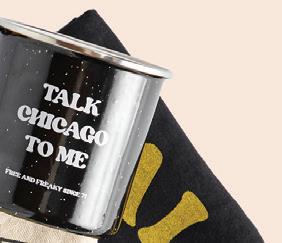



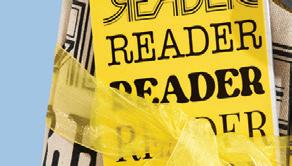






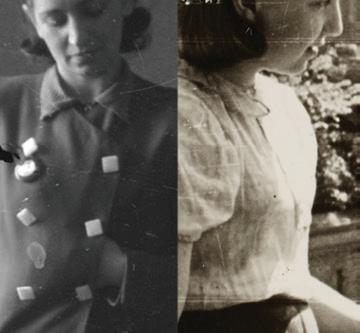
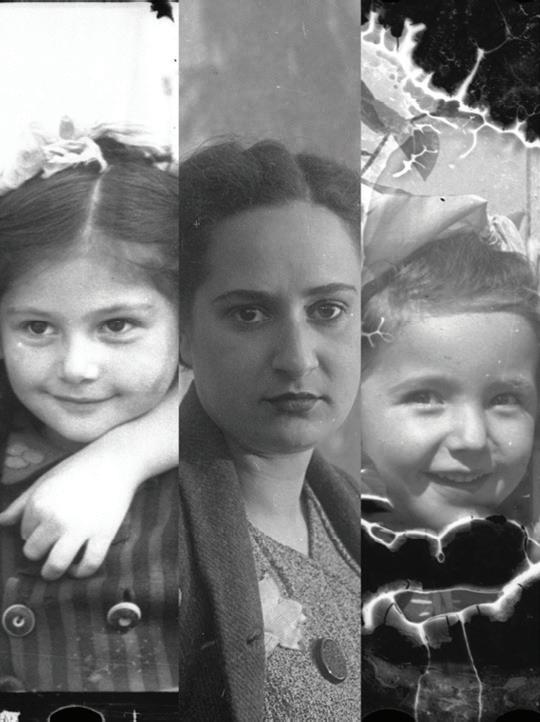



















Hours




Wednesday, Friday, and Saturday: 11:00 AM–4:00 PM Thursday: 11:00 AM–7:00 PM






In honor of Gwendolyn Brooks’s 106th birthday—known as “Brooks Day” in Chicago—all are invited to a reading of Blacks and new poems by local poets. After the reading, Brooks Permissions will host a virtual panel on Brooks’s only novel, Maud Martha, with insights from Dr. Joanne Gabbin, Dr. Sandra Jackson-Opoku, and Sandra Cisneros. This 10th annual Brooks Day is presented in partnership with the Guild Literary Complex.
Wednesday, June 7, 10AM, South Shore Cultural Center
Learn more at PoetryFoundation.org
are the two mainstream Chicago worships— Johnson’s o to a good start. No matter how much you may despise the lefties who elected him.
Not that crushing the opposition is healthy for the city. It’s overkill. It only takes 25 council votes to pass legislation (the mayor breaks ties). No need to run up a score. Apparently, Mayors Daley and Rahm had a hunger for big votes (50-0, 49-1, and so forth), as though lopsided majorities compensated for some hidden inadequacies.
Last week’s reorganization was actually the council’s second reorganization in the last two months. The other took place at a meeting a few days before Johnson’s April 4 runoff against Paul Vallas.
In that first reorganization, a handful of Mayor Lori Lightfoot allies forged a coalition that approved its council chairs.
In the aftermath of presiding over his first City Council meeting, Mayor Brandon Johnson gave himself the highest grade possible.
“If you’re keeping score, I believe it was 41 alderpersons voted for it,” Johnson told reporters. “I would consider that an ‘A’ grade. I mean—I don’t know what a brother’s gotta do to get a high five around here, but we made history today.”
I must admit—I find Johnson’s wisecracks refreshing. We haven’t had a mayor with a sense of humor since Harold Washington. It’s probably only a matter of time, though, before the realities of life and politics grind Johnson into a snarling sneering sourpuss. Like the three mayors who came before him. But that grade, the A? Is it accurate? Hmm . . .
Johnson gave himself an A because he convinced 41 of 50 alderpersons to vote for his council reorganization plan.
Well, not to get all technical and everything, but 41 out of 50 amounts to 82 percent. And most teachers would give that a B.
I’m reminded of Ms. Fountain, one of the greatest grammar school social studies teachers my kids ever had. She was tough. In her class, only 93 percent and above resulted in an A. Her grading policy led to the following exchange . . .
Me: You know, back in the day, anything above 90 percent was an A.
Ms. Fountain: Nobody asked you about back in the day.
I do get Johnson’s point. It was a lopsided win that showed he was in charge. And in this city, which has always had a weakness for gangsters, that’s what matters most.
That is, mayoral success is generally viewed as a mayor’s ability to steamroll or even humiliate their opposition. So if your model for great mayors is Rahm and Daley—and those
I enjoyed that. I’m so sick and tired of mayors selecting council chairs. It’s antithetical to a healthy democracy; dysfunctional for the executive branch to dominate the legislative one. Especially because one branch is supposed to be a check and balance on the other.
It also leads to really bad policies that never get adequately explained, because there is no need for a mayor to justify a deal that he or she knows the council will rubber-stamp. Like, to pick the most obvious, selling the parking meters for a fraction of their worth.
In that first reorganization, the alderpeople stitched together an interesting coalition of former adversaries, including alders who supported Vallas and alders who supported Johnson, and others, like Alderperson Scott Waguespack, who were neutral.
I didn’t think that reorganization would last once a new mayor took office. And sure enough, Mayor Johnson pushed through an ordinance that rearranged the chairs, replacing alders he didn’t trust with alders he did. Most notably, he ousted Waguespack as chair of finance in favor of Alderperson Pat Dowell.
A few words about Waguespack . . .
I’ve admired Waguespack since he first got elected alderperson of the 32nd Ward in 2007, beating what was left of the Dan Rostenkowski machine in and around Roscoe Village and Bucktown.
For the next 12 years, he was one of the only alders with the courage to consistently defy
Mayors Daley and Rahm—even voted against the parking meter deal.
In 2019, he had the foresight to endorse Lightfoot early, when most Chicagoans didn’t even know her name.
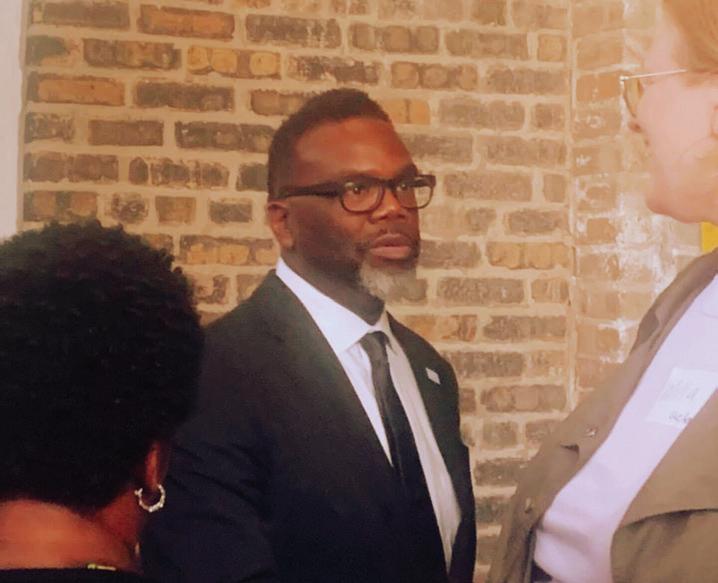
In appreciation, Lightfoot designated Waguespack to chair finance, the important committee that oversees contracts, TIF deals, and budgets.
Waguespack was the best finance chair . . . well, ever. Or at least in my lifetime. Which isn’t saying much, since for almost 30 years, the finance chair was Alderperson Ed Burke. Who, as you probably know, is under federal indictment for allegedly using his influence as finance chair to strong-arm TIF vendors into hiring his law firm to handle their property tax appeals.
Waguespack hired a good sta that e ciently ran the committee with less of a budget and fewer employees than Burke employed. So he did more for less while managing to get through four years without shaking down city vendors. He doesn’t even have a property tax appeals business. Imagine that—a Chicago politician who didn’t use his influence to make money.
But Waguespack was not a Johnson ally. He supported Lightfoot in round one and remained neutral in the runo , even though the choice, if that’s what you call it, was between Johnson, an Elizabeth Warren Democrat, and Vallas, a MAGA sympathizer.
When the election was over, Waguespack took things a step further, essentially warning Johnson not to replace him as finance chair. Pretty much guaranteeing Johnson would do just that.
At last week’s meeting, Waguespack took the high road, congratulating Dowell and saying, “I hope to forge a productive working relationship . . . with the new administration.”
He was one of the nine votes against the reorganization plan. So it looks as though he’s back to his days as a council independent. We can always use a few of those, no matter who’s the mayor.
Anyway, congratulations, Mayor Johnson on your A, which, back in the day, would constitute a B—though I got a feeling your response to that will be like the one I got from Ms. Fountain. v @bennyjshow
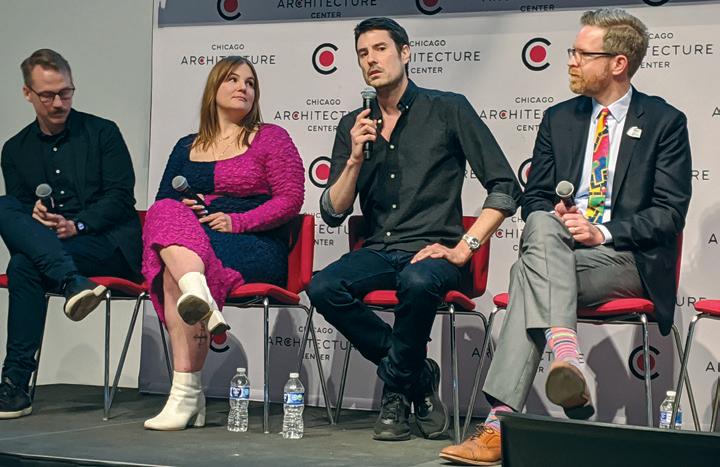 By DEANNA ISAACS
By DEANNA ISAACS
Here’s a question: How many elements can you strip from an iconic building before it loses its identity?
Could you pull the clocks o State Street’s flagship Marshall Field Building? Slice the big Ti any dome from the Chicago Cultural Center? Cut the X braces from the Hancock?
How about tearing the Trump sign off Trump Tower?
“How many identifying elements can you take from a building before it loses its soul?” was the core question posed at last week’s premiere screening of Nathan Eddy’s latest documentary film, Starship Chicago II, at the Chicago Architecture Center.
If you’ve passed the James R. Thompson Center this year, you’ve seen the barricades blocking the glassy front entrance and the signs: “Building Interior Closed for Renovation.” You can’t miss the big orange crane out front, or the irony.

Less than 40 years after its celebratory ribbon cutting, this unique postmodern structure, intended to be the most open and public of public buildings, is neither public nor open.
At least it’s not closed for total demolition.
The wrecking ball had been a real threat for years but especially since 2015, when Governor Bruce Rauner planted himself in the iconic atrium to announce that he was putting the Thompson Center (originally known as the State of Illinois Building) up for sale and couldn’t imagine that any buyer would let it stand.
No sale happened under Rauner, but in the last days of 2021, Governor J.B. Pritzker announced that a group led by developer Mike Reschke had won a bid to buy and redevelop the building in a plan that would keep the state as a one-third owner and partial occupant. Preservationists were relieved but curious as to how well this could work with the LaSalle Street corridor office vacancy rate—driven by the pandemic and the Internet—headed toward 25 percent.
Then, last July—in a feat of real estate magic surprising even for Chicago—Pritzker
revealed that Google will be the ultimate owner of the 1.2 million-square-foot Helmut Jahn-designed masterpiece, purchasing it from Reschke’s group after they complete a three-year renovation. Google will use the entire building as a new headquarters; the state of Illinois will be completely out.
Fans of the building were mostly cheered by this news: Google has deep enough pockets to be a good steward if it wants to be, and its presence on struggling LaSalle Street might spark a badly needed turnaround there. But the bait-and-switch aspect of the two announcements hung over the deal like a whi of something polite society would choose to ignore: What does it mean for the state to completely exit a building that—more than any other—had been designed to embody the interactive relationship between a democratic government and its citizens?
In March, preservationists learned that the Thompson Center had qualified for listing on the National Register of Historic Places, and that Prime Group, exercising an owner’s right to object, had quashed the listing. Preservation Futures, the group commissioned by Landmarks Illinois to write the nomination, noted that “listing on the National Register does not explicitly prevent a building from being altered.” But the objection to it heightened unease about what those changes might be.
Helmut Jahn’s firm, now headed by his son, Evan Jahn (who is interviewed in the film and attended the screening), is handling the redesign, which sounds optimal. But the public hasn’t seen any renderings since December 2021, before Google was in the picture, and what was released then was disturbing to anyone who wants the building to retain its trademark quirkiness. Those images showed a totally bleached out, innocuous exterior and atrium—as if someone had sucked the blood and life from Jahn’s noisy, witty, riotous, blue-and-salmon postmodern celebration of a building.
In 2017, Eddy, a Berlin-based journalist and filmmaker (and Northwestern graduate), re-
leased his original Starship Chicago, a shorter documentary notable in part for great interview clips of another inimitable local architect, Stanley Tigerman. Eddy was back in town for this premiere, observing that there are still a lot of open questions about the Thompson Center. Among them: What’ll happen to the plaza? (Jean Dubu et’s sculpture Monument With Standing Beast—aka “Snoopy in a Blender”—is slated to be moved.) What will be done with the CTA station? The Pedway connection? How much public access will there be? And how much character can you strip from
a building before it’s lost? When he first saw those early renderings, Eddy told me, this was what popped into his head: “We’ve saved a building, but we haven’t saved the Thompson Center.”
Stay tuned—he’s planning a Starship Chicago III. And in case you missed the Architecture Center event, Starship Chicago II —packed with interviews and swooping bird’s-eye views of the city—is streaming free at mascontext.com through June 18.
R
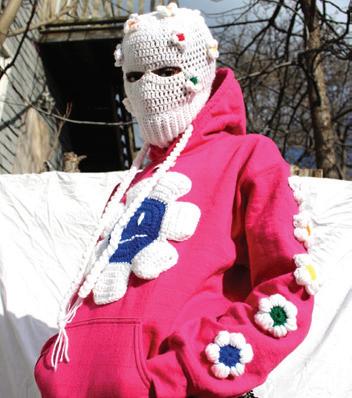
 BY BOUTAYNA CHOKRANE
BY BOUTAYNA CHOKRANE
Chelsea Billingsley, better known as Chelsea B, always knew she’d be an artist. With her latest collection, “Give Them Their Flowers,” the crochet streetwear designer pays tribute to her great-grandmother and great-uncle, both of whom have left a lasting impact on her life in different ways. Pauline Winters, her great-grandmother, was also an avid crocheter, and her great-uncle, Spurgeon Jake Winters, was a member of the Illinois Chapter of the Black Panther Party who was killed at 19. “When I’m crocheting or doing things within the community, I often feel like they’re with me,” she says. “This was my way to show love and appreciation for them.”
But Billingsley’s work isn’t just about honoring her family’s legacy; it’s also about uplifting her community through art. “Give Them Their Flowers” was a collaboration with the Chicago Fashion Coalition, a nonprofit aimed at supporting the local fashion scene. The collection showcases Billingsley’s idiosyncratic style with her signature flower patches, crocheted bouquets, and HypeBo Bear hats—which are hyperbolic planes that, to Billingsley, resemble coral reefs or abstract flora. “I just picture people wearing them and looking like human flowers,” she says.
Growing up in Englewood, art was a constant in her life. Whether it was drawing or
painting, Billingsley was always creating, but fashion came later. “I wouldn’t say I was a fashionable kid,” the 26-year-old says. “We weren’t fortunate [enough] to have a lot, so thrifting became a thing for me.” She would thrift with her grandmother all the time, and on Saturdays, she and her mother would go to the 69-cents sale at the Salvation Army.
“Being so skinny, I just had to make things work,” she says. Her freshman year of high school, she received a sewing machine for Christmas and began altering her clothes. In her junior year, her homeroom teacher introduced her to crochet and gifted her with her first ball of yarn and hook. Her dogs were her first models, as she crocheted them teeny hats and bows. “It became this meditative process,” she says. “I went to school on the west side of Chicago, and I’m from the south side. That commute was about two hours. It gave me time to practice, and that’s how I fell in love with it.”
After high school, Billingsley earned her BFA in surface design and textiles, with a minor in fashion design, from Savannah College of Art and Design. What began as a hobby turned into a business venture when her “Sunshine” dress went viral on Facebook. “It was the first dress I’ve ever done,” she says. In just under two days, she intricately crocheted an
ethereal, floor-length honey yellow gown with a mermaid-esque silhouette. Her avant-garde flair and fun take on semiformal wear received widespread praise, leading her to start her own studio practice, House of Chelsea B (formerly known as Chelsea B Creations), in 2017.
“I didn’t plan to have a fashion brand,” she says. “It just found me, so I went with it.”
With a crochet hook and yarn, she crafts playful and vibrant creations that capture the eye and the imagination. From her whimsical bunny balaclavas to her cozy cloud bags, Billingsley’s work is unmistakably hers. With every design, she also considers the psychology of color, hoping to evoke certain emotions in the individual and construct a multisensory experience that goes beyond the physical aspect of fashion. Her sneaker buttons are like miniature pieces of art, bursting with colors, in the form of smiley faces and blooms.
Billingsley pours her soul into every design, but her blossom ski masks, pu er coats, and hand-knit robes hold a special place in her heart. The blossom ski masks are like wearable gardens, adorned with intricate florals. The puffer coats are equally stunning, with bold patterns and plush textures. And the fulllength robes are soft, snug, and meticulously fashioned.
When it comes to her creative process, she’s guided by two di erent approaches. First, she uses a mind map to sketch out ideas, writing down words and thoughts, and noting the colors she’s envisioning. She then uses these elements to make a collage or sketch a silhouette before moving on to actual creation. The second method involves simply visualizing the colors she’s feeling and diving straight into designing. While her work is therapeutic and an extension of her subconscious, it almost always exudes positive energy and joy. “It’s a manifestation of how I want to feel if I’m not feeling that way in the moment,” says Billingsley, who uses crochet not only as a means of self-expression, but also as a way to weed out any bad vibes she’s sensing at the moment.
Billingsley’s innovative perspective on streetwear sets her apart from others in the industry, blending traditional design elements with contemporary street style to create sustainable garments that are both stylish and functional. She finds inspiration in the lively
world around her, with nature and Chicago’s dynamic cultural landscape as her main muses. Music and color also play a role. “It’s a melting pot, and that’s been a key to who I am,” she says about the city. “I’m a collage of a bunch of things. I’m a collage of color. I’m a collage of streetwear, culture, imagery, art, fashion, fine art, museums, and so my art is an abstract portrait of me.”
While she’s made waves in the fashion world, her impact extends far beyond that. Her partnerships with local concept stores like RSVP Gallery and Iridium 77 Lab demonstrate her meaningful ties to Chicago’s creative community. Her influence has even reached the world of sneakers, where she’s curated customization workshops—and met Virgil Abloh—with Nike Chicago to celebrate the 40th anniversary of the timeless Nike Air Force 1. In the summer of 2022, she released her first-ever sneaker, the Air Max 90 “Notra,” and she’s a member of the 2023 North America Jordan Women’s Collective. Her aesthetic has garnered attention from a range of talents, all of whom she’s styled, including rappers Flo Milli and Baby Tate, singer Lucky Daye, and drag queen Monét X Change for the seventh season of RuPaul’s Drag Race All Stars
Her work embodies her commitment to blurring gender norms. Fusing crochet and streetwear, she describes her pieces as both androgynous and sensual. Her designs lean into oversized silhouettes, vivid hues, and elaborate textures, intended to appeal to a diverse range of tastes. Her success is evident considering her work has been showcased everywhere, from the music scene to drag competitions to sneaker culture.
As she puts it, “I didn’t come here to make blankets. My position has always been to shift that narrative and create space not just for me but also other people.”
Billingsley is eager to delve into editorial projects and fine art collaborations. She aspires to showcase her creations in an exhibition, including her sentimental “Sunshine” dress. She is a true trailblazer, pushing the boundaries of what is considered “fashionable” and paving the way for a more inclusive industry.
When asked what impact she hopes to have on the market, she responds, “That I change the game for what it means to be not only a fiber artist but a fiber artist of color. I hope to continue to inspire somebody that there is space for you and whatever you want to do.”
‘I didn’t come here



decades.


Traveling Chicago by bike, always with his camera, Patric McCoy captures 1980s Black gay Chicago, creating a poignant marker of place, time and memory.
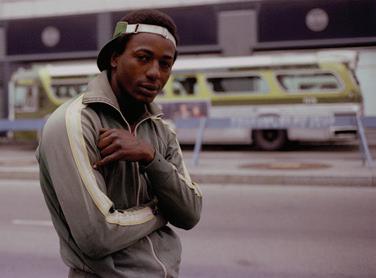
Julia Fine’s new novel is a dark fantasy about teenage girls in 18th-century Venice.
 By ADAM MORGAN
By ADAM MORGAN
As far as I can tell, no Chicagoan has written a novel about Italy since 1890, when Henry Blake Fuller’s queer-coded satire, The Chevalier of Pensieri-Vani, was misinterpreted by critics to be an earnest heterosexual romance. More than 130 years later, I doubt readers will make a similar mistake with Julia Fine’s new novel.
A dark literary fantasy set in 18th-century Venice, Maddalena and the Dark is the story of two 15-year-old girls—the wealthy Maddalena and the lonely Luisa—who get tangled in a complicated web of friendship and desire. The stunning, sensual novel drips with period details, gothic atmosphere, and teenage intrigue.

“There’s so much going on for girls at that age,” Fine tells me over Zoom. “I remember having sleepovers with friends, curling up and sharing a bed, and just discovering what that physicality means. It’s the line between, ‘Do I love you, or do I hate you? Do I want to devour
you, or do I never want to see you again?’”
Maddalena and Luisa live and sleep together at the Ospedale della Pietà—an orphanage, convent, and music conservatory where they play violin in Antonio Vivaldi’s all-female orchestra. The composer, the orchestra, and the orphanage were all real, but this being a fantasy novel, the dark sea surrounding Venice is also a character, represented by a mysterious gondolier and an ancient, floating shrine. When Maddalena makes a Faustian bargain with the sea in exchange for her deepest desire, she and Luisa spend the rest of the novel trying to survive the repercussions.
“I was a weird kid,” Fine says. “I started writing at an early age and acted out stories with Playmobil toys and Barbies.” A descendant of displaced European Jews who immigrated to Brooklyn and Detroit, Fine grew up in Chevy Chase, Maryland, the leafy suburb of Washington, D.C., “where all the worst Su-
preme Court justices are from.” Her parents were lawyers, but Fine grew up around books, including a series of children’s audiobooks on cassette tapes about classical music.
“You would hear little snippets of the music and learn about the composers,” Fine remembers. “The Vivaldi one was my favorite. It was about this orphaned girl he taught at the Ospedale, so I just filed that away for 30 years until I saw a PBS documentary on Vivaldi and realized, ‘Oh my god, this is a perfect setting for a gothic novel.’”
As a teenager, Fine fell in love with the speculative fiction of Diana Wynne Jones and Philip Pullman, which inspired her to major in English and psychology at Grinnell College in Iowa, where she met her husband, Rick. They moved to Chicago in 2010, where Fine worked selling ads in the Yellow Pages, followed by a role in a small PR firm. “It was really stressful, so one day I just walked in and quit,” Fine says.
She thought about going to law school like her parents but wanted to do something more creative and took inspiration from David Benioff, one of the showrunners of Game of Thrones. “I looked him up and discovered he was a novelist first and he got an MFA.” So she applied for the creative writing MFA program at Columbia College Chicago, where she found a mentor in Audrey Ni enegger, author of The Time Traveler’s Wife.
“Julia has such a lively mind, so it doesn’t take much to get her going in a very fruitful direction,” Ni enegger told me back in 2018. “It was a pleasure to engage with somebody who’s not only willing and disciplined but also quirky and funny.”
These days, Fine, 35, lives in Portage Park with her husband and two children. She’s a full-time writer and writing teacher at StoryStudio Chicago, the Ravenswood nonprofit where fellow Chicago novelist Rebecca Makkai is artistic director. Maddalena and the Dark is Fine’s third novel, on the heels of 2018’s What Should Be Wild, which she began in Niffenegger’s class, and 2021’s The Upstairs House , which won the Chicago Review of Books Award for Best Fiction. (Disclosure: I founded the Chicago Review of Books in 2016 but stepped back from an editorial role in 2019.)
“Olivia Rodrigo unlocked this book for me,” Fine says. “Her album Sour came out when I was writing the first draft, when I was trying to find a way back to the mindset of being a
teenage girl. Rodrigo makes herself very vulnerable and admits to the less savory aspects of being a jilted teenage lover. Just because my characters were teenagers in 1717 doesn’t mean they didn’t have some of those same intense feelings.”
Fine wrote most of the novel at home, in the evenings after her children went to sleep, and a few chapters in the English walled garden at the Chicago Botanic Garden—the closest thing that Illinois has to the grounds of a Baroque Italian estate. “My suspicion is that Maddalena’s family garden looks more English than Italian because I was writing in that space.”
Like Chicago, the city of Venice is defined by its relationship with the water around it, which influenced the supernatural elements in Maddalena and the Dark. The novel opens with watery gothic imagery that hints at the darkness to come: “A deep-sea dirge and barefooted girls in soaked nightdresses, lips pursed around their post horns, reams of brackish water falling from barnacled cellos.”
In March 2022, Fine traveled to Venice for in-person research. “I wanted to add a lot of sensory experiences, but I didn’t actually ride a gondola. I rode a water taxi instead,” she says. “The wonderful thing about writing historical fiction set in Venice is that it’s looked the same for hundreds of years.”
Like many writers on the verge of publishing a novel, Fine is nervous about the impact Maddalena and the Dark will make on readers. “What if this book comes out and no one ever talks about it again? After I devoted years of my life to it?” she asks. “The publishing industry really loves to market a debut, and I’m never going to have one of those again, but I’ve gotten stronger as a novelist with every book.”
To cope with the uncertainty, she’s already writing another novel—about a haunted house in Gilded Age America. “I really like ghosts!” she says. But she’s also grateful to live in a city where writers support each other. “The Chicago literary community doesn’t feel like people are fighting for resources. It’s really welcoming, and it’s easy to feel like you’re part of a community thanks to people like Rebecca Makkai, Nami Mun, and Javier Ramirez.”
Whatever its impact, Maddalena and the Dark brings 18th-century Venice to life in a unique tactile way, with a memorable mix of historical richness and otherworldly magic. v
@adamm0rgan
“Footwork saves lives.”
Those three words comprise the mantra that the members of the Era Footwork Collective live by. The local group—also known as the Era Footwork Crew—consists of four dancers and two producers who helped pioneer Chicago Footwork, the Chicago-born electronic music genre and battle-dance styles known for their impressive speeds.
“We’re products of [footwork],” the Era dancer Jemal “P-Top” De La Cruz says. “Footwork has given us the opportunity to see things, meet people, and cement relationships.”
Founded in 2014, the Era Footwork Collective has brought footwork to national and international audiences, playing a major role in transforming the style from a local art form to a global movement. Along the way, they’ve performed abroad in countries like Japan and Peru, and alongside prominent hip-hop artists such as Chance the Rapper and Towkio.
Footwork evolved out of Chicago’s 1990s ghetto house music scene. Once established, it didn’t take long for footwork music, with its 160 beats-per-minute tempo, to become the soundtrack of house parties and dance battles across the city. As a dance, footwork is known for its use of rapid foot movements that consist of intricate twists and turns.
The Era Footwork Collective cofounder Sterling “Steelo” Lo on says i’s hard for him to imagine his life without the art form.
“I have always cherished footwork as an outlet that has accompanied me throughout my entire life, even during times when I was oblivious to its significance,” he says. “It fascinates me how footwork stands as a firm foundation, universally, for individuals to assert their beliefs and values.”
Even as the Era Footwork Collective has grown their audience, they’ve never forgotten their Chicago roots. They prioritize philanthropy—with initiatives such as #MaskforChi, which distributed more than 4,000 face masks in the spring of 2020—and have made youth programming a major focus of their work. In December, the collective also hosted a Youth Footwork Festival where local youth could participate in footwork workshops and performances, and even participate in a dance battle.
“[The youth] can look at us and say, ‘I could be that.’ And ‘footwork can be cool,’” the Era Footwork Collective cofounder Jamal “Litebulb” Oliver says.
Through providing opportunities to local youth, the Era Footwork Collective hopes to raise the next generation of Chicago footwork innovators in the city in which the form originated. “[Footwork] is a Chicago tradition. This is our culture and it was born here and it’s spreading all around the world. So we definitely got to stay on top of home,” says music coordinator DJ Spinn.
Over the years, the Era Footwork Collective has received recognition and funding from various institutions, including the New England Foundation for the Arts and the Field Foundation. In 2023, the group joined a cohort of Black-led dance organizations participating in the Chicago Black Dance Legacy Project (CBDLP), which seeks to make the city’s dance landscape more equitable by providing a select cohort of Black dance companies with resources, funding, preservation, and performance opportunities.
Since joining the cohort, the Era Footwork Collective has had the opportunity to work and perform on the same stages as some of Chicago’s most well-known Black dance companies. The members say it’s been inspiring to learn from local dance leaders who, in some cases, have been running their respective organizations for decades.


“We’re rubbing shoulders with companies like Muntu Dance that have been around for over 50 years,” De La Cruz says. “Just by being in the same room as them, we’re picking up on any knowledge we might need.”
Beyond live performances, the collective has explored many artistic offerings. The group has made short dance films and music recordings, including a 2016 stage show and music project titled In the Wurkz.
Its members are also pursuing various creative projects and passions beyond performance: Cofounder Brandon K. Calhoun (aka Chief Manny) is producing a footwork film titled Toe to Toe, Lo on is building a streetwear brand called Stitched by Steelo;
Litebulb is working on a show entitled New Ghost; and De La Cruz works with a project centered around footwork youth and cultural enrichment called The Ring.
“We have a lot to look forward to,” Calhoun says. “We have projects that we’ve been working on for the past two years now. It’s time to start releasing them.”
Even as the Era Footwork Collective rolls out several creative projects in the coming months, their focus steadily remains on one goal—to keep empowering Chicago’s Black youth.
“When we think about the future in 10 or 15 years, It’s really like, ‘OK. What is the goal?’” Calhoun says. “I think the goal has been to save as many lives within the Black community with an art form that’s different. An art form that’s from Chicago.”
The Chicago Black Dance Legacy Project is a program of the Logan Center for the Arts at the University of Chicago. Their current cohort of local dance companies includes Chicago Multi-Cultural Dance Center & Hiplet Ballerinas, Deeply Rooted Dance Theater, the Era Footwork Collective, Forward Momentum Chicago, Joel Hall Dancers & Center, M.A.D.D. Rhythms, Move Me Soul, Muntu Dance Theatre of Chicago, NAJWA Dance Corps, and Praize Productions Inc. For more about CBDLP, visit chicagoblackdancelegacy.org, and chicagoreader.com/special/ logan-center-for-the-arts-at-the-university-of-chicago.
To learn more about Forward Momentum’s programs and upcoming summer camp, visit forwardmomentumchicago.org.
The Era Footwork Collective take footwork abroad while investing in the next generation of Chicago dance and musicPhoto by Treylegit



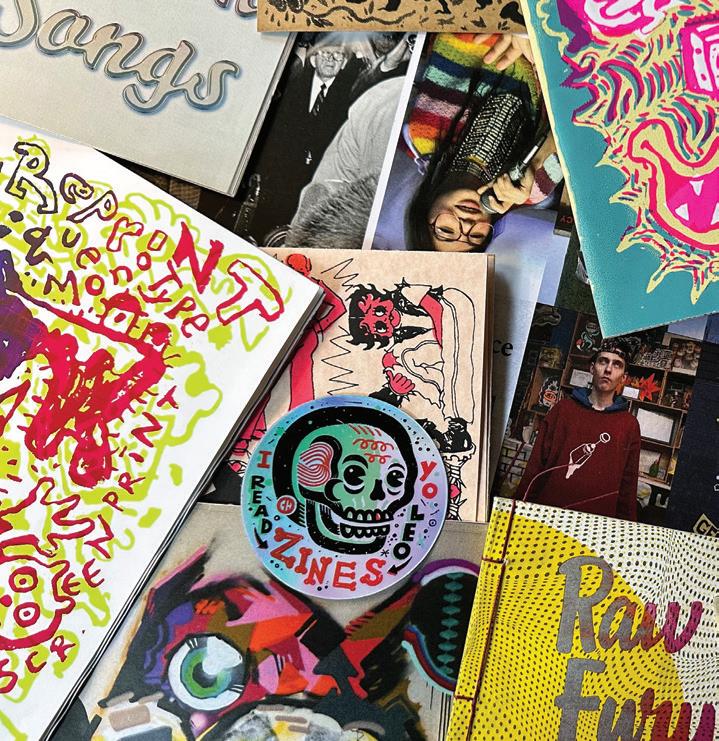
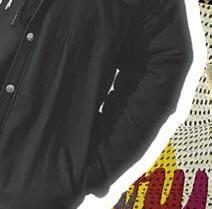
As the saying goes, Chicago is a big small town. We’re always bumping into each other. Artist, photographer, zine maker and promoter, curator, event organizer, and lifetime Chicagoan Oscar Arriola, 51, is one of those welcoming, familiar faces often present at the coolest, most underground happenings. As an appreciator, connector, and maker, Arriola is a constant in the street art and independent publishing scenes. At the upcoming Chicago Alternative Comics Expo (CAKE), taking place at the Broadway Armory on the first weekend of June, he will be hosting an installment of The Stick Up! Chicago, a sticker club he’s been organizing since 2012.
“People come to hang out and socialize with other artists as they draw on stickers,” Arriola says. “We usually play music and bring snacks and drinks to share. Participants bring their own art supplies, but I also try to bring all kinds of unusual blank stickers to share. Some people trade with others, others are street artists who put them up outdoors.” Arriola mentions the portability of the medium: “[They are] small artworks. I don’t draw well but do enjoy doodling, and the small canvas space of a sticker is not as intimidating for people to approach. We have a wide range of people come and draw—from beginners to fine artists doing intricate work. There aren’t any rules.” Meetings happen every other month at various places. Arriola avoids bars so that the events can be all ages. “I purposely hold The Stick Up! Chicago at di erent locations to both introduce people to great art spaces as well as to have it equitable so that people don’t have to travel far each time,” he says. “I went from holding them in friends’ art studios and galleries like Casualiving, Howard Street Gallery, and Chicago Truborn, to larger institutions like the Museum of Contemporary Art, Intuit, and the Chicago Cultural Center as the events became more popular.”
After a long hiatus extended by the pandemic, Arriola resumed his sticker club this


year with the support of his artist friend Rae Bees, who o ered the South Side Hackerspace in Bridgeport as a location. The upcoming edition at CAKE will be held in conjunction with Busy Beaver Button Co., who will provide button-making machines for attendees to make their own pins. The program will be from 11 AM to 12:30 PM on Saturday, June 3, in the workshop space by the entrance to the Broadway Armory.
Arriola is eager to see a lot of great artists who will be tabling at CAKE this year—such as David Alvarado, JB Roe, Caroline Cash, Audrey Ni enegger, Mike Centeno, and Jasjyot Singh Hans. “One person I’m especially excited about is Korean American artist Eunsoo Jeong, who publishes hilarious photo comics under the name Koreangry, featuring a doll character in front of handmade sets talking about racism, relationships, and other topics. I also like randomly encountering the work of artists that I’m not familiar with,” he says. CAKE co-organizer Tyrell Cannon, 42, agrees that the event “is the perfect place for lifelong comics fans to discover new work, or for not-yet-comics-fans

to dip their toes into this amazing medium.”
“Attendees can learn all about the bookmaking process, or make buttons and stickers, or hear artists talk in detail about the creation of their work. The main event is our exhibition, featuring 150+ artists from all over the country exhibiting fresh and unique comics. This wide variety means there is something for comics fans of all types,” Cannon says. A comics artist himself—he’s currently doing art for The Schlub, to be published by Image Comics this summer—Cannon recommends the works of featured artists Derf Backderf (My Friend Dahmer ), MariNaomi ( I Thought You Loved Me ), and MAD magazine’s Johnny Sampson, among others.
It is a busy season for independent publishing enthusiasts; CAKE is happening shortly after Chicago Zine Fest held its 12th edition in May. Arriola participated in the Zine Fest with his photo-and-art-focused zine imprint, Fotoflow Press. He also distributed zines by other authors, such as a Brazilian pichação (street art) zine by Studio Treze. Arriola is an active member of the local zine scene; he
produces his own zines (Ghost and 25 Chicagoans ), and with artist CHema Skandal! he presents ZINEmercado, which happens annually outdoors at Comfort Station (the next one will be on Sunday, August 27). This fall he is planning on reviving Foto Mercado as well, a photography-based book and zine fest. “I enjoy spreading the good word on zines and encourage people to make their own. I’ve been lucky enough to get invited to speak to classes around the city about zines. I bring many different kinds to teach students about various techniques in making them.”
For those wanting to learn more about the craft, Arriola recommends online tutorials and the monthly Chicago Zine Club organized by Cynthia E. Hanifin. “I always encourage beginners to make a mini zine because all it takes is one sheet of paper, a few folds, and one cut down the middle to produce an eightpage mini zine with a foldout centerfold on the other side. There are also some books like Stolen Sharpie Revolution , Whatcha Mean, What’s a Zine?, and Make a Zine!: Start Your Own Underground Publishing Revolution , available from places like Microcosm Publishing online and Quimby’s in Wicker Park. Arriola considers Quimby’s bookstore “by far the best zine store in the country” as well as a great place to get stickers.
Besides his aforementioned passion projects and all the other art-related events he curates and organizes, Arriola is a head clerk for the Chicago Public Library. His day job gave him insight into the importance of properly archiving artworks. Instead of putting up his stickers in the street, Arriola says he is the “art nerd” who scans and saves them. “Working at the library I’ve enjoyed seeing what archives do,” he says. “The Chicago Public Library has the Chicago Artist Files in the art department at Harold Washington Library Center. They’ve got about 11,000 files on Chicago artists from over the years. Any artist can create a file about themselves and add ephemera like exhibition postcards, drawings, photos, zines, stickers, and show price lists. I’m always encouraging artists to start a file there.” Encouraging artists does seem to be one of Arriola’s gifts. v
@chicagolooks
British Palestinian artist Mona Hatoum’s work reflects her experience of cultural displacement.
In Roadworks (1985), Mona Hatoum walks barefoot through the streets of Brixton dragging a large pair of Dr. Martens boots (the same brand previously favored by the British police) attached to her ankles by their laces. The short video is edited from documentation of the artist’s hour-long performance of the same title. The Negotiating Table (1983) is a direct response to the Israeli invasion of Lebanon. Here, the artist lies motionless on a table. Her body is bloodstained, entirely wrapped in plastic; her head is covered in surgical gauze. Across the gallery, in Variation on Discord and Divisions (1984), exile, war, oppression, and the sharp criticism thereof all become one. The video shows Hatoum, dressed in all black and wearing a stocking over her head, ripping out raw kidneys from under her clothes, cutting them up, putting them on plates, and serving them to the audience. The three videos compile a disturbing yet powerful vignette of intense performances realized throughout the 1980s, and mark Hatoum’s return to the MCA a er 25 years.
Breaking all sorts of boundaries—personal, social, political, geographical—Hatoum is unapologetic about taking a strong stance. Having grown up in Beirut, she became an exile to London in 1975 when war broke out in Lebanon. Her work, reflecting her experience of cultural displacement, is a testament to that. She speaks of global marginalized communities, identity, intimacy, race, power, conflict, and unrest.
portraits—sculptures that reimagine the immaterial “self” as tactile. The two ostensibly incompatible mediums— ceramic and fiber—twine together to create haunting figures. The terra-cotta and off-loom weaving blend together in an homage to Aguiñiga’s Mexican heritage. Emotional Body I spills from the gallery wall, engulfing a series of terra-cotta hands immersed in the rope sculpture. Similarly, the wall-hung Internal Body II holds terracotta internal organs within its fiber “belly.” Aguiñiga ventures to explore the esoteric, hanging Metaphysical Body II from the ceiling to create a hauntingly inviting display.
Aguiñiga’s sculptures appear unapproachable. At first, that is. But her abstract sculptures signal a tangibly human experience. The works not only literally represent bodies, but evoke the artist’s involvement. Aguiñiga’s use of clay from both Mexico and the United States means she is integrating the tensions with the commodification and colonization of the land. Through clay and fiber, Aguiñiga investigates the body and the conflation of both cra and materiality. —MAXWELL RABB “SWALLOWING DIRT” Through 6/17: Tue-Sat 11 AM-6 PM, Volume Gallery, 1709 W. Chicago 2nd Fl., wvvolumes.com
Despite the luminous names, this Art Institute show misses its mark.
Her exhibition, “Early Works,” featuring six documented performances and video works from that formative stage of Hatoum’s career, continues to two dark galleries—you might need a minute for your eyes to adjust. In So Much I Want to Say (1983) Hatoum keeps repeating those six words while male hands gag her mouth—a literal and metaphorical barrier between the artist and the world. Efforts to be seen, heard, or understood seem futile. “So much I want to say, so much I want to say, so much I want to say.” Hearing the phrase over and over again while you watch her struggle to get the words out—that violent silencing—suggests that women’s bodies and minds have always been the primary battleground of gender oppression. Which sadly is as relevant today as ever.
Like the bygone sovereignty of the aristocrat and the flaneur, figures acknowledged in the show’s epigraphic notes, “Game of Pearls” overflows with polymorphic referents and symbols. From artist Nicolette Mishkan’s aforementioned merfolk to Andrew Sokol’s crystal chain looping along the space’s baseboards, the queer signifiers “Game of Pearls” plays with are those borne of the people categorized as excess and liminal by a violent state’s mechanisms of control. This is not to assert that Ruschwoman champions the money and privilege needed to engage in the decadence of the aristocrat, but rather that they call for such pleasure and romanticism to return to the hands of pleasure’s creators, its keepers, its lovers, its first true prophets and followers: the same people deemed other, those marginalized under a punishing, structural gaze.
—VASIA RIGOU “MONA
HATOUM: EARLY WORKS” Through 11/26: Tue 10 AM-9 PM, Wed-Sun 10 AM-5 PM, Museum of Contemporary Art Chicago, 220 E. Chicago, admission and visitor information at mcachicago.org
At Ruschwoman, “The Game of Pearls” celebrates decadence.
As the womxn of Ruschwoman gallery are much smarter than I, I could not tell you what the “game of pearls” entails in the gallery’s current show: “The Game of Pearls, Prune de Madame, and Other Phantasia (As Confided to the Rusch Womxn).” However, for an exhibition as intricately laced as this one—featuring art as varied as bespoke millinery and fragrance, amongst images of sirens lusciously rendered in oils—I can only imagine the game as something new and old, decadent and severe, a source of pleasure and pain.

As the exhibition’s titular Mrs. Plum, Prune de Madame could be a gesture to a Parisian interior design house, novelist Pierre Loti’s 1905 exoticized account of a visit to Japan, both, or neither, there’s the possibility that the game of pearls is one of obfuscation. Here another word for obfuscation is survival, and all the aching bliss such a game entails. —ANNETTE LEPIQUE ”THE GAME OF PEARLS: PRUNE DE MADAME, AND OTHER PHANTASIA (AS CONFIDED TO THE RUSCH WOMXN)” Through 6/25: by appointment, thewaves@ruschwoman.blue, 2100 S. Marshall, Unit 105, ruschwoman.blue
This show at Haynes Court invites you to experience sculpture with your whole body.
“Prosthesis,” a group show that runs through June 17 at Haynes Court, invites you to experience sculpture with your whole body, even as the show questions exactly what makes our bodies whole. Jillian Mayer’s Slumpie 75 – vertebrae, part of her series of utilitarian objects designed to support bodies that are using
technology, is an ironically ergonomic seat. A single armrest brings an arm holding a smartphone close to the face while the rest of the body slumps toward it for long periods of scrolling. Martha Poggioli’s work brings to light the hidden history of internally worn medical devices for women. Poggioli’s Shield Simulation, medial fragment (US3782376) reads as part of a skeleton from some prehistoric beast. That sense of threat primes the viewer for its reference to the Dalkon Shield, an early IUD that was discontinued a er hundreds of thousands of women suffered serious infections from its faulty strings. (Here’s an exhibition tip: Google the patent number at the end of the title for a fascinating description of its chimeric design.) Fin Simonetti’s My Volition 2 is a waist-high, L-shaped industrial metal stand holding a life-size dog limb elegantly rendered in translucent honeycomb calcite. With a nod to curator Kristin Korolowicz’s interest in architecture, the piece is set flush against the back corner of the gallery, appending to the wall like a prosthetic to the gallery itself. —MEG REULAND “PROSTHESIS” Through 6/17: hours by appointment, Haynes Court, 3050 S. Haynes, haynesartprojects.net
Tanya Aguiñiga’s “Swallowing Dirt” unravels the body with fiber and clay.

At first glance, Tanya Aguiñiga’s “Swallowing Dirt” seems to gesture to the phantasmagoric. Her spectral rope and terra-cotta sculptures fill Volume Gallery, suspended from the walls and ceiling. The figures ostensibly depict the uncanny body, which produces our premature illusory response. But under closer examination, Aguiñiga’s sculptures are corporeal. She threads together her two material disciplines to create a series of haunting forms that concretize when we approach them.
“Swallowing Dirt” features eight unconventional
Vincent van Gogh is to art museums what the Beatles or Jimi Hendrix are to the recording industry—times are tough or run out of ideas? Trot out tried-and-true cash cows and sit counting the receipts. To buttress their case, the Art Institute has filled out their slate of summer blockbusters with another dead-too-soon ringer, Georges Seurat (1859-1891), and three minor stars: Paul Signac, Emile Bernard, and Charles Angrand. Promising the cutting edge by including “Avant-Garde” in the title, the show is an odds-and-sods collection of middling paintings and preparatory sketches. If it were part of a box set, this would certainly be the last disc.
There are multiple depictions of parks, bridges, and suburban restaurants done between 1882 and 1890 near the Seine river, on the outskirts of Paris. No whiff of a grand statement or revolutionary achievement to be found for miles. It’s a snapshot of friends taking it easy. The shadow of Seurat’s La Grande Jatte hangs heavy over the entire show, with half a dozen painted and drawn studies for the museum’s calling-card masterpiece included, but the overall impression is of artists treading water.
The installation—with its mint-green walls and oversized children’s museum-style timeline running the periphery—does this slight collection no favors. Van Gogh’s Factories at Clichy, summer 1887, is the highlight, and I never tire of Seurat’s spectral crayon drawings, but much of the rest could have easily been le in whatever storage facility it’s been gathering dust in for the past century-plus. Nothing here warrants the $10 premium the museum is asking, but I doubt they’ll have any trouble collecting it hand over fist. —DMITRY SAMAROV “VAN GOGH AND THE AVANT-GARDE: THE MODERN LANDSCAPE” Through 9/4: Mon 11 AM-5 PM, Thu 11 AM-8 PM, Fri-Sun 11 AM-5 PM, Art Institute of Chicago, 111 S. Michigan, artic.edu/exhibitions, adults $32 ($40 Fast Pass, $27 Illinois residents, $20 Chicago residents), seniors 65+, students, and teens 14-17 $26 ($34 Fast Pass, $21 Illinois residents, $14 Chicago residents), children and under 14 and Chicago teens 14-17 free v
Inicios kicks off this weekend with three plays in staged readings.
By SANDRA TREVIÑOThrough theater, we can experience a variety of perspectives, while examining dialogue, monologue, and characters that allow us to reflect, learn, and connect. The Chicago Latino Theater Alliance (CLATA) is an organization that helps foment this idea by supporting Latine theater through rich storytelling locally and worldwide with theater projects like Destinos: Chicago International Latino Theater Festival and Destinos al Aire.
This year, CLATA created Inicios, a festival and incubator designed to provide Chicago Latine playwrights the opportunity to submit full-length plays to be workshopped with a director and cast, followed by a public staged reading with CLATA member theaters around the city. In May, four winning authors of three plays were announced: Nelson A. Rodriguez, Raul Dorantes and Emily Masó, and Claribel Gross.
Inicios kicks off June 2 at UrbanTheater Company (2620 W. Division) with a public reading of Rodriguez’s New Personalidad , directed by Xavier Custodio. On June 3, Dulcci by Dorantes and Masó, directed by Marcela Muñoz, will be hosted at Aguijón Theater (2707 N. Laramie). And on June 4, Teatro Tariakuri (3117 W. 63rd) presents a reading of Gasping: A Nicaraguan Fever Dream by Gross, directed by Karla López-Galvan.

The idea for Inicios came about after conversations at CLATA regarding the sad realization that a very small percentage of plays make it to full production. Jorge Valdivia, CLATA’s new executive director (he took over after the sudden death of founding executive director Myrna Salazar last August) explains, “As an emerging demographic and emerging audience, there are so many stories that we have not seen from our communities make the stages, and we have not seen a lot of people
who look like us on stages. And so we felt like it was important for us to launch a festival where the focus specifically should be on Chicago Latine playwrights.”
Valdivia notes, “This can serve different purposes. It brings visibility to Chicago Latino playwrights and also provides an opportunity to look at the work and stories being told. I think theater allows us to come together to have conversations, and for me, the best theater productions have always been the ones that leave you thinking and analyzing, critiquing, and sharing di erent perspectives. We’re hoping that Inicios does that.”
Valdivia notes that the plan is not just to increase visibility for local Latine playwrights, but also to eventually “identify a play that we can take to full production and develop so that it becomes part of Destinos.”
The process for Inicios began in early April with the announcement of the project and a call for submissions. “We kept this local. This is not a national festival because we want to highlight and focus on Chicago-area Latine playwrights only,” says Valdivia. “There is a lot of excitement surrounding this and the response was great.”
Submissions were reviewed by a panel that provided three unique perspectives. Isaac Gómez is an award-winning playwright and screenwriter, known (among other things) for their stage adaptation of Ericka L. Sánchez’s I Am Not Your Perfect Mexican Daughter at Steppenwolf. Sandra Delgado is an actor, writer, and producer who wrote the immersive documentary theater experience, La Havana Madrid. And Rey Andújar is an artist and writer known for his books Candela, Amoricidio, and Saturnario, among others.
The next phase was choosing the finalists and then workshopping the winning plays
6/2-6/4: Fri 7: 30 PM, Sat-Sun 3 PM, complete schedule and tickets available at clata.org (admission free, but reservations suggested) sister are still heavily involved in the religion. “I’m a queer person and I live my life fully out. And that was not acceptable to that community or to my family, and I made my choice. Beyond that, growing up in the faith, I never considered myself really a person of faith. I didn’t even think I was that spiritual of a person. Now that I’m an adult and I’ve lived outside of that faith for 15-plus years, I have a lot of other reservations about it. But when I was writing this play, that wasn’t something that I could necessarily focus on.”
with a director, dramaturg, and cast. This allows the playwright to listen to feedback and decide whether or not to accept suggestions and incorporate any changes. Finally, the plays are performed as free public readings. This all happened within the span of a couple of months, a process that seems really fast.
“This is a very unique opportunity,” says Valdivia. “Think of it as something that can ignite the spark in you. I think that sometimes we have stories that we want to see onstage because we believe so strongly that others will relate to the story as well, or because we want to honor someone or for whatever reason we have a story that we feel needs to be told. Even though the process is fast and everything moves quickly, it’s still an opportunity for you to see your story told, and I think that’s a powerful moment for anyone, for any playwright or any storyteller.”
Winning playwright Rodriguez agrees. “I think organizations like CLATA have done a good job of trying to bring Latine artists together not just through production, but also through development and programming that highlight artists that haven’t quite found their footing or that highlights a new play. I think it’s important that they are ambassadors for culture.”
Rodriguez’s submission, New Personalidad, is a drama he wrote five years ago about a family of devout Jehovah’s Witnesses in which one of the members is queer. “It’s about how the family deals with that, which is kind of the main hurdle that the family deals with. But they also deal with more banal things like financial prosperity, wanting a better job, and wanting something more to be proud of. Really it’s a family drama,” explains Rodriguez.
Rodriguez grew up as a Jehovah’s Witness until he was about 20, and his parents and
Rodriguez says that while writing the play was part of a healing process, he also “really had to focus on empathizing and really try to write a play that’s balanced in terms of being truthful to spiritual devotion and people’s faiths and also being true to the side that I was coming from, someone who did feel victimized by the faith in some ways. It was hard. It was hard to write that play, but I’m glad I did.”
The play is bilingual and heavy on Spanglish. Before submitting the play to Inicios, Rodriguez wanted to spruce up the language as well as the dramaturgy. “My Spanish has improved in the last five years. . . . I became more of an active reader in Spanish and that helped me a lot. I wanted to make sure that the Spanish I had written five years ago was truly how I wanted it to sound, and I wanted it to be proper on the page, too.”
Rodriguez is thrilled he was chosen as a winner and able to present and share his work. “There are a few national projects, but opportunities like this are really rare. One of the reasons I jumped at it was because they were looking for Chicago people to help produce it in Chicago so that people here can see the play. It’s few and far between to see something like this for our community.
“CLATA is creating work that’s not just for the Latine community, but these are stories that speak to everyone. I feel like that’s the foundation of getting our country, our nation back on track. All the fears that we have of the divisions within the United States, a lot of it comes down to people not understanding each other, and that lack of understanding leads to a lack of respect. I think it’s important for CLATA to do things like this because it develops the artists that are going to be able to tell the stories that reach people, but they’re also already doing that, reaching people with these stories. It’s kind of a win-win.” v @sandratrevino

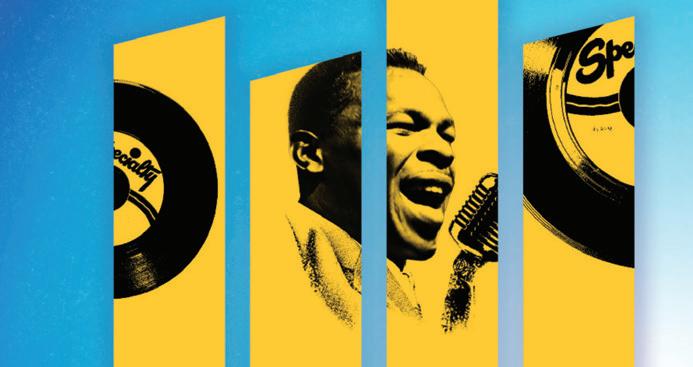











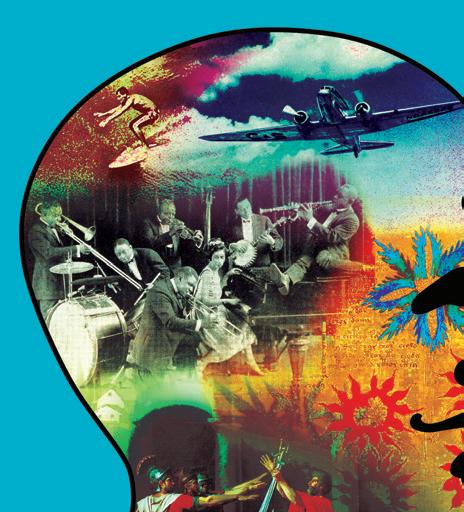


When you’ve been around for decades, paradoxically it’s sometimes easy to be overlooked. I’m reminded of this every time I hear someone ask why Chicago doesn’t have its own fringe theater festival and politely remind them that the Rhinoceros Theater Festival (more commonly known as Rhino Fest) is right there
First presented in 1988 as a two-day theatrical add-on to the Bucktown Arts Festival, featuring original work by Curious Theatre Branch cofounders Beau O’Reilly and Jenny Magnus, Rhino Fest has been a staple in various incarnations every year since, except during the COVID-19 shutdown of 2021. They had just concluded the 2020 festival when the pandemic took hold, and last year’s smaller-scale festival was billed as “A Hint of Rhino.” (It was also a celebration of Curious’s late managing director, Matt Rieger, who died in fall 2021.)
Over the decades, Rhino has moved from fall to winter to spring, and from Bucktown to Lincoln Park, Rogers Park, Avondale, and other parts in between. But the constant has been an emphasis on new work, emerging artists, and accessibility for both the participating companies and for the audiences—you know, like a fringe festival. Companies selected to participate don’t pay rental fees (they are responsible for their own production costs otherwise), and they keep a portion of their ticket sales. It’s a low-risk way for shoestring companies to get their work out in front of an audience that generally relishes the gritty and the o eat.
Magnus and Curious company member Julia Williams have been taking the lead this time in bringing Rhino back from the COVID wilds. With four venues spread over three neighborhoods, and over 40 shows, it’s a more ambitious (and daunting) undertaking than
34TH ANNUAL RHINOCEROS THEATER FESTIVAL
6/2-7/1: performances at Facility Theatre ( 1138 N. California), Chicago Dramatists ( 1105 W. Chicago), Labyrinth Arts (4477-A N. Elston), and Color Club (4146 N. Elston). All tickets pay what you can ($20 suggested price). For complete schedule, see rhinofest.com.
Rauly Luna and El Bear present 84th Annual Willoughby Telethon as part of this year’s Rhino Fest. VIV CALDERON
recent Rhinos. For many years, the festival used Prop Thtr’s two-venue space in Avondale, but Prop gave up their theater during the shutdown.
“It’s definitely a Rhino zero-to-60 this year,” says Magnus. “I think part of it is definitely trying to figure out what we’re really doing post-Prop, because we did it there for so long. And it really was kind of the perfect situation in terms of many shows that could happen at the same time in the same place, et cetera.”
This year, the venues include the traditional black-box Chicago Dramatists space in River West, as well as venues already known for o ering nontraditional performances: Labyrinth Arts and the Color Club, both in Irving Park, and the Facility Theatre in Humboldt Park. Diane Hamm, executive director at Labyrinth, was the managing director at Prop for several years, and Kirk Anderson, the artistic director for Facility, has also known Magnus and the other Curious Theatre Branch ensemble members for a long time.
Rhino (and Curious) have always felt like a family a air, and not just because of literal family connections. (Prop Thtr was cofounded by Magnus’s husband, Stefan Brün.) People are brought into the creative fold at Curious who don’t necessarily fit the traditional mold of actors looking to audition or playwrights looking for commissions. Instead, there’s been a mix of people who return year after year to try out new material, and artists who are new to town finding an unexpected home with Rhino.
Williams notes, “I moved here about ten years ago, and kind of tangentially knew Jenny and Stefan and got put into the Rhino as a helper—one of the people who would run tech, be in the space, open the door, get the Coke outta the fridge, whatever was needed. And I think that kind of introduction was really wonderful. I don’t have a theater background. I didn’t go to theater school. I was never cast in things as a kid cuz I didn’t know how to talk loud. And I was kinda awkward. So to happen into this group of people who would just welcome you and say, ‘Yeah, sure, we’ll see what you can do and go from there’—it was pretty terrific.”
Rauly Luna and his company, El Bear, return to Rhino Fest this year with 84th Annual Willoughby Telethon , a comedy about three

coworkers tasked with running a fundraiser for their terrible company and turning it into a pro-union message of hope. Originally from southern California, Luna and his El Bear cohorts stumbled onto Rhino Fest shortly after moving to Chicago. Their first Rhino appearance was with Luna’s play The Book in 2017, and they’ve been a part of Rhino ever since.
Luna says, “It gave us an opportunity to put our work out there and try to build some sort of an audience or just let people know ‘Hey, we’re here. This is what we’re doing. This is kind of what we’re about.’” El Bear’s play goes up three Mondays (June 5, 12, and 19) at Labyrinth.
Among the other pieces in this year’s eclectic lineup: Wallace Shawn’s disturbing long monologue, The Fever , about a man of privilege confronting atrocities in “poor” countries, performed by David Shapiro. Shapiro (brother of former Steppenwolf artistic director Anna Shapiro) first did the piece to great critical acclaim in 1992, and he remounts it for one performance only at the Facility on June 3.
Magnus, one of the former lead singers of beloved underground cabaret rock band Maestro Subgum and the Whole, also used to do a solo show of “standards and fake standards” in the early 90s. She’s returning to that concept at Facility on June 24 with “Whistling J Walter” (aka singer and former Reader critic Justin Hayford) in Standards. Poet and performer John Starrs, who the Rhino producers believe is the only person featured in every Rhino Fest, takes the stage in John Starrs Has More to Say at Facility June 4 and is also the focus of the tribute show A Neighborhood of Starrs at Color Club on three Saturdays (June 3, 17, and 24). More traditional plays (or as traditional as Rhino gets) are on tap at Dramatists, with early 20th-century American feminist playwright Alice Gerstenberg’s comedy Fourteen running Sundays June 4-25.
“One of the things that’s so beautiful about Rhino is the generational aspect of it,” observes Magnus. “It’s not all young people, it’s not all older people. It’s really a mix. And we’re trying to accommodate first-timers who are middle-aged, first-timers who are very young, people who are coming back, people who have just plugged through the whole thing. They do it because they want to do it. That’s it. And so I think that’s the nice thing about Rhino too. As we always jokingly say, ‘The Rhino contains multitudes.’” v @kerryreid





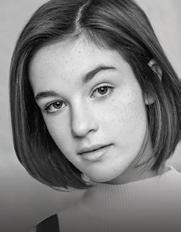
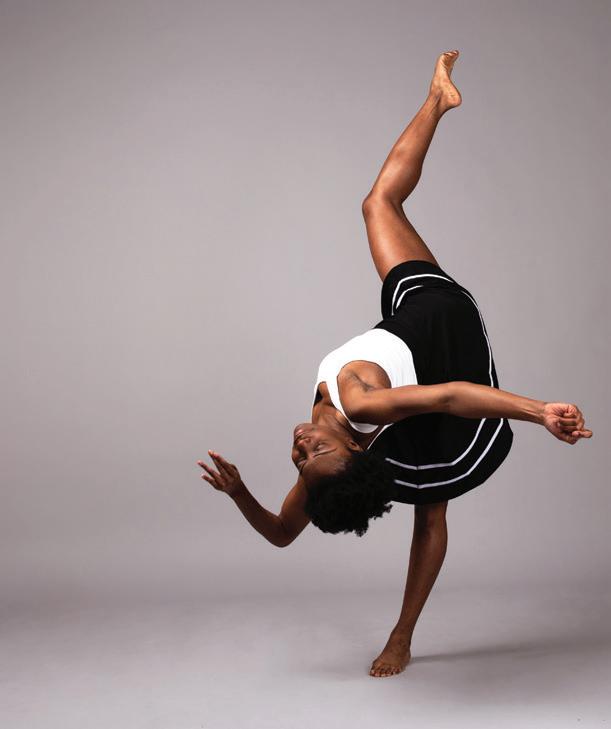



















THE MUSIC OF THE LORD OF THE RINGS FILMS: A COMPREHENSIVE ACCOUNT OF HOWARD SHORE’S SCORES BY DOUG ADAMS Alfred Music, book and CD, 401 pp., $59.95 alfred.com/the-music-of-the-lord-of-the-rings-films/p/98-36329/
MOVIE SCORES

Twenty years a er the trilogy’s conclusion, the local author reflects on working with composer Howard Shore.
By EMILY MCCLANATHANThe tin whistle that introduces the idyllic Shire, the Hardanger fiddle that sweeps over the plains of Rohan, the swelling strings that herald the lighting of Gondor’s beacons—these are just a few of the sounds that are instantly recognizable to fans of Howard Shore’s beloved music from the Lord of the Rings. Since the 2001 premiere of The Fellowship of the Ring, the first installment in Peter Jackson’s adaptations of the J.R.R. Tolkien trilogy, Shore has won three Grammy Awards and three Academy Awards for his work on
these scores—a nearly four-year undertaking that resulted in 11 hours of music for symphony orchestra and chorus. To this day, live performances of Shore’s music draw enthusiastic audiences around the world.
At Shore’s invitation, Doug Adams—a Chicago-based author and musicologist—observed, documented, analyzed, and eventually illuminated the composer’s work in a 400-page book titled The Music of the Lord of the Rings Films (Alfred Music). Published in 2010 after nearly a decade of research, the beautifully illustrated volume includes detailed descrip-
tions of the 90-plus musical themes that Shore composed for the films, narrative analysis that walks the reader through all three scores, translations of choral texts, behind-the-scenes perspectives on Shore’s creative process, and a CD featuring never-before-released music.
With the 20th anniversary of the trilogy’s final film, The Return of the King, approaching in December 2023, I spoke with Adams about the enduring appeal of these scores and his experiences collaborating with Shore. A sought-after expert on this music, Adams has traveled the U.S. and Europe for speaking engagements at “live to projection” concerts, which feature an orchestra, chorus, and soloists performing the score while the film is screened onstage. When ensembles were on hiatus during the early months of the pandemic, Adams participated in a series of music commentaries on the Lord of the Rings and the Hobbit films, which were livestreamed on the popular fan site TheOneRing.net.
As he recounted during our conversation, Adams began writing for the magazine Film Score Monthly as an undergraduate music major, and his first interview with Shore was about the 1997 movie Cop Land. “With the Chicago temperament and the Toronto temperament, we were on the same page—very polite and apologizing to each other throughout the entire interview,” said Adams of his instant rapport with the Canadian composer. The interviews with Shore kept coming, and “we got on very friendly terms. He’d call sometimes and get my parents on the phone. It was like he was Uncle Howard.”
In May 2001, shortly after the news broke that Shore was the composer for the Lord of the Rings films, he asked Adams if he would want to be involved in some way. “I was dreaming very small but still very excited,” Adams recalled. Months went by, and in October, an unexpected package from Abbey Road Studios arrived at his home—the score for The Fellowship of the Ring with a card that read, “For your ears only.”
Adams was “entranced” as soon as he listened. Shore had been a surprising choice for these films, since he was known not for fantasy epics but for working with directors such
as David Cronenberg, Martin Scorsese, and Tim Burton. “If you think of the composers that people were predicting would get it, we all kind of pictured this late Romantic—late 1800s, early 1900s—type of sound, and what Howard had done was something so di erent,” he said. “It was incredibly compelling.”
Soon after, Adams began to visit Shore’s studio in New York, where he met the music production team, studied the scores, and recorded commentary with the composer. In 2003, he attended the recording sessions for The Return of the King. By this time, “we had so much information, it was kind of like, ‘Well, it has to be a book,’” he recalled. After several more years of research, writing, and experimentation with di erent formats, The Music of the Lord of the Rings Films finally came to fruition.
In a book as meticulous and ambitious in scope as the scores themselves, perhaps the most impressive element is the way Adams balances accessibility with in-depth analysis, appealing to readers with or without prior musical knowledge. “You can talk about abstract music stuff and it’s interesting to musicians, but as soon as you tie it to a character or an event, it’s storytelling, and people understand it,” he explained. “It engages your attention to want to figure out the technicalities of it.”
There are countless details to dig into, for those who are so inclined. Shore structured the Lord of the Rings scores around dozens of leitmotifs, which are recurring musical devices that each represent a certain element of the story—in this case, Middle-earth’s cultures, locations, characters, and even objects (the One Ring has four distinct themes). Throughout the trilogy, these leitmotifs develop, expand, and overlap as the hobbits encounter new friends and foes on their perilous quest.
“I think there was a bit of freedom in the knowledge that Tolkien properties tend to have an evergreen quality to them,” said Adams. “People come back and keep looking at them, so to keep writing something as musically complex as the stories are literarily complex—I think [Shore] felt freedom that way.”
The composer also incorporated Tolkien’s
invented languages into the scores through passages for full chorus and vocal soloists. The film’s cowriters, Philippa Boyens and Fran Walsh, along with David Salo—an expert on Tolkien languages—collaborated to create lyrics that feature the Elvish languages of Sindarin and Quenya, the Dwarves’ Khuzdul, Old English and Adûnaic from the race of men, and Sauron’s Black Speech. Adams’s book includes translations for all the lyrics, which are a mix of verbatim Tolkien texts, adaptations, and original works inspired by his writing style.


“I think [Shore] knew from the outset that he wanted a choral element in these scores,” Adams explained. “The filmmakers knew that in adapting these stories, you’d have to cut out some of the prose; some of it isn’t really deliverable as lines. For the real Tolkien diehards who are going to look under the hood of everything, it was a way to get that back into the films.”

Reflecting on the abiding popularity of Tolkien’s books, Jackson’s films, and Shore’s music, Adams noted that they combine masterful world-building with poignant storytelling.









“The Lord of the Rings is always appealing to the next generation, but the generations that have held it before never quite give it up. It’s an interesting mirror because as we continue to get older, that story is exactly where it was,” he said. “Fables are like that. They feel like they should be a young person’s story, and maybe on the surface they are, but then you get into it and there’s a lot of truth in it that we understand as adults. Howard got all of that into the music.”
For Adams, his memories of working on The Music of the Lord of the Rings Films will always be intertwined with his own journey through early adulthood—traveling to new places, meeting his wife, buying a home, and “having Howard around as an incredible mentor to take me into the world of music.”


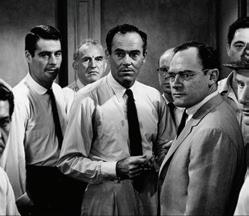


“The Lord of the Rings is, in a lot of ways, a story of growing up, and it was very much that time in my life too,” he said. “As this project grew up and went out into the world, so did I.”
@Emily_221B





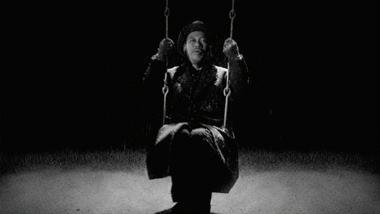
Now is a very bad time to have sympathy for the devil. But apparently Sebastian Maniscalco is unable to read a room, which is all the more baffling due to the simple fact that it’s his job as a stand-up comedian.
He’s playing a version of himself in About My Father, and the opening narration of his life will be familiar to more than the children of immigrants, since the onscreen experience of Italian American cultural assimilation is now so commonplace as to become a trope in itself. But unlike most millennial men, Sebastian is doing very well, running a boutique hotel and cultivating a loving relationship, albeit with a woman who is far from the nice Italian girl his hairdresser father Salvo (Robert De Niro) envisioned.
The bubbly blonde artist Ellie (Leslie Bibb) is the descendant of wealthy colonizers who can trace their history to the Mayflower, and when Sebastian makes it known to his father that he’s going to propose, he’s roped into bringing Salvo for a weekend visit to his intended’s summer home for their Fourth of July celebration. May the culture clash commence!
And clash it does. Only this spin on Meet the Parents and Guess Who’s Coming to Dinner is somehow bizarrely more interested in lazy schtick and attempting to prove that passive aggressive WASPs are just like us rather than in holding them accountable in any way, even though senator matriarch Tigger (Kim Cattrall) has been accused of being anti-immigrant. If there’s sympathy for anyone, it’s not for Sebastian, who is more than willing to cozy up to his in-laws by any means necessary, including disrespecting the father who’s smart enough to call them on their classism.
By the movie’s end, the real joke is how far it takes
smiling white obliviousness—to the point that an actual model minority makes an appearance at the end, and every privilege extended to Ellie and her siblings is chalked up to families just wanting the best for their kids. But what’s more American than the 1 percent smiling in the face of blood money while hiding behind a family name and claiming to have the same interests as the very people they most despise? —ANDREA
THOMPSON PG-13, 89 min. Wide release in theaters
Early on in Fast X, the not-quite-final entry in the Fast and Furious series, Alan Ritchson as the new (and conspicuously jacked) government agency chief says of Dominic Toretto (Vin Diesel) and his crew of dragracers-turned-secret-agents, “If it could be done in a car, they did it. If it violates the laws of God and gravity, they did it twice.”
It could take hours to detail all the plot twists, double-crossings, and reappearances of dead characters alive but stricken with amnesia that have taken place over the course of this never-ending macho soap opera, but that quote covers the gist of it. Fast X continues the franchise’s mission to scale bigger and campier heights with each movie, and there are moments that will have you full-volume hooting and hollering in your seat, but it’s undone by the gravest sin of this cinematic universe: it breaks up the family.
A er nearly leveling Vatican City during a heist gone wrong, Dom’s squad splits up across four cities into parallel subplots of wildly uneven entertainment value, the bottom rung of which is occupied by John Cena and Leo Abelo Perry as Dom’s brother Jakob and young son Brian, respectively, on an uncle-nephew bonding trip that involves Jakob driving a beat-up Nissan cross-country and introducing Brian to Marky Mark cassettes.
READER RECOMMENDED
Get showtimes and see reviews of everything playing this week at chicagoreader.com/movies
Every time it cuts away from them to villain-of-the-week Dante Reyes (Jason Momoa, decked out in dangly jewelry and a purple scrunchie), it’s a blessing—Momoa’s performance is cranked up to 11 at all times, injecting a jolt of energy into a film that can occasionally feel like an off-brand Roger Moore-era James Bond movie. Dante occupies a space somewhere between the Joker and a more sinister cousin of NoHo Hank from Barry acting as the most perfect and outrageous foil to Dom’s no-nonsense action hero persona.
Straight-faced presentation of increasingly unhinged plot developments—like, say, Ludacris and Tyrese Gibson driving a sedan directly into outer space—is pretty much the entire appeal of this franchise, but it turns out it can be a blast to see someone let loose and lean harder into this being the exact halfway point between All My Children and Adam West’s Batman —JOEY SHAPIRO PG-13, 141 min. Wide release in theaters
On paper, Kandahar certainly sounds like a typical Gerard Butler action fest: a CIA agent stationed in Afghanistan is covertly working on an operation “bigger than Snowden and WikiLeaks combined,” but before he can follow through with it, his identity is exposed and he instantly ascends to the top of the Taliban’s most-wanted list. He and his interpreter have to attempt an escape through the harsh Afghan desert to get picked up and brought home, but the terrorists are close behind, and, well, you can imagine where this is going—there are helicopters, rocket launchers, night vision, the works.
Yet while all of these Butlerisms do make their appearances, this isn’t his usual schtick. Instead the movie goes for gritty, The Hurt Locker-style docurealism, which in the right hands could be an exciting project for Butler to prove he’s got the dramatic chops to match his action ones. Director Ric Roman Waugh isn’t Kathryn Bigelow, though; he’s the man behind roid-rage Gerard vehicles Angel Has Fallen and Greenland, and behind the veneer of insistent self-seriousness, this isn’t much more sophisticated than either of those movies. It’s John Wayne in the Afghan desert, a bizarrely somber drama of a lonesome stranger trapped in a country depicted as monolithically barbaric.
Waugh lingers on shots of white people hanged from construction cranes and gives the terrorists dialogue like, “You’ve slayed the American dragon,” and there’s one scene in which our heroes have to make a split-second decision whether or not to shoot an Afghan child holding explosives that I could swear was ripped verbatim from the aforementioned Kathryn Bigelow movie. Butler looks lost in the role, as if he’s so used to playing Rambo offshoots that he doesn’t know what to do with himself in a movie in which even the Humvee chases are pretty lethargic.
If I’m going to watch this man retcon the war on terror to look heroic, it should at the very least be overthe-top enough to be entertaining. This is the kind of
grim slog that was made and remade nonstop in the late aughts when dourness and a muddy orange color palette were synonymous with legitimacy in genre movies.
If this is the future of Gerard Butler movies, I’m going to need to get a bumper sticker that reads, “I’d Rather Be Watching Plane (2023)!” —JOEY SHAPIRO R, 120 min. Wide release in theaters
The story goes that 1989’s The Little Mermaid saved Disney Animation from near demise and kicked off an era known as the Disney Renaissance, producing movies that are now considered House of Mouse classics, from Beauty and the Beast to The Lion King Rob Marshall’s live-action adaptation attempts to do the same for the live-action Disney era that has divided audiences and critics with some hits and some misses. The 2023 retelling faced almost-immediate backlash in the casting of Black American actress Halle Bailey as Ariel, our titular mermaid who has pale skin in the original but is still, for all intents and purposes, literally a fish without a race. Nevertheless, the film’s director has continuously sung her praises, and Bailey truly shines in a movie that is otherwise drowning in familiarity.
In the 15+ live-actions Disney has made, some opt to stray from the original plot of their predecessor, and it’s tough to know how audiences will react: 2020’s Mulan was received well by critics, but fans mourned the loss of Mushu, the hilarious dragon voiced by Eddie Murphy. The Little Mermaid remake follows the original almost beat for beat. There are a few new songs very obviously courtesy of Lin-Manuel Miranda. Prince Eric (played charmingly by relative newcomer Jonah Hauer-King) is rounded out with more backstory that’s merely implied in the original. And although the newly diverse casting is welcome (including Ariel’s multicultural mermaid sisters, whom we don’t see enough of), the movie doesn’t do much to modernize a story with an implicit message that still involves a woman giving up her voice for a man.
And yet it can’t be denied that the movie is fun from start to finish. Bailey, who rose to stardom as half of the duo Chloe x Halle, has a voice that was made for a Disney princess. Her range is incredible, soaring across high notes with an ethereal tone that sends chills down your spine in her rendition of “Part Of Your World.”

And considering that she doesn’t speak for at least a third of the movie, Bailey’s acting remains engaged and expressive. The surrounding cast (Awkwafina as Scuttle, Daveed Diggs as Sebastian, Melissa McCarthy as Ursula) hold their own, though the uneven pacing gives them less to work with, and the Jamaican American woman next to me in the theater scoffed at Diggs’s attempt at a Caribbean accent.
Overall, it’s a visually gorgeous film, buoyed by a strong ingenue in Bailey with enough laughs for the kids and the nostalgic adults—just don’t expect anything new. —NOËLLE D. LILLEY PG, 135 min. Wide release in theaters
































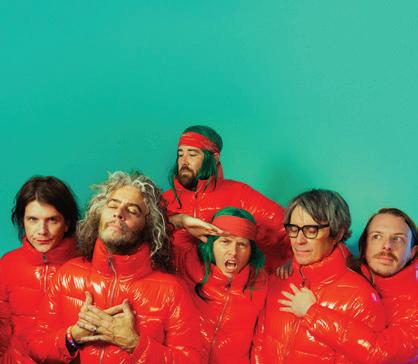




































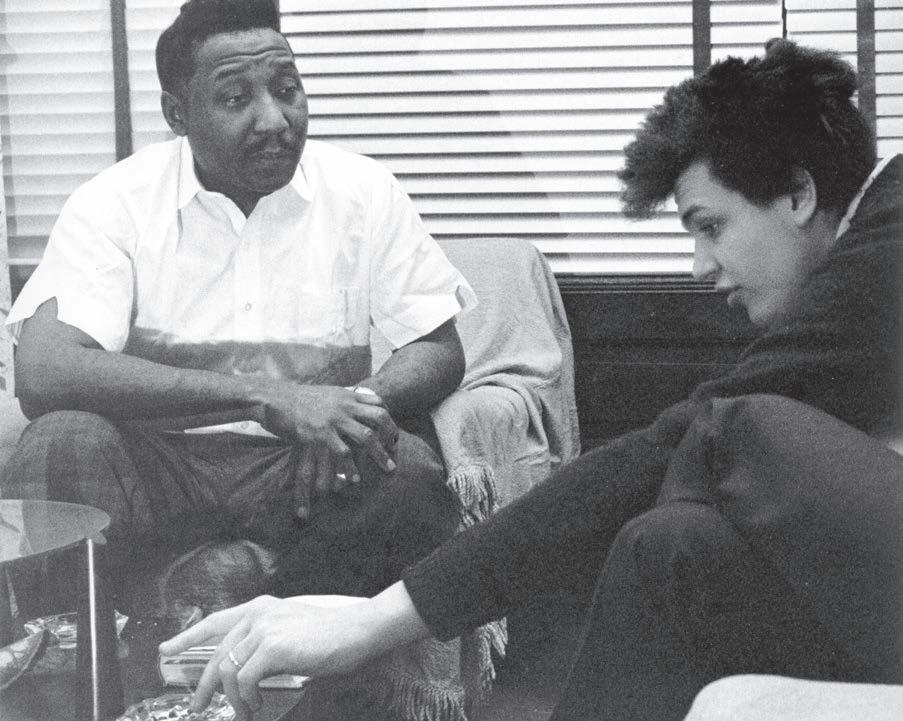
Screening as part of the Chicago Blues Festival, the film documents the friendships between Black postwar bluesmen and the young white rockers who learned at their feet.
By JAMIE LUDWIGIn the 1960s, Chicago blues changed rock ’n’ roll so dramatically that it’s still easy to overlook the magnitude of its impact. British bands (the Rolling Stones, Led Zeppelin, Cream) are often credited with introducing the blues to white American kids by paying homage to records by Chicago artists such as Muddy Waters, Howlin’ Wolf, and Little Walter. But that narrative overlooks the young white Chicagoans who forged friendships with those artists (and others) and learned from them directly. That overlooked story is the one that directors John Anderson (who lives in Evanston) and Bob Sarles (who lives in San Francisco) aim to tell in the documentary Born in Chicago. Named after the Paul Butterfield Blues Band song, their film opens with an overview of the history of Chicago blues: its origins in the deep south, its migration to the city, the explosion of creativity in local clubs and at the famous Maxwell Street Market, the rise of career-making labels such as Chess and Cobra. By the early 60s, though, most Black youth had moved on to newer sounds, mainly soul
and R&B. At the same time, a handful of young white musicians—including teenage guitar prodigy Michael Bloomfield, harmonica player and vocalist Paul Butterfield, and keyboardist Barry Goldberg—were discovering the blues on their own. The music wasn’t old-fashioned to them, and they flocked to south-side clubs, where they were invited to play and eventually mentored by their heroes. The rest, as they say, is history.
“This film is about the passing of the torch from the originators of post-World War II Chicago electric blues on to the next generation,” Sarles says. “And it just so happened that this next generation they passed on to were a bunch of white middle-class kids.”
Born in Chicago will make its local debut at the Chicago Cultural Center on Friday, June 9, as part of the Chicago Blues Festival. A Q&A with Anderson, Sarles, and Howlin’ Wolf’s daughters, Bettye Kaye and Barbra Marks, will follow the screening.
I spoke to Anderson and Sarles about their film’s long journey to the screen and why its story still resonates. Our conversation has
been edited for length and clarity, and a longer version is posted at chicagoreader.com.
Can you walk us through the production history of this movie?
John Anderson: In 2008, I was shooting a concert at Park West starring the Chicago Blues Reunion, which was Barry Goldberg, Harvey Mandel, Nick Gravenites, and Corky Siegel. It was a great show, and we shot interviews around it with [Born in Chicago executive producer] Timm Martin. As the interviews were happening, a story was developing of these ten or 12 tough white kids who not only had the temerity to show up at these clubs where there was no one like them, [but also] when they were invited up onstage, they could play. And that’s what made the di erence. As Nick says in the film, “If you couldn’t play, you were gone immediately.”
As the story became clearer, the way they brought the hard edge of Chicago blues to rock ’n’ roll—we knew there was a film there. So Barry Goldberg, the keyboardist, and I did
interviews around the country with the various principals and finished a cut in about 2010, 2011. It played at the Siskel Center, the Lincoln Center, at South by Southwest, and a couple of other prestigious showings, but it hadn’t sold. I needed to move on to other work. So the film languished for a while, and then Bob came into the picture.
Bob Sarles: Around the time that John was working on this picture, I was working on a parallel film about Michael Bloomfield, which got released in 2014 on a box set that Sony Legacy put out and Al Kooper produced. So I was mining a lot of the same territory. John did a really good cut of the first version of the film. But something happened where it got to the point of diminishing returns, and it was not in a great place.
This was years after John had left the project. The people behind the project found myself and my filmmaking partner, Christina Keating, and asked if we could fix the film. By the time I inherited it, the arc wasn’t really clear. It was like a lot of di erent short films
that had been stitched together. [Music critic Joel Selvin] wrote a really exhaustive outline and a script, which became the blueprint Christina and I followed. When we were done, John’s material was so much a part of the film’s DNA, it’s as much his film as it is mine. What Christina and I did was give it a structure, and we put a little bit more effort into finding archival footage to support it. That said, John had already discovered and gotten into the archival footage that was Sam Lay’s home movies.
JA: Sam Lay, the legendary blues drummer, came along at the right time, and he had all these films under his bed. I kid you not—they were under his bed. If he hadn’t made these a ordable to us, I don’t know if the film would’ve gotten as far along as it did or gotten finished at all.
Is this the first official release of some of the archival footage?
JA: Yeah. I used a lot of Sam’s footage in my film Sam Lay in Bluesland and a little in my Paul Butterfield film [Horn From the Heart]. What’s cool about it is that the people being shot recognize Sam behind the [camera] light, and they light up. It brings a life and a warmth to it that sometimes more traditional archival footage doesn’t.
BS: Some footage I know has not been seen before is the footage of the afternoon show of the Paul Butterfield Blues Band at Newport ’65. There was other footage that Murray Lerner used in the
The influence of blues, and electric blues specifically, is so ubiquitous in rock music we take it for granted. Watching this film, you realize this is the moment Chicago blues became a larger part of pop culture. Would you agree that these are the guys who bridged the gap?
JA: Yeah. There was an axis in rock ’n’ roll and blues. This was a next step that led to the birth of a bunch of young careers and a rebirth of the careers of their mentors. That was the beautiful, cyclical part of it.
BS: The story that’s told is that America learned about its own culture from the British,
that the blues had migrated over to England through records coming through Liverpool and London. The guys in England—Eric Clapton, Brian Jones, John Mayall—learned the music off of records. They got the records, they studied them, they adored them. Then eventually, these cats started coming over in the blues festivals in the mid-60s, and they got to see their heroes in person.
But our crew here—Bloomfield, Butterfield, Elvin Bishop, Charlie Musselwhite, Corky Siegel, Harvey Mandel, Nick Gravenites, Steve Miller, all these cats—had learned at the feet of the giants. They broke bread with them, they babysat their kids, they became part of their family, they became part of the culture. They weren’t removed and learning it mechanically o of the record. They were learning it from the guys, and they were absorbing their lifestyle, their attitudes—and mostly their love.

We really tried to make that point. [The Brits] were very important, but these guys were more important—because as soon as they got some traction with their careers, they insisted to the promoters, “You need to hire Muddy, you need to hire Howlin’ Wolf, you need to learn who the originators are.”

That directly a ected the older generations’ ability to make a living. Suddenly, they weren’t just playing small Black clubs and the chitlin’ circuit; they were playing on college campuses, they were playing in the psychedelic ballrooms in San Francisco, Detroit, and New York. They were playing in Carnegie Hall and on The Ed Sullivan Show. That wouldn’t have happened had it not been for these guys.

As we’re doing Q&As at the film festivals, one thing people are concerned about is, “Is this a story about cultural appropriation?” It’s not cultural appropriation in this case, because cultural appropriation implies two things. One, it implies a theft. There was no theft here. This was a direct gift from Muddy, Howlin’, and their colleagues to this next generation. They knew what these kids were about, they knew their potential, and they gladly passed on their knowledge.
The other thing cultural appropriation means is theft with no payback. Not only was this a gift, there was immediate payback—as soon as these kids started getting traction, they passed it on.
What are some surprises you had making this movie?
JA: One of my favorite moments was seeing firsthand the love that still existed at the time of our interview, say, between Barry Goldberg and Hubert Sumlin. It had been probably 15 years since they’d seen each other. Hubert was a god to Barry, and Barry was like, “Is he even going to remember me?” And he walked into the room and Hubert was like, “Oh my God, Barry—is that you?” He put his arms around him, and we all started crying. That’s where it really hits—this is more than just a story about great music. It’s about great human relationships, and I think it’s had a positive influence on the whole world.

Tillmon
Anyone under the mistaken impression that blues music is depressing has never seen Chicago guitarist Smiley Tillmon in action. He radiates positivity, right down to the jokes he slips in between songs. Even his professional nickname—bestowed by his former boss, bassist and bandleader Singing Sam Chatmon—is about how much he enjoys making music.
“My real name is Moses,” says Tillmon. “He said, ‘Man, you look like you’re having fun all the time, but Moses sounds like a preacher. I’m going to call you Smiley!’ This was in ’62. And I’ve been wearing that name for 60 years!”
One of the busiest blues performers on the local scene, Tillmon still brings that good-time vibe to his shows. “Bottom line, I just like to play,” he says. “When you get around people that act like they enjoy what you’re doing, that makes it worthwhile.”
The band Tillmon will lead at the Chicago
Blues Festival on Friday evening—bassist Tom Rezetko, guitarist Kate Moss, and drummer George Baumann—has had an uncommonly stable lineup. Tillmon and Rezetko teamed up in 2007, after meeting at a jam in Blue Island. Tillmon had just retired from 30 years of working for Midlothian School District 143 as a maintenance man and custodian.
“Kate’s been with us for ten years—maybe even more—and our drummer’s been with us nine years. They’re really good people,” says Rezetko. “Obviously musically, but on a personal level also.”
Their set list goes heavy on blues and R&B standards, but they can make those chestnuts feel fresh again with Tillmon’s boisterous vocals and imaginative guitar work, Rezetko and Baumann’s steady grooves, and Moss’s counterpoint leads, which bear the influence of Magic Sam and Freddie King.

Tillmon’s early musical journey, which landed him in Chicago in 1962, is unlike the
backstory of anyone else from the city’s golden era of the blues. Born in rural Jefferson County, Georgia, Tillmon picked cotton as a child before his mother brought him to Fort Lauderdale, Florida, when he was ten.
While working as a busboy at a local hotel, a 15-year-old Tillmon saw an unusual musical act. “They had this guy called Calypso Eddie. He was really cool, man. He had a guitar, drums, and a saw. The guy played the saw with a kitchen knife! It sounds crazy, but it sounded good,” Tillmon says. “I got enough money to go to the pawn shop to get me a guitar. Saved up $10. But it worked, so I got me a couple of chords.”
While still in high school, Tillmon found more early inspiration at the Palms of Hallandale, a major venue north of Miami. “They had what they called teenage night,” he says. “I saw Little Richard. This was like ’56, ’57. Bobby Bland, Ray Charles, and James Brown before he got to be the Godfather—all these guys
would come through there. But I tell you who used to kill it was Little Willie John.
“Who really inspired me to play was this group called Hank Ballard & the Midnighters. And Cal Green, this guy played that guitar [for them]. The chicks were hollering and screaming. I said, ‘Man, I want to do that too!’” Tillmon recalls. “Another group I liked was the ‘5’ Royales. They could get it too. And I liked the way the guitar player had them hot licks in there—El Pauling.
“I got out of school, which was in ’57, ’58. Caribbean music was pretty cool, so I learned to do some of that and little doo-wop songs, that kind of thing.”
While playing behind a vocal group called the Breezes at Fort Lauderdale nightspot the Downbeat, Tillmon was spotted by local R&B singer Billy Miranda. “He liked what I was doing, and I could sing fairly well. He was living in Fort Lauderdale at the time, but he got this job in Miami at a place called the James Club,” says Tillmon. “So me and this boy named Eddie Hope, we moved down there with him.”
Not only did Miranda and his band settle into the James Club for an extended stay, but they also cut the explosive rocker “Run Rose” for Chicago’s Checker Records in 1960 at Bobby Duko ’s North Miami studio with Hope on drums and Tillmon on guitar.
Tillmon’s next musical opportunity walked through the door of the James Club during his gig with Miranda. “Sammy Ambrose and them came in there, and he was telling me, ‘Hey, man, I like what you’re doing, but we’ve got a group. We’d like to hear you come sit in with us.’ They were playing that Caribbean music then,” Tillmon says. “We were a bunch of kids just having fun. We had a good show too. We were called Caribbean Carnival. Sammy could do the limbo and all that kind of stu , and we had dancing girls. It was a revue.”
Tillmon toured as a member of Ambrose’s group, the Afro-Beats, from the Catskill Mountains to Canada. They cut a 1961 single in New York for a small Brill Building label called West Side. “We figured, ‘OK, they’ve got the “Peppermint Twist.” We’re going to Canada—we’ll make “The Canadian Twist!”’” says Tillmon, laughing. The Afro-Beats broke up in ’62 when Ambrose went solo. He went on to record the

original soul-steeped version of “This Diamond Ring” in 1964, only to see Gary Lewis & the Playboys’ contemporaneous cover sail to number one on the Billboard Hot 100 chart.



“The other kids went back to Florida, and I didn’t want to go back there,” says Tillmon. “I had met some people in Montreal that lived in Chicago, so I decided to come to Chicago and check that out.” He quickly hired on with Singing Sam & the Sparks. “I stayed with him for about 15 years,” he says. “We did very well. We worked a lot on the north side.”

That wasn’t Tillmon’s only gig, of course; he also backed keyboardist Billy “the Kid” Emerson in the mid-60s, when Emerson was mentoring newcomer Denise LaSalle. “She didn’t have the right kind of timing, so I guess her and Billy got together,” he says. “He was a good teacher.”



Succeeding on the local blues circuit required Tillmon to make some tweaks to his style and repertoire. “I found out Chicago was a hotbed for the blues, so I had to learn to do that to try to pay the rent,” he says. “I used to work at Buddy Guy’s place before he got real famous, a place called the Checkerboard. And
we worked at a place called Pepper’s, and other lounges and things. We had to work them long hours, man, but hey, it was a learning process, and I loved doing it.”
After 15 years as a working musician in Chicago, mostly on the south-side circuit, Tillmon cut back to part-time status in the mid-70s. He needed a steadier income to support his wife and five kids, so he took the first of a couple day jobs. “I love the blues, I love everything else, but I love God and my family more than anything,” he explains.
More than three decades later, Tillmon finally retired from the daily grind—and since then he’s been back to full speed ahead musically. He’ll turn 83 on June 16, a week after this Blues Festival set, and he and his band are keeping up a full schedule.

“I do the best I can. I work hard at what I do. I love the game, because I think I owe it to the people that come to see us,” says Tillmon. “Until the day I die, I try to keep it as honest as I can and just try to be the best Smiley I can be.”







than to Chicago. His one-chord vamps recall Mississippi juke-joint giants such as R.L. Burnside and Big Jack Johnson. He has a few Chicago-style shuffles in his repertoire, but for the most part his sound recalls the hill-country greats—an influence you rarely hear in the Windy City. Doroba insists he’s just playing regular old “boogie,” though, not something specific to any region.
Longtime busker Brian Doroba plays with his band on Michigan Avenue for the crowds leaving Millennium Park a er the night’s last set.
By JAMES PORTERLive blues music is even better outdoors in the summertime. Folks definitely understood that at the old Maxwell Street Market, which became a grassroots hot spot for the blues before World War II. Lots of Chicago fans are old enough to remember the market in the 1970s, ’80s, and early ’90s, when the likes of Pat Rushing and Willie James would set up shop with their bands at eight in the morning and play on sidewalks or in vacant lots.
For the past 12 years, 35-year-old singerguitarist Brian Doroba has been keeping that tradition going, becoming one of the most visible blues artists in Chicago even though almost nobody knows his name. Doroba has bypassed local clubs almost completely, but you’ve probably seen him if you go to summer festivals downtown.
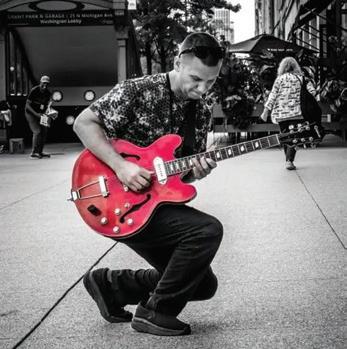
He has a regular trio, though he’ll play whether they can show up or not. Sometimes he’s accompanied by keyboardist Lamar Allen, and when drummer Mark Johnson isn’t
around to hold the rhythm down, Doroba adds percussion with his feet—he uses two drumkit pedals, one to play a bass drum and the other to play a snare drum turned on its side.
Doroba and his sidemen usually set up on Michigan Avenue, positioning themselves as an unofficial “closing act” after the music in the park wraps up for the night. They prefer a spot on the sidewalk in front of the Walgreens at the intersection with Washington Street.

That’s where Doroba plans to be during the Blues Festival—he hopes Allen and Johnson will show up too, along with James Craven, a harmonica player who’s been working with him on and o since 2011. They might also be joined by Chicago gospel-blues guitarist and singer Mississippi Gabe Carter.
Doroba relishes his role as a secret hidden in plain view. “I like the whole ‘underground’ thing,” he says. “You have to find me on the street! I think it would be cool if more blues cats did it!”
Musically, Doroba is closer to Clarksdale
“The boogie thing, that’s what really gets people dancing,” he says. He figured this out during his earliest days busking in Chicago, when he started out in 2011 as a one-man band. “I’d have the whole crowd by myself, not with the band, and I’d have so many people dancing that it would really drive me to keep it going. I’d do these boogies—a boogie song into another boogie song. I just would not stop.” Once Allen and Johnson came aboard in 2016, it freed him up to start strutting around like Chuck Berry.
Doroba started playing music as a student at Eastern Illinois University in Charleston. “I was messing around with the guitar a little bit, jamming with people,” he says. When he stumbled across a Howlin’ Wolf video on YouTube, it got him started down “the rabbit hole of the blues, deep diving into it.”
In 2009 he met singer, guitarist, and harmonica player Deak Harp, who saw him busking at an outdoor university event. Harp has since relocated to Mississippi, but at the time he was living in rural Illinois, not far from Charleston.
“He used to live in the boonies, somewhere in the country,” Doroba says. “It was the first time I tried busking. It was a little street fest that the college was having. Deak saw me playing, and he was like, ‘Aw, man, you know who I am?’ He had this Winnebago with all these blues stickers on it. ‘I do this shit for real!’ I went down to Clarksdale that same year—I actually helped him move down there.”
Though Doroba had discovered the blues through Howlin’ Wolf—an avatar of the postwar Chicago style—he soon fell hard for the hypnotic grooves of the Mississippi hill country. By helping Harp with his move to Clarksdale, he’d put himself in the thick of it, and he stuck around for a festival that happened to be going on that week, watching bluesmen from the region such as Robert Belfour and T-Model Ford. By the time he returned to Illinois, that southern juke sound had become the founda-
tion of his style.
In 2011, Doroba graduated with a degree in psychology. “I was working some job. I was bored—I didn’t like what I was doing. I just wanted to play guitar. I went to school for the wrong thing!” he jokes. “How the fuck do I become a guitar player? I didn’t know that was a career route I could go towards! So then I was like, well, I should probably just play guitar all the time!” At Harp’s urging, he bought a battery-powered amp and hit the sidewalk circuit with a vengeance.
Doroba says the best night his trio with Allen and Johnson has had so far was the Sunday of the 2018 Chicago Jazz Festival. Saxophonist Maceo Parker had headlined, and after his set the teeming masses leaving Millennium Park took the party across the street. “That was bigger than the biggest crowd we ever had,” says Doroba. “It was all just clicking.”
Doroba is philosophical about playing live music on the sidewalk. “Music has to draw people in. It’s not like a show, where people go to see you,” he says. “Just walking past, some people may be going about their day, whatever they’re doing. Maybe they’re just looking for somebody like me, or maybe they’re not at all. I just hope that we’re still allowed to do it. They have tried to ban us in the past. I don’t think it’s gonna go away, man, to be honest with you. I just hope it keeps going and people still have the appreciation for it. From what I can see, it’s got a good future.” v
@JamesPorterCHIThe Logan Center for the Arts at the University of Chicago is a multidisciplinary home for arts practice and presentation. Connect with the Logan Center for concerts, exhibitions, performances, family programs, readings, festivals, and more from world-class, emerging, local, student, and international artists and organizations.

DAVE HERRERO AND FRIENDS
Part of the Chicago Blues Festival. Sat 6/10, 12:30 PM (music starts at noon), Rosa’s Lounge stage (North Promenade), Millennium Park, 201 E. Randolph, free, all ages
Blues in Schools. Over the course of ten years, it reached more than 40,000 kids in Chicago.
The Chicago guitarist’s family history runs from golden-age Dominican dance bands to this year’s Blues Festival and a new group with Cesar Rosas of Los Lobos.
 By SANDRA TREVIÑO
By SANDRA TREVIÑO
My love of music, especially Chicago blues, was strongly influenced by the weekly trips my family took to la pulga, as we called the famous Maxwell Street flea market. I’d never seen anyone sing and wail so passionately. I encountered lots of musicians on those trips in the late 70s and early 80s, but I don’t recall a single one being Latine. That’s partly why, when I looked over the lineup of this year’s Blues Fest, I took such special notice of the name Dave Herrero. I was intrigued, and I wanted to talk to him and learn more about him.
Originally from Clearwater, Florida, Herrero also has roots in the Caribbean, and his family has long had an a nity for music. “From my understanding, there was a priest named Padre Requeña, and he taught my grandfather, Luis Herrero, how to read and write music as a child before he could even read or write words,” he says. “When my grandfather was around ten or 11, he played piano at the silent
movies in La Romana, Dominican Republic. By the time he was 13 or 14, he was writing arrangements and original music for 15- to 17piece orchestras.”
Herrero’s grandfather immigrated to New York City in the late 1920s and soon formed the group Luis Herrero & His Serenaders. He specialized in merengue, salsa, and tango, and he played such an important role in introducing Dominican culture to New York that the Dominican government invited him to represent the country at the New York World’s Fair in 1940. In 1937 he’d renamed his group Luis Herrero y Su Orquesta Dominicana, and that same year he signed with RCA Victor.
About five years ago, Herrero heard from the City University of New York, which was looking for more information about his grandfather. He sent them a digital file containing some of his grandfather’s sheet music, recordings, and photos. They stayed in touch, and during the pandemic the university told him it had found 12 of his grandfather’s RCA
Victor recordings. As a result, Dave is working with fellow Chicagoan Patrick Donley, music director of old-school tropical dance band La Peña Orchestra, on a project to highlight his grandparents’ love story.
“What we’re considering doing is putting together a performing-arts project that would be presenting my grandfather’s original compositions set to actors and actresses acting out the story of their love and their life and traveling from the Dominican Republic to New York,” Herrero says. “My mom, thank God, had my grandmother interviewed when she was about 95 years old to capture her life story, so we have all these details about everything. It’s the most beautiful, romantic stu .”
According to family lore, Herrero’s grandfather met his grandmother, Eunice, at a town dance in La Romana. Then he serenaded her under her window every night for a month with a piano loaded onto the back of his truck, performing a song he’d written especially for her.
Eunice helped pass on this passion for music to Herrero’s father and his siblings by requiring all her boys to learn an instrument, hoping to prepare them to win college scholarships. They had a choice, though, about what kind of doctor they were going to become. “That was it. My grandmother was tough,” Herrero says. “But the passion was there for music for all of them, for sure.”
Herrero’s own fascination with music, especially blues, began when he was in military school in his teens. He and his friends would listen to Jimi Hendrix, Led Zeppelin, and other rock bands. “I started digging further back and began understanding that those bands’ influences were artists like Albert King and Muddy Waters,” he says. “And then, going even further back, to Robert Johnson and Lead Belly. I don’t know, it just kind of got me.”
Bit by the music bug, the kids pooled their money and bought a guitar to share. They would sneak out to local venues to listen to blues bands, and eventually Herrero began performing at blues jams at the same clubs.
In 1996, Herrero graduated from the University of North Florida, where he’d studied psychology and childcare management, and headed to Austin, Texas, to pursue music. In 2004, he relocated to Chicago, and in 2008 he teamed up with a nonprofit called Foundations of Music to help develop a program called the
“We created a curriculum for kids to engage with in the classroom a week before we showed up,” Herrero says. “Then we would do a performance for the kids that would show them the original roots of blues, and how it grew and morphed into soul music and funk music—which then morphed into hip-hop, to keep it relevant for inner-city kids. It was a powerful program.” This particular Blues in Schools program has been absorbed by a bigger organization, though, and no longer exists in that form.
When not on tour, Herrero holds down weekly residencies at Rosa’s Lounge and the Sheraton Grand Chicago Riverwalk. He also performs regularly with singer and violinist Anne Harris (their next gig is on June 17 at the Acorn Music Festival in Three Oaks, Michigan) and with a trio joined by two special guests, guitarist Jimmy Burns and vocalist Katherine Davis.
Herrero also runs the Who’z the Boss Music Library, which licenses tracks to TV shows, films, and commercials. He founded it in the mid-2010s with Parker Lee Williams, a local hip-hop pioneer and longtime music director for Oprah’s production company, Harpo Studios. Sadly, Williams died in late 2021 of a COVID-related heart attack.
More recently Herrero formed a band with Cesar Rosas of legendary Mexican American roots rockers Los Lobos, who headline the Blues Festival’s Sunday-night program. “It’s funny, because it kind of happened organically,” Herrero says. “I’ve known those guys for about 12 years, and they are absolute sweethearts. They’ve been mentors and sources of inspiration for a very long time.”
Rosas, who just bought a house in Chicago, is currently splitting his time between here and Los Angeles. He called up Herrero and told him he was down to play gigs. As Herrero tells it, he laughed and replied, “Really? You wanna do the $100 hustle?” Rosas was on board, and Herrero helped him assemble a lineup. Soon fellow musician Scott Tipping, who’s also working as a booker in Aurora, took an interest in this new band: Cesar Rosas & the Chi-Town Playboys. Their first gig was in January at the Venue in Aurora, and their next is at FitzGerald’s in Berwyn on August 19.
“Playing with your heroes, especially when they’re really good people—this is it,” says Herrero. “This is what I love right here.” v
@sandratrevino
WOMEN IN BLUES TRIBUTE TO DEITRA FARR, KATHERINE DAVIS, AND SUGAR PIE DESANTO
Sugar Pie DeSanto appears on day three of the Chicago Blues Festival, at a tribute set that also includes Lynne Jordan, Sheryl Youngblood, Joanna Connor, Radka Kasparcova, Sherri Weathersby, Roosevelt Purifoy, Dujuan Austin, and Johnny Iguana. Sat 6/10, 2:30 PM (music starts at noon), Jay Pritzker Pavilion, Millennium Park, 201 E. Randolph, free, all ages
Sugar wore to destroy Chicago, and her most enduring proved to be the 1966 duet “In the Basement,” with DeSanto and childhood friend Etta James taking over a blue-light house party.

My devotion to the four-foot-eleven powerhouse has been sated by occasional new recordings and vault discoveries—the Charles Stepney-arranged “Witch for a Night,” first released on a 2009 compilation of her ’60s Chess singles called Go Go Power, will hex you too. Our one-sided relationship peaked when I helped interview her in the late 90s—she’d long been back in the Bay Area, where she grew up, but she’d returned to Chicago to play Buddy Guy’s Legends. The hour I spent backstage being utterly ignored as she howled foul-mouthed reminiscences at Chicago R&B royalty might be the best date I’ve ever been on. As DeSanto returns to be celebrated by the city where she recorded her best songs and played some of her greatest shows (she shared the bill on Tina Turner’s first Chicago date, in 1960 at the Regal Theater), I expect scores
of new fans to flip for her like I did decades ago. At least they can’t get fired by James Brown. v
Little Miss Dynamite turned 87 last fall, but the fierce, soulful R&B she wrote and recorded in the 1960s hasn’t aged a day.
 By JAKE AUSTEN
By JAKE AUSTEN
When I say I love Sugar Pie DeSanto, I mean it. I’d never heard of her in 1987, when her first retrospective compilation was released, but I was so stunned by her beautiful smile on the cover that I bought it without a listen. I was enchanted by her formidable voice growling empowered anthems about taking charge of relationships, parties, and fashion. I once dated a woman because she had the same smile, and I called her Sugar (a consensual nickname—she knew I’d worn that record out, and she liked me because she thought I sang
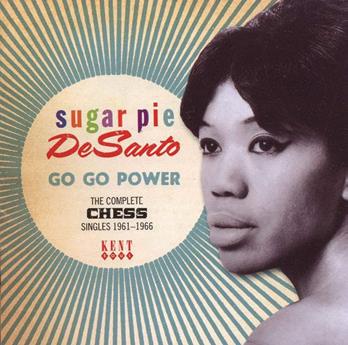
like Danzig). Meanwhile I dutifully collected Sugar Pie DeSanto’s discography.
Umpeylia Balinton, born October 16, 1935, became Little Miss Sugar Pie when touring with R&B singer and producer Johnny Otis in the 50s. After the 1960 release of her biggest hit (the charmer “I Want to Know”), she hit the road for a spell in James Brown’s revue (a gig allegedly shortened because her backflips upstaged the Godfather). She then spent the rest of the decade in Chicago recording and writing fierce material for Chess Records. Her biggest success from those seven years was the 1964 tune “Soulful Dress,” a description of what
“Drone Sleepover takes the concept of the show and stretches it into eight to ten hours, so people can enter that space and do some quality listening.”
As told to MICCO CAPORALE
Gray Schiller didn’t expect to be running a nonprofit at 26. From middle school through college, they were relentlessly focused on becoming a folk singer. After growing up in the North Shore area, they moved to New York to attend the Pratt Institute. “I wanted just to make music, but my parents wanted me to go to college,” Schiller says. “So I thought, ‘Oh, I’ll go to art school! Then I won’t actually have to do college things!’” Through a chance encounter in a gear-oriented Facebook group, they connected with Will Karmis, another native of the Chicago suburbs living in the Big Apple. Their first night jamming together, Karmis introduced them to ambient music, and the two of them have become steady collaborators.
In 2017, Schiller dropped out. In 2019, they returned to Chicago to reorient themselves entirely around drone music and DIY culture. That same year, they organized their first durational ambient sleepover in their apartment, and every year since they’ve held another. Since the lifting of COVID restrictions, the event has gradually grown in size and ambition, so that what started as a night among friends has become formalized under the name Drone Sleepover. This year, Schiller registered their one-person music-promotion operation, StretchMetal, as a nonprofit—it describes its purpose as giving “unique and accessible opportunities to experimental, ambient, and genre-bending artists.” They’ve taken the Drone Sleepover aboveground and are hitting the road this summer to spread the gospel of midwestern ambient music.
I’ve always been a musician—like one of those classic “picked up a guitar at five” kind. Growing up, I was really into singersongwriter work and was actively pursuing a career as a folk musician until I was about 21. I was performing under the name At the Mall. [ Laughs. ] I was super influenced by artists like Frankie Cosmos and Big Thief—like that hybrid of folk and sad-boy indie pop.

When I moved to New York, I didn’t know anyone, and I was trying to form a band so I could play live. I met this person, Will Karmis, through this Facebook group for guitar gear. They’ve become my biggest collaborator and an uno cial StretchMetal coconspirator, but at the time, I was about 20 years old and had never heard of ambient music. So I went over to Will’s to do some playing and recording. We just jammed for hours with guitars and keyboards. We ended up creating drone music, but I didn’t know that’s what we were doing. I had never heard of that genre, so Will sent me home with a cassette.
Looking back, it was very much like a meme about an “ambient starter pack,” but it was a helpful introduction! Stu like Oneohtrix Point Never, Emeralds, Brian Eno, Growing. From middle school till 20, I’d been aggressively pursuing this folk-music dream, and then that night happened. I was like, “Oh, here’s this genre I literally didn’t know existed . . . but it feels like my path!”
I don’t know how the story would have looked di erent if I had been exposed to ambient music earlier, because I think that my transition into being an ambient artist came from the same core of needing a funnel for my emotions. I just didn’t know that genre existed or had a place for me. Guitar-based music was much more familiar and accessible.
I’ve always felt things very deeply. There’s a lot of Cancer in my astrology chart, you know?
So I’ve always needed an outlet for my emotions to, like, spread—one that wasn’t verbal. Music always felt like an easily accessible space for that. And the folk I was specifically interested in—I really liked how relentlessly emotional I could be in my songs.
Both folk and ambient a ord space for those heavier emotions that we feel really deep inside—like super tender-to-the-touch feelings. In folk music, you’re hearing that through the actual lyrics. It’s more literal. With the ambient music I’m interested in, instead of literal communication, it’s just evoking those feelings with sound. That sound makes the listener go into their body, where they experience that heaviness, and they really have to sit with it.
By Thanksgiving of 2016, I was really struggling in school. I’d switched from Pratt to Hampshire College, but I only lasted a semester. Will had just moved back to Chicago, and I was visiting family. We were recording together, and by January, I decided to drop out.
There’s definitely a whole subgenre of ambient music from the midwest. I think it comes down to not just how it’s arranged but also how it’s made. I like to think of myself as part of a larger ecosystem of midwestern ambient traditions. And to me, for the most part, I think that exists in a very hardware-based, analog space. In music, “hardware” usually refers to when someone’s gear isn’t digitally based. At a lot of experimental shows right now, it’s a person with a laptop, so when someone says, like, “Oh, they did a hardware set,” it usually means they had a pedal board or a bunch of samplers—just something in front of them that has actual mechanical pieces.
People associate hardware-based music with warmth because of the actual circuitry involved. When you’re creating computer sounds, you’re in a digital space. At this point, there’s a lot of hybridization between digital and analog circuits. But analog has a unique warmth because, at a very technical level, you’re hearing more of the full, raw sound. It’s not being processed through a digital funnel.
I think a lot of artists in the midwest are moving away from computers or towards working within limitations. You use and adapt what you already have, you know? And that’s a very DIY attitude, which I think is strongest in the midwest because we can actually a ord to do things.
There’s a lot of sharing culture too. “Oh, I need this one reverb pedal for this one thing,”
and now I’m coming over and giving someone the pedal to use, and “Oh, they’re helping me record now.” It’s a warmth of community that exists to generate this warmth of sound.
And tape. To me, the midwest is about cassette culture too. A lot of bands that were my gateway into ambient were from the midwest and recording on tape. There are a lot of micro cassette labels here. I think tape is a popular vessel for a lot of experimental projects because of its accessibility and its place in share culture. When I was recording my album, we needed a duplication machine, and none of my friends had a CD duplicator—but they had tape duplicators. I’ve been on that side of lending my four-track to di erent artists too. It’s a swapping mentality that makes cassettes easy.
Drone Sleepover started in 2019 as a project amongst friends. We came together in 2019 wanting to have a collaborative night, just kind of jamming on di erent drum sounds. But the idea of a drone sleepover is by no means something I’ve created. It’s kind of a traditional format within ambient communities—just some version of durational drone playing. I went to Milwaukee in 2017 with my friend Eli Smith for an eight-hour durational ambient campout, and that was my gateway into that experience.
I host ambient shows regularly, and one thing I’ve noticed is there’s this layover process when you’re coming into a new space and
preparing yourself for deep listening. Ambient music is asking you to be very present or to move into this ethereal state. That’s hard to do in the window of a normal show, because that first hour you’re basically acclimating. There’s a lot of changeover, and then the ending can be abrupt. So it’s really hard to get into that space of intentional listening when you’re coming in and out like that. Drone Sleepover takes the concept of the show and stretches it into eight to ten hours, so people can enter that space and do some quality listening. There’s always this beautiful moment where a sort of veil between the outside world and the space lifts. People start connecting in this very intimate way.
At that first sleepover in 2019, we had seven artists, including myself. A few people came from out of town, so at its peak, maybe 15 guests. But when it came to the actual sleeping portion, most people headed out around 2 AM.
In early 2020, I had taken about a year hiatus from booking or performing. I was pretty exclusively focused on creating a modular synthesizer tape machine. Eventually I realized that if I kept going underground like I was, I was going to invent this thing and no one would know about it. That drone sleepover in 2019 was such a highlight of my year. I was like, “Let me get that ball rolling again. Then I’ll have some kind of presence that I can use to share my tape machine when it’s ready.”
The sleepover was supposed to be more of a
side thing to support my main interest in tape manufacturing, and somewhere along the way it totally flipped.
And of course the pandemic hit. I still had a sleepover in late 2020, but it was just my pod. I think we had six people. It felt very edgy at the time. [Laughs.] In 2021, it was still small— about 30 people. Last year was the first time that I was able to open it up and take it beyond my apartment. From a sound standpoint, getting to be in a warehouse space was really beautiful, because we could really fill the room with the drones and not worry about neighbors. And I didn’t have to cap how many artists I was working with.
We had ten artists total, which was really special to see, because it’s a really collaborative community event where both performers and listeners have a hand in the flow of the night. They help out, whether that’s loading and unloading or sharing resources or playing together.
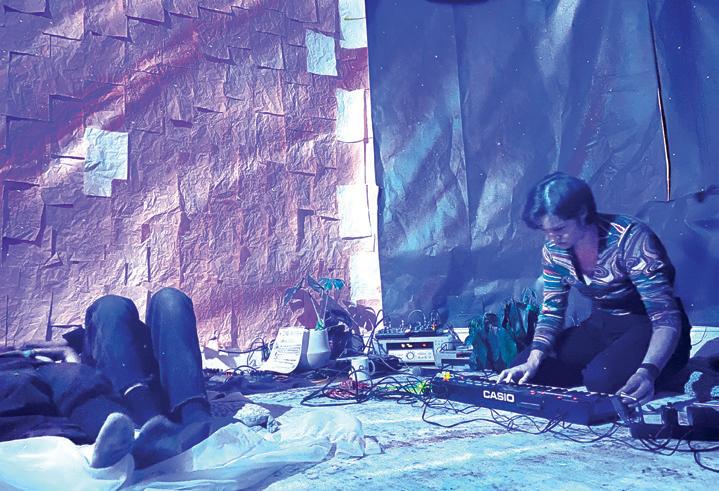
One point of pride for StretchMetal is that it’s all DIY ethics. It seems like a bigger deal because it’s a nonprofit now, but it’s still just me. I set what I think is a reasonable price for everything, but I want more than archetypal electronics bros to perform and come to my events. So whether it’s an application fee or a ticketed event, no one is turned away as a potential artist or participant for lack of funds. Every application and ticket has a button next to it saying, “Send me a fee-waiver or slidingscale request.”
I pay a space-rental fee, and then artists split the door. Right now, artists come into the sleepover knowing that they’re doing it for the love of the night and community. I hope to grow the sleepover, so we can maintain that DIY ethos while being able to offer an artist guarantee up front. I want a healthy music economy, and people are able to sustain their music projects easier when there’s financial backing. We cannot pay our bills with exposure. That’s one reason StretchMetal became a nonprofit: so we can apply for grants and other outside funding, which will hopefully attract a wider range of artists and get them paid.
I’m also taking Drone Sleepover on the road for the first time this year—New York and Seattle, because there are communities who’ve expressed interest and will help. There’s a poll on our website asking, “Where should we go next?” Wherever there’s an ambient community that wants to lend a hand, StretchMetal wants to go. v
THE SECRET HISTORY OF
Playing for years with Ramsey Lewis and Count Basie, exploring funky fusion, running a club, teaching in a university—he did it all and then some.
By STEVE KRAKOWSince 2004 Plastic Crimewave (aka Steve Krakow) has used the Secret History of Chicago Music to shine a light on worthy artists with Chicago ties who’ve been forgotten, underrated, or never noticed in the first place.
I’ve been covering underappreciated artists in the Secret History of Chicago Music for more than 18 years, but as I research a subject, I still sometimes catch myself wondering: “Why is this person not a universally beloved household name?” Cleveland Eaton is just such a case. He was a composer, bandleader, producer, arranger, publisher, teacher, and label owner—and arguably one of the best double bassists who ever lived, with longrunning gigs backing Count Basie and Ramsey Lewis.
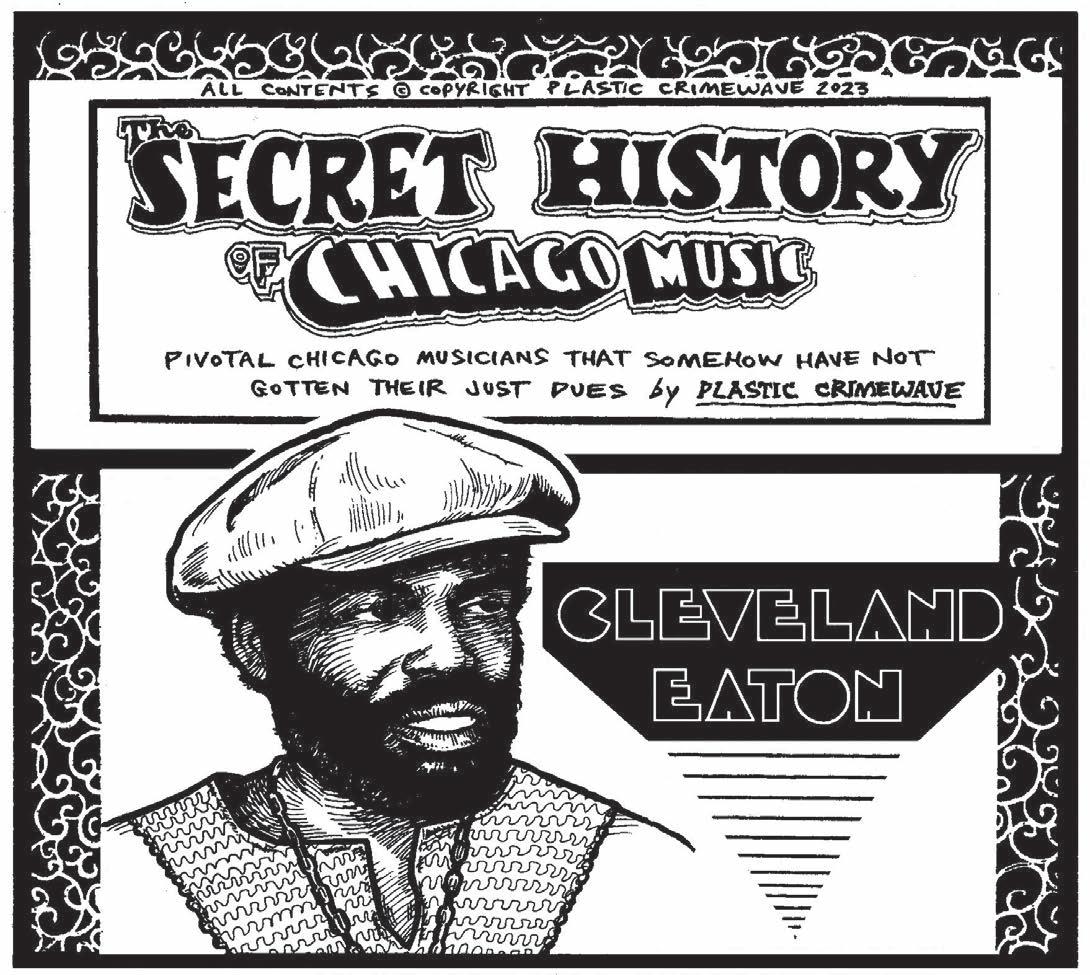
Was Eaton too prolific across too many genres, like fellow bassist Richard Davis, so that no single aspect of his brilliance could seize and hold the public’s attention? Could the problem be that he grooved too hard for fans of the avant-garde but didn’t play conventionally enough for straight-ahead jazz lovers? Were his innovations too subtle or
not su ciently commercial? Do bassists just get short shrift in general? I can’t explain why Eaton isn’t better known, but I can definitely do my part to get his name out there.
Cleveland Josephus Eaton II was born August 31, 1939, in Fairfield, Alabama, part of the Birmingham metropolitan area. He started playing music at age five, and by his teens he was playing his mother’s piano as well as trumpet and saxophone. The local school system was still segregated, so Eaton
attended the all-Black Fairfield Industrial High School, where he spotted a bass case in the car of band teacher John Springer and wondered what might be inside. Eaton would later claim Springer as his greatest influence, and not just because that chance encounter would begin his lifelong odyssey with the double bass.
Eaton was also lucky to study with trumpeter and jazz educator John T. “Fess” Whatley, Birmingham’s answer to legendary Chicago band director Captain Walter Dyett. Both edu-
cators insisted on strict discipline and expected excellence. They could develop novices into professionals—Whatley also mentored the likes of Erskine Hawkins and Herman Blount, aka Sun Ra—and prominent bandleaders of the day often recruited students directly from their classes.
Eaton got his first gig at age 15, backing singer “Lucky” Leon Davis, and won a full music scholarship to Tennessee Agricultural & Industrial State University (now Tennessee








Make time to learn something new with music and dance classes at Old Town School! We offer flexible schedules for all skill levels both in-person and online.
oldtownschool.org












































































































Sign up for classes today at MUSIC CLASSES FOR ADULTS & KIDS
LINCOLN SQUARE LINCOLN PARK

continued from p. 48
State). He played tuba as well as bass and other instruments on his way to a bachelor’s degree.
After graduation in 1960, Eaton spent all of one day back in Alabama before moving to Chicago. He found work as a musician almost at once when Ike Cole, Nat’s older brother, spotted him playing at a hotel lounge in Kenwood.

“I graduated on a Friday, Saturday I stayed home with my family, Sunday I was in my car headed for the Sutherland Hotel where the jam session was at,” Eaton told Birmingham writer, archivist, and music historian Lee Shook for a 2019 B-Metro magazine story. “I was at the jam session playing and Nat King Cole’s brother was there. And he asked me, ‘Man, you ain’t doin’ nothing?’ I said, ‘No.’ He said, ‘Do you want to go on the road with me?’ I said, ‘Yeah.’ So we left Wednesday.”
Eaton toured on and o with Ike Cole for a year and a half. He also worked as a session musician, recorded jingles, and taught music,
both in public schools and as a private tutor. One of his next big gigs was with a quintet fronted by saxophonist Pepper Adams and trumpeter Donald Byrd, which had been touring hard and had already passed through Chicago several times before Eaton came aboard—their local dates included several runs in 1960 and early 1961 at Fred Anderson’s Birdhouse at 1205 N. Dearborn. Eaton was recruited by one of the quintet’s newer members, young pianist Herbie Hancock, and the group fortuitously documented his brief tenure on a stellar June 1961 recording made at Saint Louis club Jorgie’s. It was belatedly released as the 1981 VGM Records LP Jorgie’s Hip-Intertainment Volume One , and in 2012 Solar Records issued the expanded CD version Complete Live at Jorgie’s 1961. Chicago treated Eaton well. In Eaton’s 2020 Jazz Times obituary, pianist Ramsey Lewis testifies to the bassist’s success. “Eaton was really in demand in Chicago,” he’s quoted as telling WIAT-TV in Birmingham. “He was never without a gig.” Shortly one of those gigs
would be with Lewis, in fact—he subbed a few times for bassist Eldee Young in the Ramsey Lewis Trio, even appearing alongside Young (playing cello) on the cut “Jingle Bells” from the trio’s 1964 holiday LP, More Sounds of Christmas
After Young and drummer Redd Holt left Lewis to form Young-Holt Unlimited, Eaton became a regular member of the trio in 1966, alongside future Earth, Wind & Fire star Maurice White on drums. The new lineup scored a major hit that summer with a supremely funky and highly influential take on the traditional gospel tune “Wade in the Water,” initially released by Chicago label Cadet (an imprint of Chess). Eaton stayed with the Lewis trio for a decade, playing on all of its celebrated Cadet releases produced by the great Charles Stepney—among them the lush LPs Maiden Voyage and Mother Nature’s Son, both recorded in 1968.
But if I had to pick favorites from among the many, many albums where Eaton appears, I might say he reached his pinnacle in his final
years with the Lewis trio. On the 1973 album Funky Serenity , joined by underrated drummer Morris Jennings, Eaton romps through the beginnings of jazz fusion. The innovative 1974 LP Sun Goddess features White on drums again (and several other folks from Earth, Wind & Fire, including Philip Bailey), and Eaton displays his versatility on the groovy “Love Song” and the freaky, progressive “Gemini Rising,” where he uses bowed double bass to create pure textures. The album topped the Billboard soul albums chart and earned a gold certification from the RIAA.
Sun Goddess would be Eaton’s last album with Lewis, but by then the bassist had already started his own labels and his own funk-fusion bands. He’d launched the short-lived E&C Records in 1969, followed by Cle-An-Thair Records in the early 70s. The latter released a heap of singles by interesting Chicago-area acts as well as Eaton’s own wide-ranging 1972 LP Half & Half Volume 1 , billed to Cleveland Eaton & the Kats. Philadelphia label Gamble Records (founded by famed songwriting and
production team Kenny Gamble and Leon Huff) reissued it the following year, its title shortened to Half and Half . It was billed to Eaton alone, and its delightfully silly cover portrayed him as a cartoony flying bull.
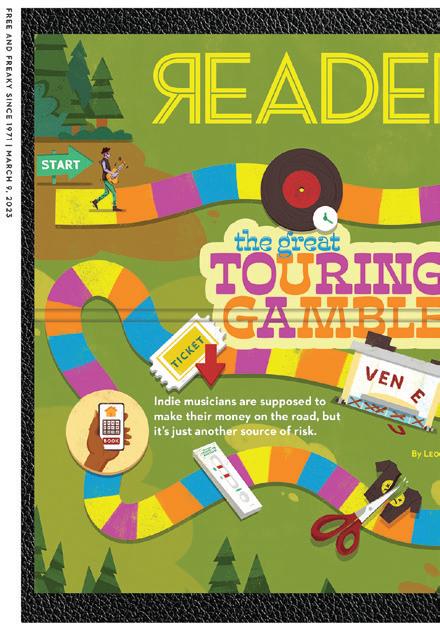
Both versions of Half and Half are sought-after rarities now, thanks to their forward-looking but danceable grooves. Even more coveted are original copies of Eaton’s 1975 LP on the Black Jazz label, Plenty Good Eaton. With Jennings back on drums and the underrated Ed Green on shredding violin (a la Chicago violinist Jerry Goodman in the Mahavishnu Orchestra), the frequently reissued album continues Eaton’s eclectic fusion explorations.


In 1974, Eaton met his future wife, Myra, on a visit to Alabama. She’s a Birmingham native, and in ’75 he moved there to be with her—beginning a relationship that would last till his death 45 years later. She eventually became his manager and booking agent, and he owed much of the success of his solo career to her work.
For several years, Eaton kept one foot in Chicago and the other in Birmingham, and he released two late-70s albums on Ovation that illustrate this neatly. Instant Hip in ’76 and Keep Love Alive in ’79 both feature a band he called the Garden of Eaton, but it was made up of Birmingham players on the first and Chicago players on the second.




In 1978 Eaton reissued the slappin’ disco track “Bama Boogie Woogie” (originally from Instant Hip) via UK-based label Gull Records, better known for releasing records by Arthur Brown and Judas Priest. But soon his career would take a turn toward tradition.
The Count Basie Orchestra o ered Eaton a job in 1979, filling in for a sick bassist for two weeks. “After the two weeks,” Eaton told UAB Magazine in 1997, “he took me aside and said he was cutting the other guy loose, and did I want the job?” Soon Basie would come to call him “the Count’s bassist,” and Eaton would play with the group for 17 years, staying long after its leader’s death in 1984.
Back in Birmingham, Eaton and Myra would open a club called Cleve’s Place in the Ensley neighborhood in 1981, and even though it only lasted three years, it contributed to Eaton’s growing stature as a local hero and scene leader. As far back as the late 60s and early 70s, while he was based in Chicago, he’d been using his record labels to cultivate Magic City artists such as the Soul Controllers and Mary Alice
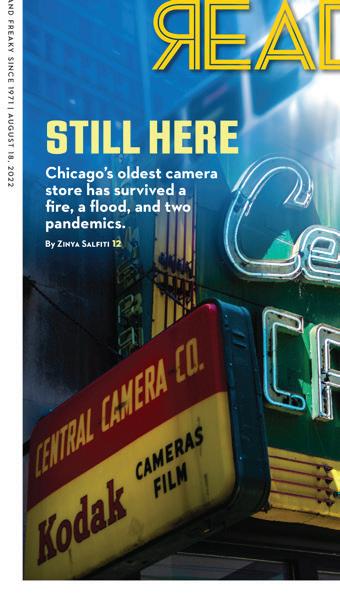

McCall. In 1996, when Eaton stepped away from the Basie Orchestra and its grueling tour schedule, he returned to more formal mentorship by teaching music at the University of Alabama at Birmingham.
Eaton was inducted into the Alabama Jazz Hall of Fame in ’79, and the ceremony was one of the few times he performed with Sun Ra— Eaton looked up to his fellow inductee as a genius, as any adventurous jazz musician should. He was inducted into the Alabama Music Hall of Fame in 2008.
Over the course of his career, Eaton wrote more than 300 tunes and recorded with the likes of Ella Fitzgerald, Dizzy Gillespie, Miles Davis, Frank Sinatra, Sarah Vaughan, Dexter Gordon, Gene Ammons, John Klemmer, the Dells, Minnie Riperton, Jerry Butler, Rotary Connection, George Benson, and Henry Mancini. If you add artists with whom he performed but didn’t record, the list gets even longer, including Nancy Wilson, Sammy Davis Jr., Julie London, Lou Rawls, the Platters, the Temptations, and the Miracles—and even then, it’s much abbreviated.

Eaton beat oral cancer in 2008 and prostate cancer 2010, and later in the 2010s he survived a heart blockage. But on July 5, 2020, he passed away peacefully at home after a period of hospitalization and decline. He left behind three sons and three daughters (two of his eight children predeceased him), nine grandchildren, and nine great-grandchildren.
Eaton’s musical legacy continues to assert itself, though, and in 2020 several reissues honored his life: Real Gone Music revived Plenty Good Eaton yet again, and Kats tracks appeared on two compilations by German label Tramp, Praise Poems 7: A Journey Into Deep, Soulful Jazz & Funk From the 1970s and Movements Vol. 10.





With Myra Eaton’s help, Lee Shook has rescued a trove of Eaton reel-to-reel tapes, DAT recordings, photos, and ephemera. He’s working with Tramp on a double LP of the complete Cle-An-Thair singles, to be released in the U.S. by Birmingham label Earth Libraries—and with any luck, there’s a lot more to come. Here’s hoping Eaton gets the international acclaim he deserves sooner rather than later! v


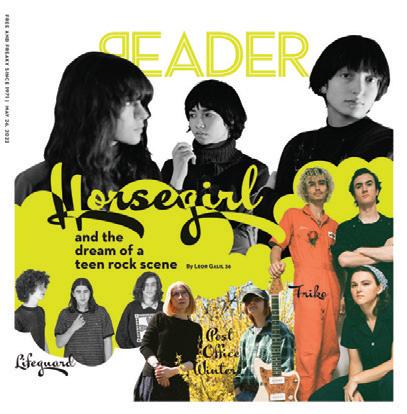
The radio version of the Secret History of Chicago Music airs on Outside the Loop on WGN Radio 720 AM, Saturdays at 5 AM with host Mike Stephen.
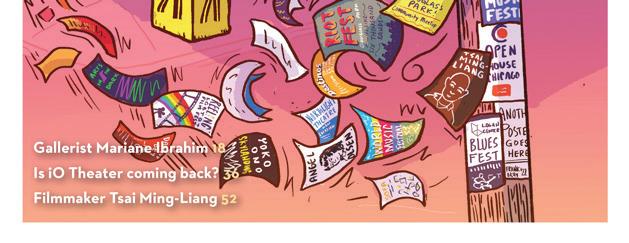







STUCK BECAME ONE of my favorite new Chicago bands during the worst of the pandemic. Their taut, bracing postpunk is exactly the kind of music I love to see played in rooms so cramped that the walls sweat—and that’s exactly the kind of environment I’ve avoided since COVID-19 arrived. I find this irony alternately funny and sad, and it’s exactly the kind of feeling you’d encounter in a song by Stuck. The band play with a screwed-tight precision that seems to propel them forward, cranking up the unease in the lyrics of front man Greg Obis. His alienated holler belies his wry humor, and the absurdities and anxieties he describes feel like they’re always about to boil over in the heat of the band’s performances—you can almost see Beaker freaking out as his Muppet lab experiment erupts in flames. On “Time Out,” a standout from Stuck’s new Freak Frequency (Born Yesterday), Obis flails against the sucking quicksand of social media while racing guitars interlock to quicken the song’s pulse. It all happens as fast as you can get drawn into your worst online bullshit on your least favorite platform. At the same time, the song’s gleeful pace and Obis’s over-the-top enunciation allow listeners to maintain enough emotional distance that they can chuckle about the mess. Stuck pull o this trick over and over throughout the album. Because Obis and company don’t pretend to have a secret fix, the way they skewer our doomed present can help release you from the feeling that you need to have a solution yourself—none of us acting alone can stop corporations from chewing up their workers and keeping all the money. Freak Frequency reminds us that the important thing is to refocus on the things we actually can change. —LEOR GALIL
Brainiac See also Fri 6/2. Lung and Matt Espy open. 9 PM, Empty Bottle, 1035 N. Western, $20, advance tickets sold out. 21+
The story of Brainiac still haunts Ohio indie-rock fans and appreciators of deliriously weird electronic rock and pop. This Dayton band—who loved to annoy zine editors by styling their name 3RA1N1AC—formed in 1992 and released three brilliant, ever-surprising albums that made them feel like a harbinger of subversive, futuristic rock to come. By the time they put out the 1997 EP ElectroShock for President on Touch and Go, they’d been fielding offers from major labels for years and had started work on a full-length for Interscope. But Electro-Shock would turn out to be their last release: in the wee hours of May 23, the band’s charismatic front man, Tim Taylor, died in a fiery onecar crash. It was later determined that he had been overcome with carbon monoxide fumes from his vintage car and was likely dead before the impact. The band’s career was over in an instant.
Or was it? In the decades that followed, Brainiac were gone but never forgotten; their music proved too idiosyncratic to grow dated easily, and the specter of what could have been has given their catalog a posthumous poignance. Guitarist John Schmersal went on to form New York art-rock trio Enon in 1999, and during that band’s run he was approached by indie filmmaker Eric Mahoney about a potential Brainiac documentary. In 2016, Mahoney picked up the project again—as he told the Columbus Dispatch in 2019, he was inspired to revisit the band’s legacy when he realized that the 20th anniversary of Taylor’s death and the 25th anniversary of Brainac’s 1993 debut album, Smack Bunny Baby , were both approaching. The project quickly generated buzz, and superstar fans Mark Hamill and Trent Reznor (who cites Brainiac as an influence) were among those who promoted Mahoney’s Kickstarter campaign and other fundraising efforts. The resulting film, Brainiac: Transmissions After Zero , which premiered at South by Southwest in 2019, assembled a huge list of musicians, family members, and friends who’d known the band in their glory days, and includes footage from a reunion show with the surviving members.
The renewed interest in Brainiac led Schmersal to dig into the band’s archives. In January of this year, Touch and Go released The Predator Nominate , an EP that compiles nine previously un released demos. The songs are short and unfinished, like ghostly outlines of potential not fully fulfilled, but Brainaic’s distinctive personality shines through so brightly that if you close your eyes you can imagine them playing in your living room. The surviving members’ live shows were originally intended to be occasional tributes to Taylor’s legacy, but the group seem to be announcing dates more and more frequently—the schedule of their February UK tour looked like that of a real working band to me. Still, you’d be foolish to take any opportunity to see Brainiac for granted, and you have two this weekend: at the Empty Bottle and on the first day of the Do Division Street Fest.
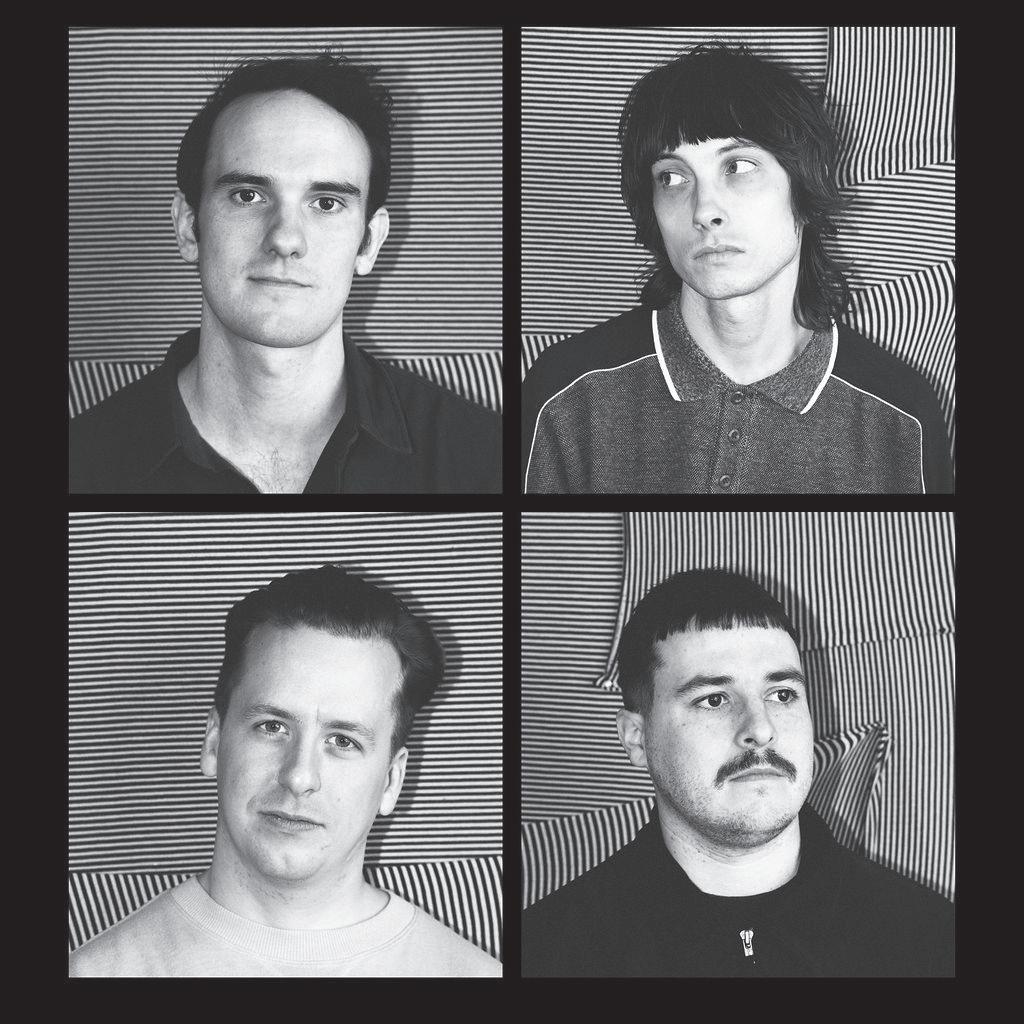 —MONICA KENDRICK
—MONICA KENDRICK
Brainiac See Thu 6/1. Brainiac play the Damen (East) Stage on day one of the Do Division Street Fest. Jesse Royal, W.I.T.C.H., Akasha, Beats y Bateria, and the Cowboys also perform. 7:15 PM (music starts at 5:45 PM), Division between Damen and Leavitt, $10 suggested donation. b
Stuck See Pick of the Week at le . Melkbelly and Spread Joy open. 9:30 PM, Sleeping Village, 3734 W. Belmont, $17.51. 21+
JoVia Armstrong & Eunoia Society
7 PM, Green Line Performing Arts Center, 329 E. Garfield, sold out. b
In 2019, Detroit-born drummer and composer JoVia Armstrong recruited trusted musical collaborators

to support her dissertation research on time-based sound processing (e.g., reverb and delay) at the University of California, Irvine. That contingent became the Eunoia Society, the flexibly rostered ensemble that joined Armstrong on one of 2022’s most gripping debut albums, The Antidote Suite , released by flutist Nicole Mitchell on her Black Earth Music label. Armstrong and Mitchell are colleagues many times over: Armstrong has performed in Mitchell’s Black Earth Ensemble, both women have served on the Association for the Advancement of Creative Musicians’ executive team, and they teach in the same department at the University of Virginia.
On Eunoia’s upcoming second album, Inception (due June 30 via Black Earth), the group morphs into a Detroit all-star combo: bassist Damon Warmack, guitarist Sasha Kashperko, and mainstay violinist Leslie DeShazor. Armstrong leads from behind her custom setup: sitting on and playing a cajón with her right hand, while her le hand and feet stay busy with an array of cymbals, handpercussion instruments, and electronics. While Inception enlists fewer personnel than The Antidote Suite (which features Armstrong, DeShazor, and six guests), the new record o en sounds denser. Where the first album honors Eunoia’s founding spirit of atmospheric experimentation, Inception displays a more distinct sound and identity, etched
out through potent, ground-shifting grooves and knockout solos—including some so striking I paused the audio and replayed them immediately. Armstrong, who lived in Chicago for many years, plays three public gigs before the album’s release: the Eunoia Society’s sold-out June 5 show at the Green Line Performing Arts Center, an open rehearsal at Midnight Tea in the Fine Arts Building on June 4 at 6 PM (to accommodate the overflow from the soldout date), and an outdoor concert at Kenwood Gardens on June 17 at 6 PM with a different group (a trio of Armstrong, saxophonist Isaiah Collier, and guitarist Marco Villarreal). —HANNAH EDGAR
A Joyful Noise: Celebrating the Life of Harrison Bankhead More than 30 musicians pay tribute to Harrison Bankhead, including a bass-and-cello choir and ensembles led by Dee Alexander, James Sanders, Edward Wilkerson, and Ernest Dawkins. 6:45 PM, Constellation, 3111 N. Western. 18+ F
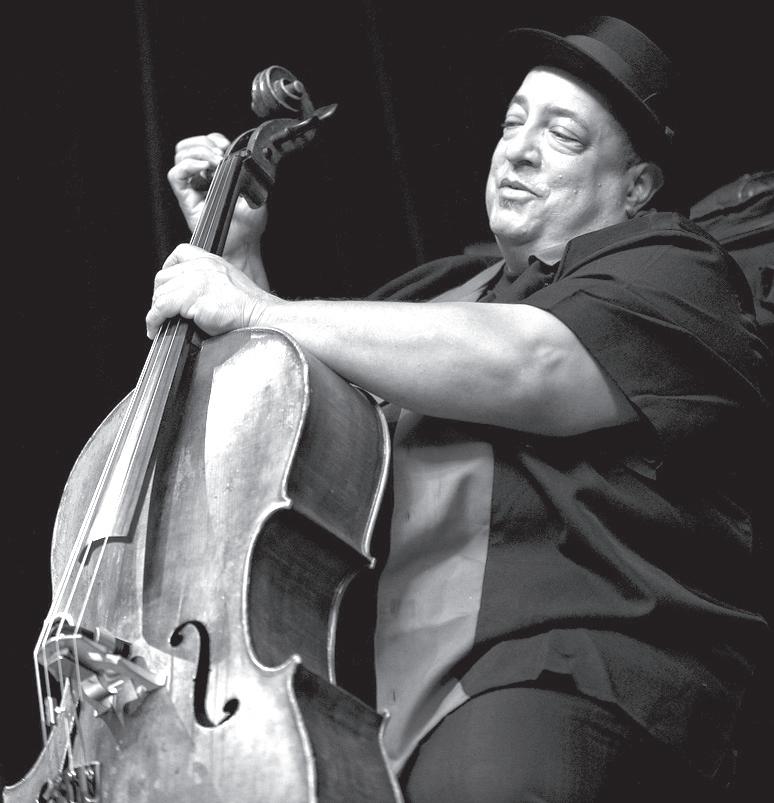
Histories of jazz tend to play up the significance of composers and conceptual innovators who also lead
bands. Harrison Bankhead will not stand in their ranks; during a career that began in the 1970s and lasted until his death in Waukegan on April 5, he only made two albums as a leader. But as a double bassist, he was the kind of player who makes music live and breathe. With its warm tone, unshakable time, and abundant pizzicato and arco technique, his playing helped everyone sound their best— including countless visiting musicians, Chicagobased groups 8 Bold Souls, Frequency, and Indigo Trio, and bandleaders Fred Anderson, Roscoe Mitchell, and Malachi Thompson. Also an accomplished cellist, guitarist, and percussionist, Bankhead could provide the kind of tonal color and timbral embellishment that’s essential to the music radiating from the Association for the Advancement of Creative Musicians, of which he was a member. It’s a testament to the regard he earned from his peers that nearly three dozen of them are expected to participate in A Joyful Noise: Celebrating the Life of Harrison Bankhead. Vocalist Dee Alexander, violinist James Sanders, and woodwinds players Edward Wilkerson Jr. and Ernest Dawkins, all of whom worked closely with Bankhead, have assembled four ensembles to highlight his contributions to their music, and a “choir” of nine bassists and cellists will also honor their departed comrade.
—BILL MEYERcontinued from p. 53
Texas Rubies 5 PM, Hideout, 1354 W. Wabansia, $10. 21+
The Texas Rubies are the great Chicago alt-country phenomenon that wasn’t. Lead vocalist Jane Baxter Miller and guitarist and harmony singer Kelly Kessler were Kentucky transplants who met in Chicago in the early 90s and started writing hardhitting retro-country songs in the tradition of Hazel Dickens and Alice Gerrard. They released one album, Working Girl Blues, on Monsterdisc in 1993 and contributed songs to a couple of Bloodshot compilations. But they never managed to catch hold, and soon disbanded amicably—though by then they’d become sisters-in-law, so they remained in touch.

The Texas Rubies’ lack of commercial success is evidence that meritocracy is a myth. Their music is uniformly excellent. “Someone I Used to Love” (from their debut) is a devastating mid-tempo weeper with serrated high-lonesome harmonies designed to cut your heart out, and their a cappella cover of Jean Ritchie’s “Blue Diamond Mines” (from the 2000 release Down to the Promised Land: 5 Years of Bloodshot Records) somehow manages to be even more chilling than the original. By contrast, “Come On Home” is a great honky-tonk flirtation where a Hank Williams-style yodel holds the promise of another kind of high-pitched vocalizing—if only that wandering man would come back to the lover he’s got waiting in his bed.
Kessler hosted an alt-country series called the
Honky Tonk Living Room at the Hideout from the late 90s through the early 2000s, which makes this Texas Rubies reunion show something of a homecoming. You can expect to feel a lot of welldeserved love for the Texas Rubies in the room as the audience enjoys some of the best country tunes created in Chicago, Kentucky, or anywhere else. —NOAH
BERLATSKYElijah LeFlore Kye Colors headlines; Kayo, Bbypnda, and Elijah LeFlore open. 8 PM, Schubas, 3159 N. Southport. 21+ F

Chicago R&B artist Elijah LeFlore sings with the understated cool of someone who’s found peace and mostly just wants to share that whole-body tranquility with you. In January 2022, he selfreleased his debut full-length, Sunset Radio, where his lilting voice floats among gentle guitars, nimble electronic percussion, and soothing keyboards; he followed that up in October with the EP Midnight Summer , whose retrofuturistic synths and hardedged beats complement LeFlore’s coolheaded persona and subtle vocals. He isn’t a showy singer, and he seems to know that he doesn’t need to push his voice to its limits to make an impression. On the Sunset Radio track “She,” LeFlore half-sings, halfraps atop a watery wah-wah guitar riff and swinging drum loop, and throughout the song he gradually sinks deeper into its relaxed pull, as though he’s stretching out in a hammock. I aspire to feel so at ease this summer. —LEOR
GALILSampa
Great Haviah
Sampa Tembo was born in Zambia and raised in Botswana, but she was living in Australia when she released her breakout second mixtape as Sampa the Great, 2017’s Birds and the Bee9. Sampa’s hiphop career soon took off internationally, and a er COVID-19 spread worldwide, she le Australia for Zambia. The move helped her expand her sound. In September 2022 she released her second studio album, As Above, So Below (reissued by Loma Vista in a deluxe edition last month), which makes explicit connections to her native country’s Zamrock movement of the 1960s and ’70s. On the single “Never Forget,” an echoing, cascading guitar melody reminiscent of a popular southern African genre called kalindula shares space with polished, rumbling bass and svelte electronic percussion, while “Can I Live?”
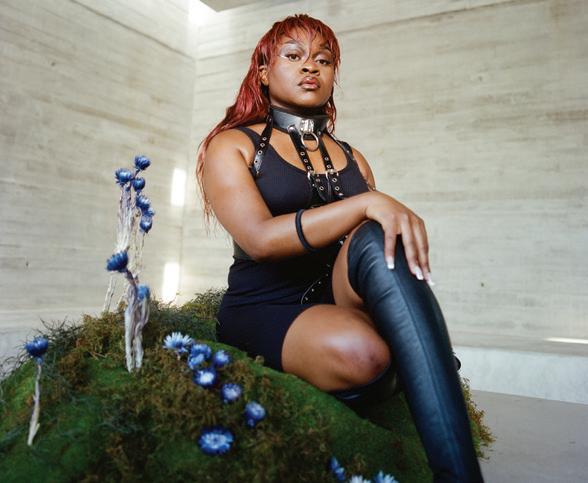
features vocals from Jagari Chanda, original front man for 1970s Zamrock legends W.I.T.C.H. (“We Intend to Cause Havoc”). As Vulture pop critic and Reader contributor Justin Curto noted in an October profile, during Sampa’s exploration of Zamrock history over the past few years, she learned that her uncle George “Groovy Joe” Kunda had been an early member of W.I.T.C.H.
“Never Forget” offers a kind of thesis statement for As Above, So Below . “We often forget the stories of people who have created things, or we o en forget our own stories, because they’re usually rewritten for us,” Sampa told Curto. “African histories are often wiped out.” With this album, Sampa orients contemporary hip-hop history around her own story; she can’t speak for the entire continent, but Sampa’s pop pizzazz invites listeners to venture beyond the familiar and learn more about the musical history she’s eager to share. —LEOR
GALILWhen Canadian producer Jayda Guy, who makes music as Jayda G, was a child, her father began spending hours in a room with a specific goal: to record his life story. William Richard Guy had grown sick, and as his health declined he enlisted the help of Guy’s older sister to compile 11 hours of videotapes filled with anecdotes and stories that he’d never be able to share with his younger daughter in person. Guy was ten when her father passed away, and 24 years later, she’s used his videotapes to pay homage to his life. Her new second album, Guy, is rife with the sort of unassailable house music that could soundtrack pool parties all summer, but just beneath the shimmering production lie her deeply reflective lyrics and samples of her father’s voice. On “Scars,” her vocals soar over blippy synths and hand drums that carry the grooves, but the song belies their peppy bounce with its heavy lyrics— it’s an anthem about personal growth despite pain, partly inspired by the bullying her father endured in his lifetime.
At her best, Guy understands how to weave small narratives into songs while maintaining simple mantras; her tracks feel expansive, but they’re still distilled into pure, relatable emotion. “Blue Lights” and “Circle Back Around,” for example, are about her

SATURDAY, JUNE 3 8PM
Junior Brown In Maurer Hall
SUNDAY, JUNE 4 12PM
Summer Song & Dance Party Family Concert In Szold Hall
SUNDAY, JUNE 4 2 & 5:30 PM
Maxwell Street
Klezmer Band In Maurer Hall
FRIDAY, JUNE 9 8PM
Gary Louris (of the Jayhawks) In Maurer Hall
SUNDAY, JUNE 11 7PM
RIOPY In Maurer Hall
FRIDAY, JUNE 16 7:30PM
Juneteenth Celebration featuring avery r young + de deacon board In Maurer Hall
FRIDAY, JUNE 16 8PM
Martha Wainwright
father’s experiences with poverty and law enforcement, and their melancholy atmospheres cut through by exultant vocals neatly capture his spirit. Ultimately, Guy feels rich because it was made with the understanding that life itself is rich. Guy speaks of her paternal grandmother on “When She Dance,” and its slick funk groove is matched by declarations about Black women’s strength as well as feel-good proclamations to “let your hair down.” Here she marries homage with celebration, and shows how the accomplishments of a single person can ripple out into collective joy. On the light and moody disco track “Meant to Be,” Guy bluntly states, “Right off the bat, I am Black.” It serves as a reminder of the realities she faces as a Black woman, and sets the stage for a song about how her father’s tapes continue to impart wisdom from beyond the grave. Guy concludes the album with “15 Foot,” which features the sort of mournful, reverse-looped vocals that have become characteristic of her work, and in this context they take on new meaning: her father’s presence is here in these songs, and always will be.
—JOSHUA MINSOO KIMkhanate.bandcamp.com/album/to-be-cruel

During their initial run, from 2000 till 2006, New York City’s explosive Khanate helped usher in a new era of experimental heavy metal, setting off an ongoing wave of interest in bands such as Boris,
Om, and Sunn O))) (which Khanate guitarist Stephen O’Malley had founded with Greg Anderson in 1998). But while some of their peers had grooves or riffs that could serve as an accessible entry point, Khanate were for the heads only—their music is incredibly dark and so challenging that it’s probably more apt to call it “grueling.” Composed of O’Malley, drummer Tim Wyskida (also of Blind Idiot God), and vocalist Alan Dubin and bassist- electronicist James Plotkin (both formerly of OLD), Khanate played an achingly slow, astonishingly heavy, meterless brand of esoteric doom metal that focused on volume, negative space, and repetition. The lyrics were equally difficult, exploring terrifying stories and subject matter: torture, death, murder. The track “Fields,” from the 2003 album Things Viral , takes the point of view of a killer begging his victim to tell him what it’s like to die.
Interest in Khanate has grown since their 2006 implosion, and they briefly reconvened in 2009 to release a fourth album, Clean Hands Go Foul (Hydra Head), though a full reunion didn’t pan out at the time. This month Khanate finally reemerged to announce a new album they’ve been secretly gestating since 2016. To Be Cruel (Sacred Bones) is Khanate in top form: punishing sonic misery, layers of atmosphere, bizarre chords and feedback, and Dubin’s spine-chilling howls. Its three tracks last just over an hour, and they are not for the faint of heart. To Be Cruel won’t make you feel good— in fact you might feel kind of icky—but it’s incredibly effective and satisfying, and well worth the wait.
—LUCA CIMARUSTI vwith special guest Andrew Sa In Szold Hall
SATURDAY, JUNE 17 8PM
John Doe Folk Trio In Maurer Hall
THURSDAY, JUNE 22 8PM
Adeem The Artist / Jamie McDell In Szold Hall
FRIDAY, JUNE 23 8PM
Peter Asher & Jeremy Clyde In Maurer Hall
Magic Tuber Stringband, Elijah McLaughlin, Austin Cash 8/3, 8:30 PM, Constellation, 18+
Malik Yusef 8/25, 8 PM, City Winery b
Malinda 9/17, 7:30 PM, City Winery b
Beth McDonald (solo), Beth McDonald Trio with Franki Hand and Isaac Turner, Erez Dessel & Eliya Gwetta Duo 8/17, 8:30 PM, Elastic b Meduza 8/5, 10 PM, Cermak Hall, Radius Chicago, 18+
Meitei 9/26, 8:30 PM, Hideout MSSV 10/2, 8 PM, Subterranean, 17+
Neo Reunion 2023 featuring DJ Suzanne Shelton, DJ Jeff Moyer, DJ Rob Kokot, DJ Glenn Russell, DJ Scary Lady Sarah 7/29, 7:30 PM, Metro Netta 11/19, 7:30 PM, Lincoln Hall b
Notations, Ronnie G, Ms. Val 7/8, 8:30 PM, Epiphany Center for the Arts
AC Slater 8/5, 10 PM, Concord Music Hall, 18+
Aespa 8/30, 8 PM, Rosemont Theatre, Rosemont b
Alabaster DePlume 9/15, 9 PM, Co-Prosperity b
Alabaster DePlume 9/16, 9 PM, Co-Prosperity, 18+
Aleks Syntek, Fehr Rivas 7/15, 8 PM, House of Blues, 17+
Herb Alpert & Lani Hall 9/16, 7:30 PM, the Vic b
Ambar Lucid 10/6, 7:30 PM, Park West, 18+
Anchor, Execution Day, Along Came a Spider 8/9, 7 PM, Cobra Lounge, 17+
Anti-Heros, Noi!se, Fear City, Antagonizers ATL, Liberty and Justice, Fighting for Scraps, Old Salt, and more
11/11, 5 PM, Reggies Rock Club, 18+
Bar Italia 12/10, 9 PM, Empty Bottle
Bell Witch, Spirit Possession
10/20, 9 PM, Sleeping Village
Black Duck (Bill MacKay, Douglas McCombs, Charles Rumback), Michael Zerang (solo), Sam Prekop (solo)
6/30, 9 PM, Hungry Brain
A Boogie Wit da Hoodie, Skizzy Mars 8/5, 11 PM, Metro
Bouquet, Parachute Day, Boundary Waters, Cut Your
Losses 7/23, 8 PM, Burlington
Bradley Zero, Martyn Bootyspoon, CtrlZora 7/15, 10 PM, Smart Bar
Brb 9/17, 8 PM, Chop Shop, 18+
Willi Carlisle 9/15, 8 PM, SPACE, Evanston b
Chosen Few DJs Picnic & Festival featuring Bebe Winans, Lidell Townsell, Kenny Dope, John Morales, Jamie 3:26, Stan Zeff, Lori Branch, and more 7/8, Jackson Park b
Sin, Nile Club, Lunar Moth 7/7, 8 PM, Epiphany Center for the Arts
Slackers, DJ Chuck Wren
11/17-11/18, 8 PM, Reggies Rock Club, 17+
Sonny Falls, Deady, Sunshine, Mister Goblin 8/18, 8 PM, Gman Tavern
Starcrumbs 7/9, 2 PM, Golden Dagger
Statement Piece featuring Jayda G, Madeline, Rika B
7/7, 10 PM, Smart Bar
Sylvan Esso, Sarah Kinsley 8/6, 11 PM, Metro, 18+
Tayls, Pearl Earl, Aunt Kelly

Chromonicci 8/31, 8 PM, Schubas, 18+
Cindy Lee, Freak Heat Waves
8/10, 8:30 PM, Constellation, 18+
Circuitmom & Son featuring DJ Tony Moran, DJ Abel Aguilera 8/12, 9 PM, Aragon Ballroom
Circuitmom & Son featuring DJ Cindel, DJ Iris Muretech
8/13, 9 PM, Aragon Ballroom
Civic 10/12, 9 PM, Empty Bottle
Bruce Cockburn 11/3-11/4, 8 PM, Maurer Hall, Old Town School of Folk Music b
Coffin Prick, Equipment
Pointed Ankh 7/28, 9:30 PM, Hideout
Cuchulain 7/30, 2 PM, Golden Dagger
Cult Fiend, Big Bird, Virgin Mother, Bleached Cross 7/14, 7 PM, Liar’s Club
Danzig, Behemoth 9/17, 7 PM, Aragon Ballroom, 18+
Destroy Lonely, Tiacorine 8/4, 10 PM, Concord Music Hall, 18+
Disaster Kid 7/29, 9 PM, Gman Tavern
D2G, Abstrak Mind, Ty Renée, B. Lilly & SOS, DJ El 7/9, 7 PM, Epiphany Center for the Arts

Eddie Zuko 10/17, 8 PM, Bottom Lounge, 17+
Kurt Elling & Charlie Hunter
12/1, 7 and 9:30 PM, SPACE, Evanston b
Eloise 10/30, 8:30 PM, Thalia Hall, 17+
Fame on Fire, Kingdom
Collapse 9/23, 7 PM, Cobra Lounge b
Chris Farren, Mo Troper 10/7, 8 PM, Beat Kitchen, 17+
Melissa Ferrick 8/23, 8 PM, City Winery b
Fortunate Youth, Dubbest
9/30, 8 PM, Bottom Lounge, 17+
Jeremy Freeze, IE 8/5, 8:30 PM, Hideout
Rhiannon Giddens, Charly Lowry 9/17, 7 PM, Athenaeum Center for Thought and Culture b
Gorgon City 8/6, 10 PM, Cermak Hall, Radius Chicago, 18+
Greta Van Fleet 9/6, 7:30 PM, Allstate Arena, Rosemont b
Stephan Haluska (solo), Lily Finnegan Quartet 7/13, 8:30 PM, Elastic b
Happy Landing 9/30, 8 PM, Schubas, 18+
Niall Horan 7/9/2024, 7:30 PM, Credit Union 1 Amphitheatre, Tinley Park b
Hubris 7/29, 9 PM, Cole’s Bar
Carly Rae Jepsen 8/1, 9 PM, Metro, 18+
Jimmy Brown, Rovv 11/7, 7 PM, Chop Shop b
Danny Kamins (solo), Danny Kamins Trio with Isaiah Spencer 8/24, 8:30 PM, Elastic b
Ken Carson 8/3, 10 PM, Concord Music Hall, 18+
Killmoves, Feels Like Karma, Atheena, Sacred May 7/15, 8 PM, Burlington
Ben Kweller 11/11, 9 PM, Lincoln Hall, 18+
Labretta Suede & the Motel 6, Dyes 6/25, 9 PM, Liar’s Club Lake Effect featuring Ian Pooley, DJ Heather, Andrew Emil 7/8, 10 PM, Smart Bar

Jack Langdon 8/31, 7:30 PM, Comfort Station b
Lastlings, Running Touch 9/23, 10 PM, Chop Shop, 18+
Black Joe Lewis 9/20, 8 PM, Sleeping Village
Llo Llo, Au-Go-Go, Superdime, Modern Dairy 7/29, 7 PM, Burlington
Nick Lowe 11/20, 8 PM, Maurer Hall, Old Town School of Folk Music b
Nick Lowe, Rami Gabriel 11/21, 8 PM, SPACE, Evanston b
Nurko, Midnight Kids 8/12, 10 PM, Concord Music Hall, 18+
Off With Their Heads, Dead Bars, Black Cross Hotel 10/14, 8 PM, Beat Kitchen, 17+
Ossuary, Garoted, Angelust, Blood of the Wolf 6/30, 9 PM, Liar’s Club
Peso Pluma 7/30, 8 PM, Credit Union 1 Amphitheatre, Tinley Park b
Peso Pluma 9/15, 8 PM, Rosemont Theatre, Rosemont b Justin Peters 7/27, 7:30 PM, Comfort Station b Portugal. the Man; Usted Señalemelo 8/4, 11 PM, Metro, 18+
Ariel Posen 12/12, 7 PM, Sleeping Village
Roosevelt 10/27, 8:30 PM, the Vic, 18+
Javier Rosas 7/27, 8 PM, House of Blues, 17+
Samara Joy 10/27, 8 PM, Symphony Center b
Sanctum Dark Music Festival featuring So Moon, Geneva Jacuzzi, Lust for Youth, Buzz Kull, SDH, Debby Friday, Kontravoid, Pelada, Spike Hellis, Madeline Goldstein, Un Hombre Solo, Bestial Mouths, Blood Handsome, Conjunto Primitivo, Panic Priest, Replicant, and more 10/27-10/28, 6 PM, Thalia Hall, 17+
Arman Sangalang Quartet 8/24, 9 PM, Hungry Brain
Tiwa Savage 9/2, 8 PM, House of Blues, 17+ Scowl, Militarie Gun, Big Laugh 10/8, 7 PM, Subterranean b
Anoushka Shankar 10/13, 8 PM, Symphony Center b Siddhartha 10/27, 8 PM, Copernicus Center b
Silver Room Sound System Block Party 7/29-7/30, noon, Oakwood Beach b
7/6, 8 PM, Golden Dagger
This Is the Kit 10/19, 8 PM, Lincoln Hall, 18+
Bryson Tiller 6/24, 8 PM, Radius Chicago b
Vaperror, Sound Market, Eyeclickeye, Fighting Island DJ Equip 7/28, 9 PM, Cole’s Bar
Mike Viola 10/22, 7:30 PM, Schubas
Alan Walker, Telykast 8/6, 10 PM, Radius Chicago, 18+
Wax Motif 8/6, 10 PM, Concord Music Hall, 18+
Woggles 10/14, 8 PM, Reggies Music Joint
Wolfmother 11/29, 8 PM, Thalia Hall, 17+
Rose Wollman 8/20, 8:30 PM, Constellation, 18+
Zand, Madge 9/23, 8 PM, Beat Kitchen, 17+
Fuego 6/30, 8 PM, Avondale Music Hall, canceled
Chicago Farmer & the Fieldnotes, Aaron Kelly 6/16, 8:30 PM, FitzGerald’s, Berwyn
Jitwam, Joe Powers, Leja Hazer 6/18, 8 PM, Sleeping Village
Jupiter & Okwess 6/21, 7:30 PM, Martyrs’
Leezy, Reno Cruz 6/20, 8 PM, Golden Dagger
Rodrigo y Gabriela 6/16, 7:30 PM, Chicago Theatre b
Saneit, YK Diamond, Lindsay Naomi, Dej Monae, Quis J 6/16, 7 PM, the Promontory
Struts 6/23, 8 PM, Riviera Theatre, 18+
TLC, Shaggy, En Vogue, Sean Kingston 6/23, 7 PM, Credit Union 1 Amphitheatre, Tinley Park b v
GOSSIP WOLF HAS been fond of Wild Prairie Vinyl & Vintage since it opened in KStarke’s old spot at 1109 N. Western in late 2017, so it’s no fun to report that co-owners Natasha Rac and Alex Gonzales will permanently close Wild Prairie on Sunday, June 11. Gonzales says the couple have been feeling burned out and talking about closing up for a while. “We just had to tear the Band-Aid off,” he says. “It’s our decision. It’s not about money— it’s time to move on.” Rac and Gonzales have been selling off their vintage stock to local shops, and they’re in talks with several record stores about buying their inventory of 25,000 records. Depending on how those deals shake out, Wild Prairie may hold closing sales, and Gonzales says they’ll host a farewell party. “We’re trying to figure out everything right now,” he says. “It’s literally a day-to-day operation.”
Last month San Francisco label Dark Entries issued Card Short of a Full Deck, a creepy EP from Beau Wanzer and Maoupa Mazzochetti ’s outre dance project, De-Bons-en-Pierre . On the a ernoon of Saturday, June 3, Wanzer celebrates the 12-inch’s arrival by DJing a Signal Records in-store with Ariel Motto, aka Club Music. Since arriving in Chicago in 1996, drummer and percussionist Matt Espy has played with folk-rock legends the Mountain Goats, Dublin singer-songwriter Duke Special, and indie-rock band Atombombpocketknife, among others—and he’s still with oddball local rockers Dead Rider. On Friday, May 19, Espy released his first solo album, Hawksworth , via Drag City , and when Gossip Wolf says it’s for the birds, that’s a compliment! It combines percussion and thoughtful electronics with a wide variety of sampled birdsong—to this wolf it sometimes sounds like the classic exotica of Martin Denny and Les Baxter with a bit of added free-jazz bustle. Espy will celebrate the release when he plays a solo set opening for the reunited Brainiac at the Empty Bottle on Thursday, June 1. —J.R. NELSON AND LEOR GALIL
Got a tip? Tweet @Gossip_Wolf or email gossipwolf@chicagoreader.com.

Sales/Biz Dev Representative-Chicago
Reader Sales representatives sell print, digital, and ad products to local businesses. Sales reps shoudl have 2 years of sales experience OR similar skills, & knowledge of media/advertising products. Ideal candidates will be familiar with CRM software & GSuite. Comp packages vary (full or part time), & include salary, commission, and health benefits. Diverse candidates encouraged to apply. This is an ongoing search. Send a resume to careers@ chicagoreader.com.
Multiple Positions
Uber Technologies, Inc. has multiple positions (various levels/types) open in Chicago, IL for the following. Some positions may telecommute from home. To apply refer to Job ID & email resume to: resumes_uberus@ uber.com. Program Specialist (Job ID: 6744998) Support strategic decision making processes through analytics, data driven approaches, and an operational mindset. $107000 - $131000/yr.
Business Intelligence
GENERAL REAL ESTATE
RENTALS FOR SALE
NON-RESIDENTIAL
PROFESSIONALS & SERVICES
CLEANING RESEARCH COMMUNITY PERSONALS
communication, sign-up and incentive programs. $107000 - $131000/yr.
Senior Business Analyst (Job ID: 6354219) Build framework for analysis behind company-wide decisions relating to operations, process, and optimization. $107000 - $131000/yr.
Vice President, Information Technology Esperanza Health Centers seeks Vice President, Information Technology in Chicago, IL to maximize business intelligence systems, including medical services, operation, billing finance develo ment, population health. Reqs. bachelor’s in comp. sci., comp. engg or rltd; 7 yrs exp. as IT professional or rltd; 5 yrs exp. in managerial role working w/ healthcare data. Exp. must include using data management & analysis tools & creating advanced reports w/ data visualization concepts. E-mail CV to hr@ esperanzachicago.org. Use job code VPIT0523.
strategies to deal with them. Bachelor in Science. 1 year of experience as behavioral health coordinator or technician in behavioral health practice. Res: Autism Behavior Therapy, Inc. shadenkassar@ gmail.com
PUBLIC NOTICE
ADULT SERVICES
Associate (Job ID: 6683868) Build framework for analysis behind company-wide decisions relating to operations, process, and optimization. $88000 - $108000/ yr. Business Analyst (Job ID: 6402333) Build framework for analysis behind company-wide decisions relating to operations, process, and optimization. $88000 - $110000/ yr. Business Analyst, Central Operations (Job ID: 6072587) Drive continuous improvement to Uber Freight’s reliability including customer service, tracking, and security levels by flexing ana lytical muscles to break down the most complex and interesting challenges and opportunities from carrier performance to security incidents to account scorecards.
$88000 - $108000/yr. Sr
Program Manager (Job ID: 6072509) Work closely with Global Head of Experience to drive process, metrics, and tools improvements. $162000 - $198000/yr. Global Program Specialist (Job ID: 6528004) Coordinate, plan, and implement systems-based projects on a global scale for Uber\’s U4B business line. Travel Required: 20% domestic. $107000 - $131000/yr.
Senior Implementation Analyst (Job ID: 6352029) Implement, maintain, and augment integrations for the freight business.
$92500 - $113000/yr.
Business Analyst (Job ID: 6458505) Utilize data to understand carrier behavior and areas for improvement in our carrier
Senior Vertical Strategy Analyst Groupon, Inc. is seeking a Senior Vertical Strategy Analyst in Chicago, IL w/ the following responsibilities: Collect, analyze, & evaluate data to track business performance & important dvlpmnts. 100% telecommuting allowed from anywhere in the U.S. Apply at www.grouponcareers.com by searching keyword R27495
Behavioral Health Coordinator Behavioral Health Coordinator: Lombard IL. Under the direct supervision of the Behavior Health Supervisor, perform general functions as a liaison between primary care provider by participating in all related patient care team meetings, case consultation and clinic huddles. Ensure appropriate delivery of services and coordinating care with in health network and with external entities collaborating on patient care. Provide excellent quality care, positive customer service maintain efficient and safe environment of care and travel between different branch location for excellent customer service. Manager various databases while appropriately documenting patient data and information within the various portals. Knowledge and understating medical and mental health conditions and impact to the patient. Collaborate with health plans, specialists, hospitals, and physicals to ensure complete and total patient care. Take initiative to proactively recognize problems. opportunities and develop appropriate
HR Specialist IYS Ventures, LLC (Orland Park, IL) seeks an HR Specialist. Handle recruitment process; Plan selection matrix for choosing optimum recruitment channel & source. Administer various resource plans & procedures for personnel; assist in dvlpmnt & implementation of personnel policies & procedures; prep & maintain employee handbook & policies & procedures manual. Onboarding/Joining, induction activities for employees. Reqs: MS or foreign equivalent in HR or rltd field. 2+ yrs exp in HR functions. Send resume to CEO – IYS Ventures, LLC, 15416 S. 70th Ct, Orland Park, IL 60462, or Email: rizekmuwafak@ gmail.com.
CHEMICAL ENGINEER
Chicago, IL: Oversee metal finishing chemical processing, product application, research policies & plant operations in mixing, blending and drying using spectrophotometer analysis. MS degree in Chemical Engineering & Knowl of use of computer applns relating to chemical processing, proficiency in Process Dynamics, Instrumentation & use of Spectrophotometer as evidenced by course work/exp. req’d. Send Resume to: Pinakin Patel, President, Techevon LLC., 544 Beacon Knoll Lane, Fort Mill, SC 29708.EOE
Field Service Specialist Anton Paar USA Inc. seeks 1 Field Service Specialist to provide service engg & technical expertise in the calibration, maintenance, & repair of highly complex proprietary measuring & lab instruments; provide on-site technical support to customers on use, operation, maintenance, & specifications on proprietary instruments. Position requires: (i) a bachelor’s, or foreign equiv, in Mechatronics, Mechanical Engg, or a closely related scientific or engg field or the equiv (ii) 2 yrs exp providing engineering support in troubleshooting, repairing, & maintaining highly complex analytical instruments. Employer will accept any suitable combination of
education, training, or experience. Position is located in Vernon Hills, IL. Travel required 90% of the time to provide field service support at customer locations in OH, MI, MO, KY, ID, & IL. Applicants should apply to legal. us@anton-paar.com.
Assistant Professor of Instruction Northwestern University Evanston, IL Teach six courses per year in elementary and advanced Swahili. Oversee weekly language practice session with students. Must have Master’s in Linguistics or a related field. Must be fluent in Swahili. Qualified applicants should email resumes to african-studies@ northwestern.edu and reference code API0523.
Assistant Professor Northwestern University
Department of Economics. Position: Assistant Professor. Teach classes, conduct research (applied microeconomics focus), advise graduate students. Required: PhD in economics, outstanding research record, excellent recommendations, teaching ability. Send CV and 3 reference letters to Director of Finance and Adm. To econ@northwestern. edu. AA/EOE.
Battery Engineer
Battery Engineer: Perform li-ion cell & module discharge/ charge tests, DC internal resistance (HPPC) tests, OCV-SOC tests, entropy tests, calorimetry tests, short-circuit tests, overcharge/over-discharge tests. Send resume to: Beam Global, 2600 S 25th Ave., STE. Z, Broadview, IL 60155. Attn: John Ficarra
Multiple Positions at Levio Consulting Inc.
QA Automation Engineer to work on assignment under supervision of QA Team Lead, use modern Agile s/w dvlpmt methodologies to dvlp, test, integrate & coord co-design, dvlpmt & tstng activities. Req. BS in Comp Sci/Engr or rltd + 6 mos. expr. Must have knowl of object-oriented langs (JAVA pref.); a familiarity w/coding & tstng w/C#, Python & ETL concepts. Must have good understanding of RDBMS & a bkgrnd in web-services tstng.
Java Developer working on assignment to dvlp, create & mdfy s/w to integrate w/external d/b\’s, to implmnt scaleable apps & d/b\’s that spprt biz processes. Req. BS in Comp Sci or rltd + 6 mos. expr. that must
have incl object-oriented langs (Java preferred), coding & tstng exp w/ prgmng langs like C#, or Python, automating ETL programs, writing SQL Queries (Oracle DB preferred) & webservices tstng (RESTFUL APIS/SOAP). Send apps to HR Manager, Levio Consulting Inc., 332 S. Michigan Avenue, Suite 900, Chicago, IL 60604.
DePaul University seeks Lecturers for Chicago, IL location to teach undergrad & grad courses in fine arts incl screenwriting for film & TV. Master\’s in Screenwriting/Film/TV/ related field req d eq s seeking candidates w/ exp in screen writing. Candidates w/diverse cultural competency skills are encouraged to apply. Submit a CV, cover letter, & names of 3 references. Some telecommuting permitted. Send resume to: J. Trinkle, REF: FS, 243 S. Wabash Ave, Chicago, IL 60604
Workday Consulting Senior Associate, Huron Consulting Services LLC, Chicago, IL: Lead 1 or more Workday functional areas/modules to drive completion of tasks, incl. but not limited to: req gathering., solution design, config., testing scenarios, test cases, defect res., go-live & post go-live support. Lead discovery & design sessions w/ clients to doc. their req. & architect solutions w/ in Workday. Partner w/ clients’ functional leaders/stakeholders to understand & drive proc. design, present solutions, & configure based on their bus. reqs. Advise clients on industry stndrds & leading practices. Must have a Bach\’s in Comp. Sc/Management, Bus. Admin., or rel & 3 yrs of exp. w/: (i) Implementing ERP systems; (ii) Implementing workday, oracle, or PeopleSoft systems; (iii) MS Office (Word, Excel, PPT. for documenting req., bus. process flow steps, change requests, new enhancements etc.; (iv) Smartsheet for tracking risks, actions, issues, & decisions throughout the project i.e., RAID items;
(v) ServiceNow tool for logging incidents post go-live & subsequently resolving those issues;
(vi) Utilizing Workday HCM, Recruiting, & Talent & Performance; & (vii) Managing multi. proj. of differing scale & duration. Exp may be gained concurrently. 80% travel to unanticipated worksites throughout North America. Telecommuting allowed when not traveling.
WANT TO ADD A LISTING TO OUR CLASSIFIEDS? Go to classifieds.chicagoreader.com
Individuals may reside anywhere in the U.S. To apply, send resume to: apply@hcg.com.
ANXIETY AND AGORAPHOBIA TREATMENT CENTER, LTD seeks a Staff Psychotherapist in Deerfield, IL. Master’s in Clinical/Counseling Psych., Counselor Educ. or rel.. Must be a LPC in IL or at minimum pass NBCC exam. May be required to work in Chicago, IL office. Mail resume (no calls/ emails) to Attn: HR, 707 Lake Cook Road, Suite 310, Deerfield, Illinois 60015.
Sr. Financial Analyst
Anal. financial stmts. Req. masters in finance/rel. fld.+2 yr exp.Resume:Taos
Global Group Inc, 2167B South China Pl, Chicago, IL60616
Technical Lead StoneX Group Inc. seeks a Technical Lead (Req. 2023-8755) in Chicago, IL to target and implement efficient storage of data and employ fast and reliable access patterns across source systems. Develop full software stack and lead software engineers to meet project goals. Apply online at https://www. stonex.com/careers/ under the US Careers section for the Technical Lead position, Job Req. 2023-8755. EOE.
IT Governance Risk & Compliance Analyst StoneX Group Inc. seeks an IT Governance Risk & Compliance Analyst (Req. 2023-8757) in Chicago, IL to perform vendor risk analysis to ensure vendors have the proper cyber and data protection controls to minimize exposure risk to the firm A ly online at https://www.stonex. com/careers/ under the US Careers section for a IT Governance Risk & Compliance Analyst, Job Req. 2023-8757. EOE.
Business Process Developer StoneX Group Inc. seeks a Business Process Developer (Req. 2023-8763) in Chicago, IL to design, configure, and implement content management and workflow application solutions. Up to 10% domestic travel required. Apply online at https:// www.stonex.com/ careers/ under the US Careers section for Business Process Developer, Job Req. 2023-8763. EOE.
Senior Software Engineer StoneX Group Inc. seeks a Senior Software Engineer (Job Req. ID# 20238752) in Chicago, IL to develop initial software application concept and apply iterative changes based on feedback,
and develop web applications and restful services. Apply online at https://www.stonex. com/careers/ under the US Careers section for the Senior Software Engineer position, Job Req. 2023-8752. EOE.
CCI Manufacturing IL Corporation seeks Manager IT w/bach or for deg equiv in BA or rel fld yrs ex in ob offrd or w/IT infra mgmt & implem at proc mfg co. incl full lifecyc involv in D365 implem as a sole conslt on team; accting & proc mfg; maint & supp QDA sys; & MS Dyn AX 2012 Proc Mfg Prod & Log Cert. Apply to: 15550 Canal Bank Rd, Lemont, IL 60439
Marketing Manager HOTYD LLC is seeking a Marketing Manager to conduct, formulate, and implement appropriate marketing strategies; work with managers to conduct marketing budget planning etc. Position requires a Master’s Degree in Marketing etc. Must have Six Months’ experience as marketing manager etc. Must be proficient with Google analytics etc. Any interested applicants can mail their resume with code HMM23 to: HOTYD LLC., 1217-1219 W Fullerton Ave, Chicago IL 60614.
Operations Manager Operations Manager: Schaumburg IL. Direct, coord activities of transp comp to obtain optimum efficiency in o s to max profits. Plan, develop org policies & goals. Coord marketing, sales, advertising. Comm w/ clients, employees. Resp for marketing. Plan, manage business budget. Analyze financials. Prep docs for accountant. HS. 2 yrs exp. Res: Myashkov Logistics, Inc dba TUS Logistics, tuslogistic@gmail.com
Software Engineer(s) RedMane Technology LLC seeks Software Engineer(s) in Chicago, IL to develop and implement object-oriented n-tier software applications, including web-based applications with Curam software. Telecommuting permitted. Email resume to yourcareer@redmane. com; reference job code D7038-00098. E.O.E
Data Scientist, Finance Sullair seeks Data Scientist, Finance (Chicago, IL). Analyze & help dev, implement & improve fin customer & product line comp sys & sales tools for fin reporting. Support BI Azure SQL platform–downstream mapping, data integrity, etc. May work from home up to 2 days/wk. Must have bachelor’s or equiv in Comp Sci, Info
Sys. or rltd fld & 5 yrs progressive exp as data related analyst; OR in the alt, at least master’s or equiv & 3 yrs exp. as data related analyst. Must have 3 yrs exp w/: data modeling & architecture; data science, database dev, advanced analytics or stats; advanced working SQL knowledge; relational databases, query authoring (SQL); using stat comp language (Python or R) to manipulate data & draw insights from data sets; & using BI dev tools (Power BI or Tableau). Apply at america.sullair.com/en/ careers (ID# R0020157).
Gen’l Mgr: Manage ops of company engaged in installation, engineering, calibration & maintenance of bulk handling/storage equipment & systems for wastewater treatment, air pollution control & industrial apps. Chicago, IL location. Send resume to: Sodimate, Inc., 2950 W Chicago, Ave, Ste 205, Chicago, IL, 60622. Attn: D. Gong.
Digital Marketing Director Digital Marketing Director (Pintas & Mullins, Chicago IL) Oversee market’g campaigns on digital platforms. Must have bachelor’s in market’g, rltd/equiv & 3 yrs exp in market’g & project managem’t. Of 3 yrs, must have 2 yrs digital market’g & campaigns in legal industry, include’g 1) work’g w/ front-end developers, 2) using quantitative methods to optimize market’g campaigns, 3) utiliz’g pivot tables, Google Analytics & Power BI. Domestic travel rqd every 2 months. Travel to Chicago office rqd 1x/ quarter. Remote work permitted throughout U.S. CV to S. Levin sophie@pintas.com
HR Coordinator HR Coordinator: Chicago IL. recruit, screen, interview, or place individuals within organization. Manage job postings, screening, reviewing resumes, interviews, contacting references. Assist manager w/ resolving issues between employees. Maintain & update employe records. Prep & balance period end reports, reconcile issued payroll to bank statements. Resolve payroll discrepancies. Bachelor’s in Business Management or closely related. 2 yrs exp in any HR related position. Res: India House Restaurant LLC; jjayara1@gmail.com
Social Media Engagement Associate
The nonprofit Reader Institute for Community Journalism, Inc. (RICJ), publisher of the 51-yearold Chicago Reader, is seeking a Social Media Engagement Associate.
This role is responsible for creating, developing, and executing strategies to engage audiences across all social media and other relevant platforms. Requirements and skills Minimum 1-2 years of experience at a digital media outlet, PR agency, or in a social media role; the most important qualification is the drive and ability to engage readers, execute new ideas, follow and maintain benchmarks and requirements regarding frequency and accuracy, and generate results.Solid copywriting and editing skills and experience. Annual salary is $44,000 to $46,000, based on experience. This is a union position. Chicago Reader editorial staff are members of the NewsGuild/ Communication Workers of America Local 34071. To see the full job description and apply, go to chicagoreader. com/reader/careers/
Assistant Professor
Loyola University Chicago is seeking an Assistant Professor in Chicago, IL to teach two Philosophy classes per semester. Please send res to jscott6@luc.
edu & ref job 042975
Sr. Product Security Engineer Baxter Healthcare Corporation is seeking a Sr. Product Security Engineer in Deerfield, IL to Perform penetration testing and vulnerability scanning on different embedded medical device, IoT Devices, computer applications, and middleware software; Find Critical to Informative vulnerabilities and report them to the product team. 100% remote position. Can live anywhere in the U.S. Full time. $96,000 – $144,000 per year.
Qualified applicants can apply directly to the Baxter Website at: www.Baxter.com. Please search \”Keyword\” using job #JR-100628. EOE
Sr Business Intelligence Analysis Developer Baxter Healthcare Corporation is seeking a Sr Business Intelligence Analysis Developer in Deerfield, IL to collaborate with business partners to create sustainable and scalable solutions that transform data into value-driven data insights, aligned with strategic priorities as defined by business requirements; Provide guidance to the analytics community to ensure best practices are consistently used across a variety of analytical toolsets. 100% telecommuting. Can live anywhere in the U.S. Full time. $110,344 – $144,000 per year. Qualified applicants
can apply directly to the Baxter Website at: www.Baxter.com. Please search \”Keyword\” using job # JR-100624. EOE
Assistant Professor
Loyola University Chicago is seeking an Assistant Professor in Chicago, IL to design & teach undergraduate & graduate courses in applied economics, e.g., environmental economics, ecological economics, public economics. Please send res to ntuchma@luc. edu & ref job 100776.
Strategic Sourcing Managers Northwestern Memorial Healthcare seeks Strategic Sourcing Managers for Chicago, IL location to oversee the clinical procurement portfolio. Bachelor’s in Supply Chain/Healthcare Mgmt/ Nursing/related healthcare fields +3yrs exp req’d. Req’d: 3yrs in academic med center w/ Op Room or nursing exp. Edu/exp: Financial analysis & quant & qual assessment data; Excel: Pivot tables, VLOOKUP; Cost benefit analysis; consulting/ group presentation exp. Apply online: http:// jobseeker.nm.org/
Req ID: REF51498B



Physics and Technology Teacher Lycee Francais de Chicago seeks Physics and Technology Teacher in Chicago, IL to teach high school students in rigorous bilingual French and English program. Reqs bachelor’s in education, physics, engineering, computer science or related & 2 yrs exp. teaching physics at secondary level. Must speak, read & write French fluently at native or near-native level. Send CV to hrcareers@ lyceechicago.org. Use job code PTT0623.
Computer User Support Specialists FT. Orozco Trucking Inc, Elk Grove Village, Chicago, IL. Annual salary $45,000.00. Associate deg. in comp. technician is req\’d, no exp. no training.
Email your resume to orozco1830trucking@ gmail.com
Aquatic Group is seeking a Software Engineer in Chicago, IL. Research, design and develop computer software or specialized programs. May work from home 1 day per week. Must live within commuting distance of office. Email resume to HR@Aquatic.com and reference code 50765 in subject line

Have you had an unwanted sexual experience since age 18? Did you tell someone in your
life about it who is also willing to participate?
Women ages 18+ who have someone else in their life they told about their experience also willing to participate will be paid to complete a confidential online research survey for the Women’s Dyadic Support Study. Contact Dr. Sarah Ullman of the University of Illinois at Chicago, Criminology, Law, & Justice Department at ForWomen@ uic.edu, 312-996-5508. Protocol #2021-0019
Texas Warehouse
11,000 SQ FT Half Acre Concrete Lot Fenced
10 Bays 972-891-1576 Industrial Shop Dallas, Texas. $ten million. Warehouseftw.com John 972-891-1576 Logistics-distribution Automotive Recycling Parking Fulfillment Assembly
CLEANING SERVICES
CHESTNUT ORGANIZING AND CLEANING SERVICES: especially for people who need an organizing service because of depression, elderly, physical or mental challenges or other causes for your home’s clutter, disorganization, dysfunction, etc. We can organize for the downsizing of your current possessions to more easily move into a smaller home. With your help, we can help to organize your move. We can organize and clean for the deceased in lieu of having the bereaved needing to do the preparation to sell or rent the deceased’s home. We are absolutely not judgmental; we’ve seen and done “worse” than your job assignment. With your help, can we please help you? Chestnut Cleaning Service: 312-332-5575. www. ChestnutCleaning.com
All romantic dates women wanted All romantic fun dates all requests 24.7 Call (773) 977-8862 swm
MJM 52 SEEKS JEWISH FEMALE MJM 52 SEEKS JEWISH FEMALE PLAYMATE LIKES WINE ANTIQUES HOT OIL MASSAGES BONDAGE SPANKING ORAL PLEASURE WEEKENDS -224-292-9899.
MJM DOM 52 SEEKS SUB MJF MJM DOM 52 SEEKS SUBMISSIVE MJF AND WILL TRAIN BONDAGE ORAL PLEASURE SPANKING AND PUNISHMENT CAN HOST-224-292-9899.
Free audition notices! The Chicago Reader is offering free auditions in our classifieds through Aug. 1. Create an account and your listing at chicagoreader.com/ auditions
ANNUAL ANTIQUE
PHONOGRAPH AND RECORD SHOW & SALE Don’t miss the 2nd annual MIDWEST MUSIC EXPO Sat / Sun June 17 - 18 at the Hyatt Regency Schaumburg. Hours Sat 10 - 4 and Sunday 9 - 3. Free admission on Sunday. See more at www.AntiquePhono.net/ MME-EXPO) and right.

Free audition notices!
The Chicago Reader is offering free auditions in our classifieds through Aug. 1. Create an account and your listing at chicagoreader.com/ auditions
Notice of Public Sale of Personal Property
Notice is hereby given that pursuant to Section 4 of the Self-StorageFacility Act, State of Illinois, Chicago Northside Storage - Lakeview/Western Ave Storage LLC will conduct sale(s) atwww.storagetreasures.com by com-
petitive bidding starting on June 8th and ending on June 15th @ 12:00 pm on the premises where theproperty has been stored, which are located at Chicago NorthsideStorage 2946 N Western Ave. Chicago, IL 60618. 773305-4000. In thematter of the personal property of the individual listedbelow, Chicago Northside Storage - Lakeview. Enrique Williams Jr. J11&J16, Danny Diaz K29, Dora Doykova K07, Horatiu Rares Petras O19, Robert Eskra O21.Purchases must be made with cash only and paid at the time of saleredemption. All goods are sold as is and must be removed at the timeof purchase. The sale is subject to adjournment.
Danielle’s Lip Service, Erotic Phone Chat. 24/7. Must be 21+. Credit/ Debit Cards Accepted. All Fetishes and Fantasies Are Welcomed. Personal, Private and Discrete. 773-935-4995
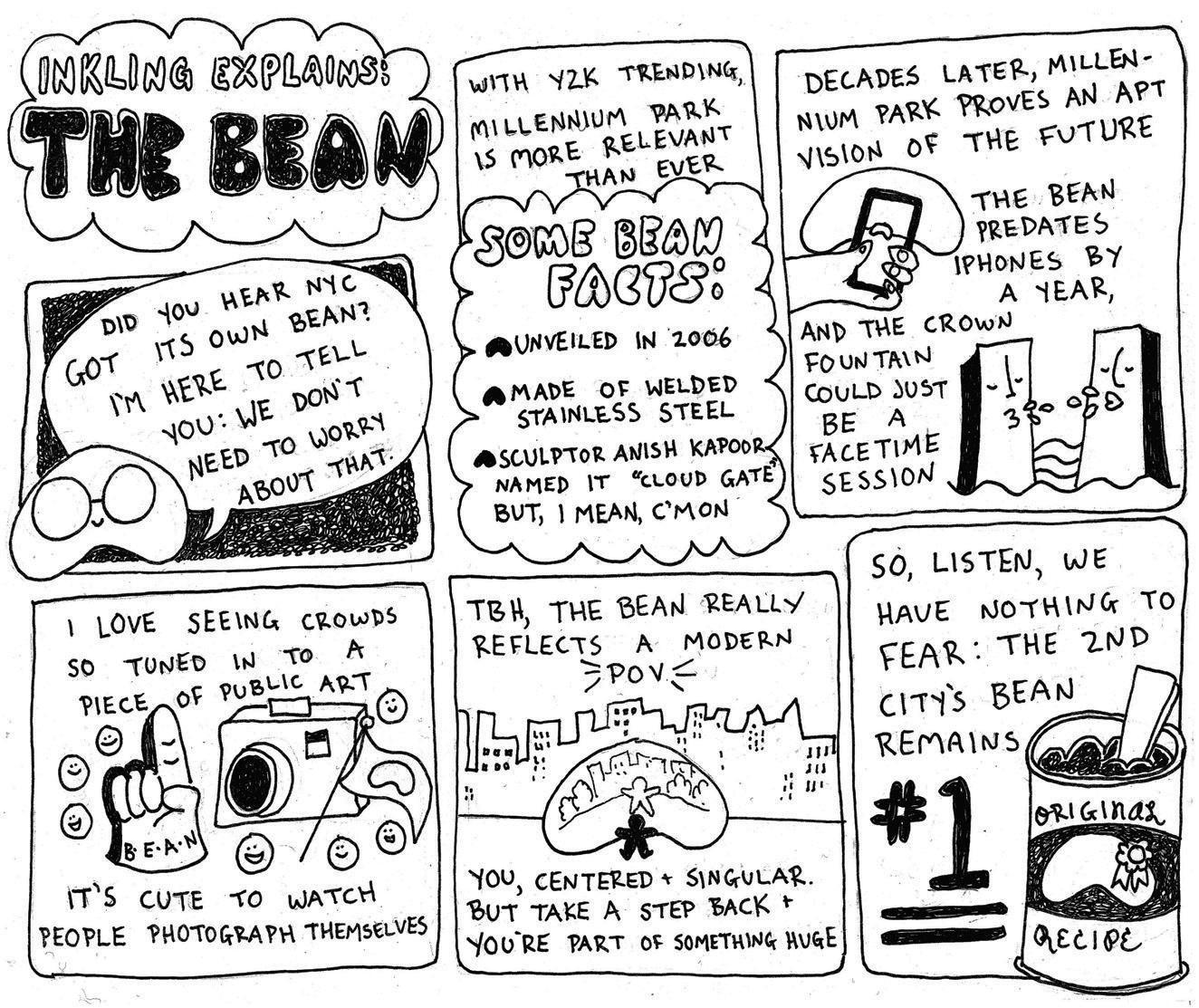 A COMIC BY MEGAN KIRBY
A COMIC BY MEGAN KIRBY


Should I continue pretending to be straight and keep my followers in the dark?
By DAN SAVAGEContent note: this article contains descriptions of castration and cannibalism.
Q : I’ve had a successful career as an artist and thousands follow my professional accounts on social media. My followers think they know me, but I am living a secret double life. What I’ve kept hidden is that I’m bisexual. I have hidden this fact from everyone: from my
followers, from my family, and from the three ladies who married me believing I was the straight guy I pretended to be. All my marriages failed, ending in divorce with no children produced (thank God), and my ex-wives all went on to find real men who could father their children.
In 2016, knowing my success and investments meant I could live comfortably for the rest of my life, I quit my career in the arts and fulfilled a lifelong dream of
becoming a hard-core gay porn slut. (“Slut” fits me much more closely than does “actor,” since what I do on camera is not an “act.”) I truly love the hot sex I’ve had with alpha males in the 250-ish videos I’ve starred in so far. Truly, my only regret is not doing porn much sooner in my life, as I’m happier now than I’ve ever been. Question: Should I continue pretending to be straight and keep the people who still follow me on Facebook and Instagram in the dark?

Or should they be advised to google my full and actual birth name and the word “porn” so they can see the real me? (My full legal name and my professional name— as both an artist and porn slut—are the same.) I don’t want anyone’s life to be negatively impacted should it become known they follow a person who appears in hardcore porn and does things most people would regard as offensive and grotesque. It seems best that followers who are interested in my art be advised to google me so they are aware of what I am doing now and can unfollow me if they wish.
If you want to include my full legal name in your column, I’ll most likely say yes. And please feel free to give hell because I understand the things I let men do to me are vile and disgusting.—[FULL LEGAL NAME REDACTED]
a: I have no desire to publish your name. But rest assured, FLNR, that I fell for it. I googled your name and the word “porn,” I was negatively impacted, and I will always regret it. (Gotta work on my impulse control.) The porn
you’re making is, as confessed/boasted, vile and disgusting and grotesque and offensive. It’s also not illegal and can be enjoyed by consenting adults . . . who hopefully floss, brush their teeth, use mouthwash, and don’t kiss their mothers with those mouths. (Relieved I don’t have to alert the authorities. The health department, on the other hand . . .)
Look, I know what you’re trying to do here. You choose to porn under your own name, the same name you used as an artist—your legal name, your professional name, your porn name— because the thought of being exposed and ruined turns you on. Almost as much as the thought of ruining someone else’s day by tricking them into taking a look at your work. (I only saw the titles, FLNR, but that was enough.) But what you want most is to be exposed and destroyed—that’s your ultimate fantasy—and you’ve been fantasizing about the moment you’re found out and destroyed since you posted your first video.
And here you are, 250 videos later, and no one who follows you—no one who has admired or collected your
work—has stumbled over your vast archive of vile and disgusting and grotesque and offensive porn. Maybe if your pornographic output was a little more mainstream, maybe if yours was a taste shared by more than a tiny handful of people, you would’ve been found out and destroyed already. But the porn you make is so niche— and so vile and so disgusting, etc., etc.—that not one of your followers has stumbled over it. Or stepped in it. And even if one had, FLNR, he couldn’t jump into a comments thread on your Instagram to tell on you without also telling on himself.
So, now you want me to do your dirty work for you. You want me to inflict you on my readers in the hope it’ll get back to your followers . . . and I’m not gonna do that to my readers.
Or to you.
And I don’t think you would want me to, FLNR, if you thought about it more during your refractory periods. As things stand now, FLNR, you get to enjoy the dread of discovery and destruction every day. You get to enjoy your perfect fantasies about the shitstorm coming for you when the inevitable hap-
pens—or what you thought was inevitable, 250 videos ago—and your life and reputation and artistic legacy are all destroyed in a moment. But like Bernd Brandes, a German man whose ultimate fantasy was to be murdered by a cannibal after first having his own penis cut off, cooked, and served to him, you may find reality falls short of your fantasies. In Brandes’s case, the cannibal he met online, Armin Meiwes, wasn’t a very good cook. Meiwes overcooked Brandes’s penis, which wound up being too tough to eat, and since Brandes didn’t have another penis, a do-over wasn’t possible. He died disappointed. Just like Brandes had only one dick, you have only one life. There will no do-overs for you either. So, you’re better off as you are now—enjoying your perfect fantasy of your destruction rather than enduring the sure-to-be-aletdown reality.
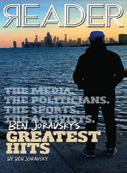

P.S. Your kinks are just as vile and disgusting and grotesque and offensive as advertised—but I’m not going to give you hell about them.

First, because no one chooses their kinks and, second, because the disgust is obviously part of the turn-on for you and I’m not here to cup your balls. (And to be clear, bisexuality isn’t the kink we’re talking about.) If you want to warn people to unfollow and/ or deacquisition your work to avoid being smeared by association, you can do that without suggesting they google your name and porn. You pretend to be motivated by concern for your followers, FLNR, but I’m not swallowing that shit.
Q: I’ve been with my boyfriend since COVID. We were sexually incompatible from the start (both bottoms), but made it work due to the pandemic. Then I blinked and three years passed. We live together and I love him. But it just















feels like a comfortable nice life as opposed to being “in love.” And we never had that hot passionate stage start to fall back on or feel nostalgic about. I wonder if the end of the pandemic means it’s time to move on. I’m 41 years old and feel life can offer more. Am I being shortsighted in wanting more?—SOMEWHAT UNFULFILLED BOTTOM
a: Two bottoms can have hot and passionate sex. I mean, are there no doubleended dildos in Gilead? Are there no tops in your vicinity, single and coupled, willing to guest star? Are oral sex and/ or mutual masturbation not a good time?


Look, finding someone you love and enjoy living with isn’t easy, SUB, so you owe it to yourself to give this relationship a chance. I get it, I get it: you’ve been together for three years, you’ve already given this relationship a chance. But it doesn’t sound like you’ve given radical honesty a chance. (“We have to fix this or it’s over.”) You don’t want to wake up five years from now in a no-longer-new relationship with someone you don’t love. Even if you had managed to have a lot of hot sex with that person at the start, SUB, nostalgia for great sex with someone you don’t love (as much or at all) is unlikely to sustain you through the decades between the NRE wearing off and death. Whereas making space in the loving relationship you’re already in, space for passionate sexual experiences together and/or with others, could be all the sustenance you need. It’s fine to want more, SUB, but before seeking more from someone else, ask for more from the someone you’ve already got. v


Ask your burning questions, listen to podcasts, read full columns, and more at https://savage.love @fakedansavage













